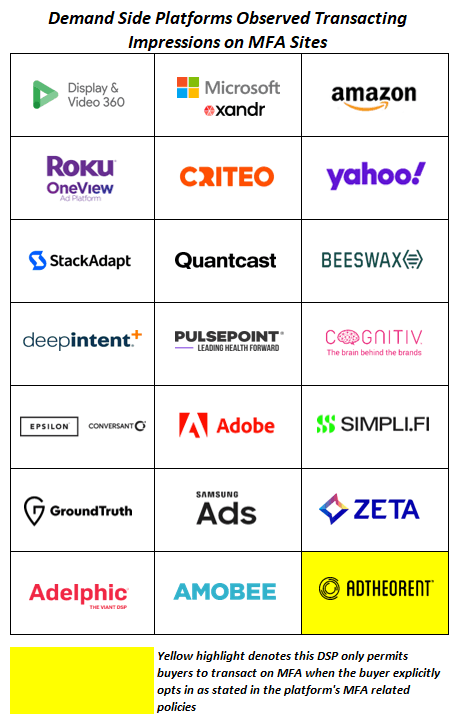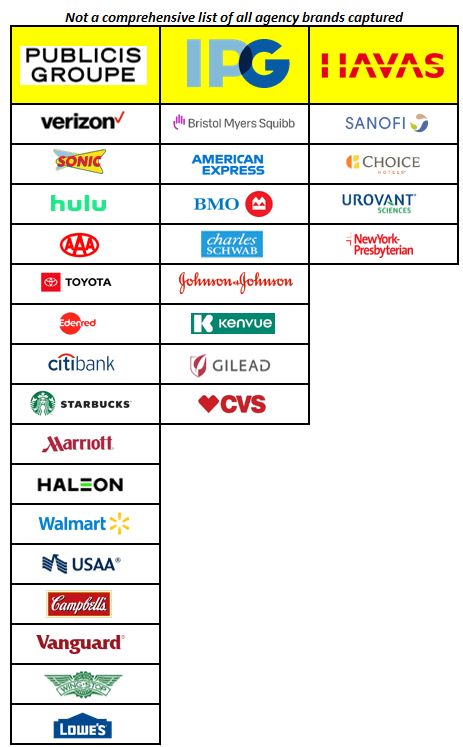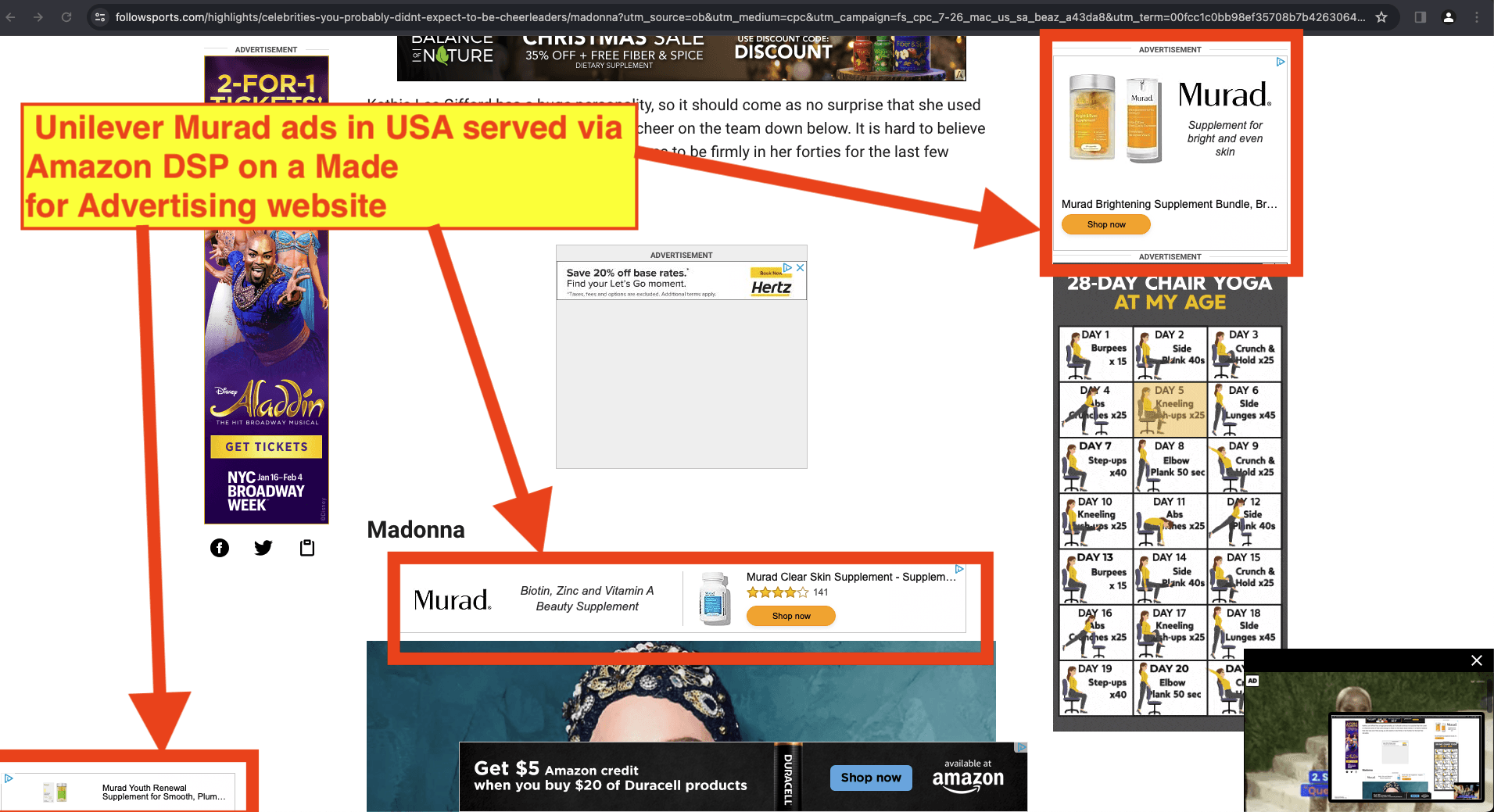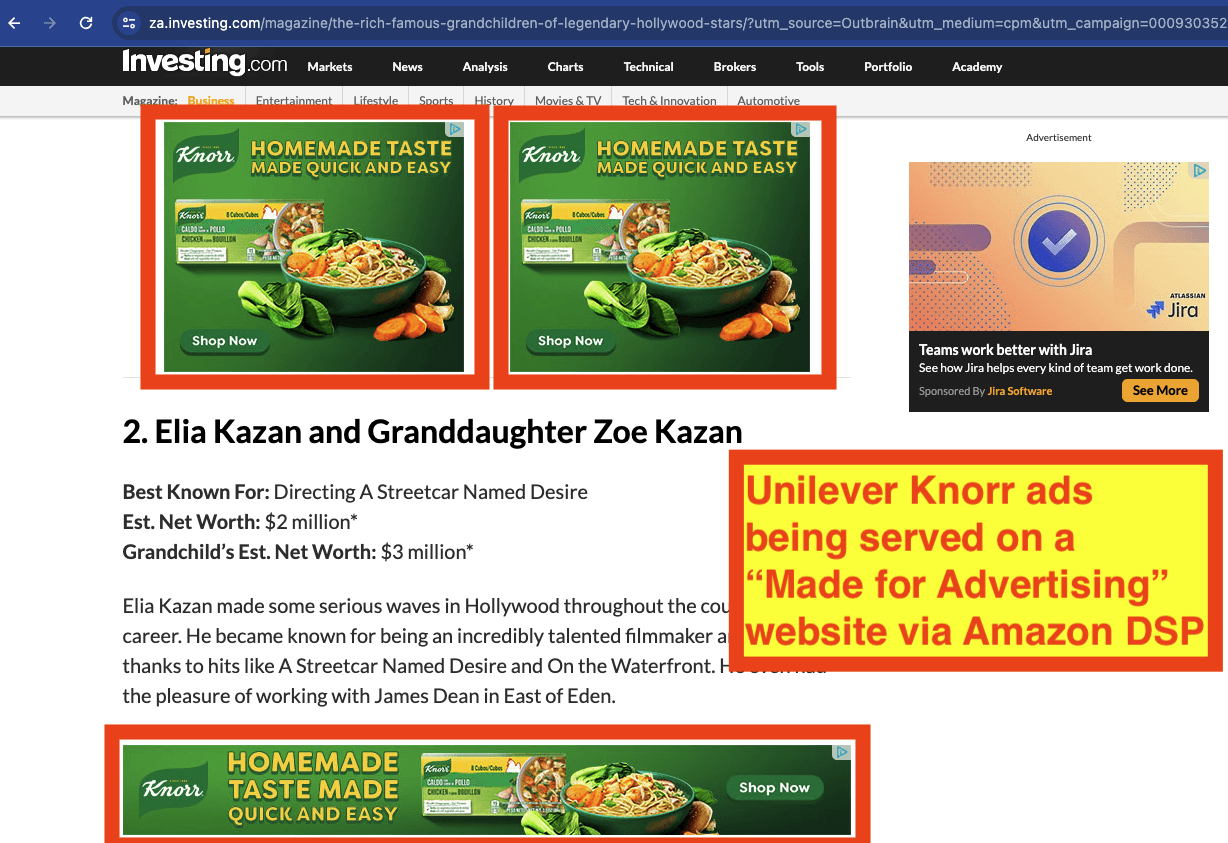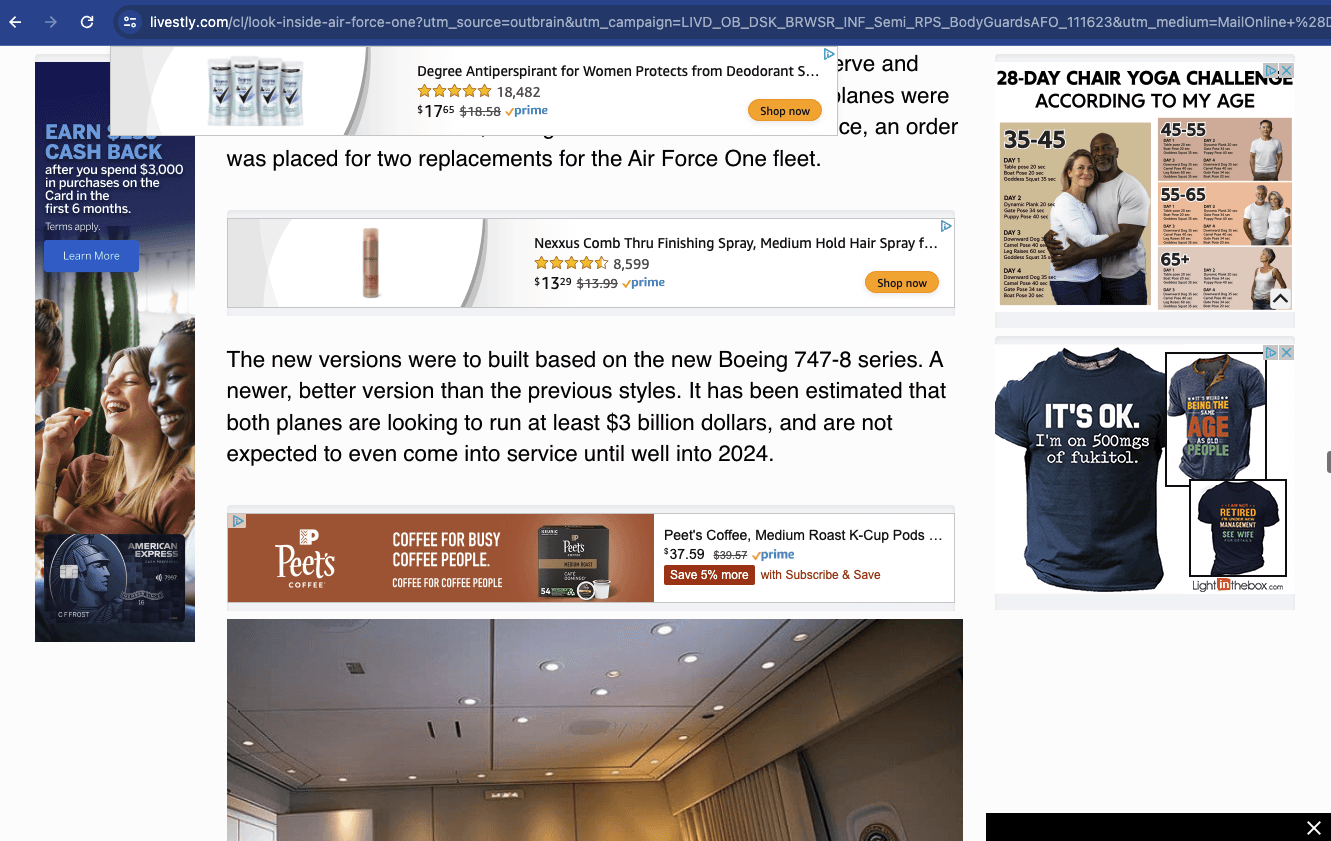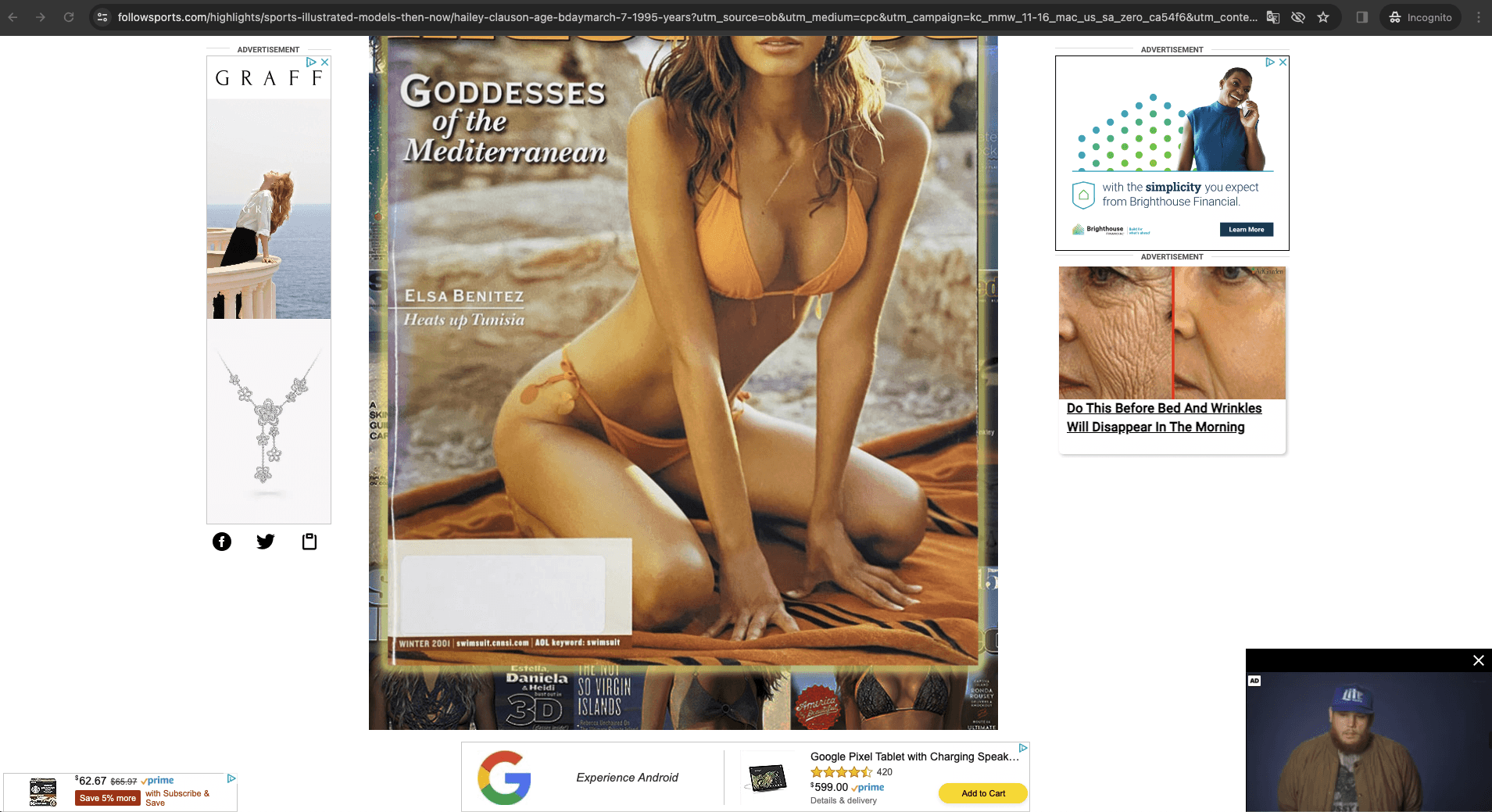Introduction
Over the last few months, Adalytics assisted a Fortune 500 advertiser to analyze the efficiency and efficacy of their ad spend. The Global Head of Media thought their brand was minimally exposed to “Made for Advertising” (MFA) inventory in the second half of 2023. This reflects a general sentiment throughout the industry about MFA exposure, following numerous highly-publicized statements from ad tech vendors and agencies touting their work to block MFA sites and eliminate brands’ exposure to these sites. Adalytics conducted an analysis on behalf of the aforementioned Fortune 500 brand. Adalytics found the brand spent over $10 million on MFA websites through a comprehensive analysis of their programmatic, private marketplace, direct buy, social media, and retail media investments.
Advertising industry trade groups consensus defines Made for Advertising (MFA) websites as sites that are created primarily for the purpose of arbitrage. These websites typically feature low-quality content with a much higher density of ad placements as depicted in the three figures below. Many companies are under the impression that their ad dollars are protected from being spent on MFA sites. Adalytics observed several other large brands spending substantial amounts on MFA sites, and decided to investigate the extent of this phenomenon and the various avenues through which Fortune 500 brands’ ads can be served on “Made for Advertising” websites— both programmatic and non-programmatic.
This study found that hundreds of major brands continue to have their ads served on websites that meet the industry trade group definition of “Made for Advertising.” The ads were placed both through programmatic and non-programmatic channels.
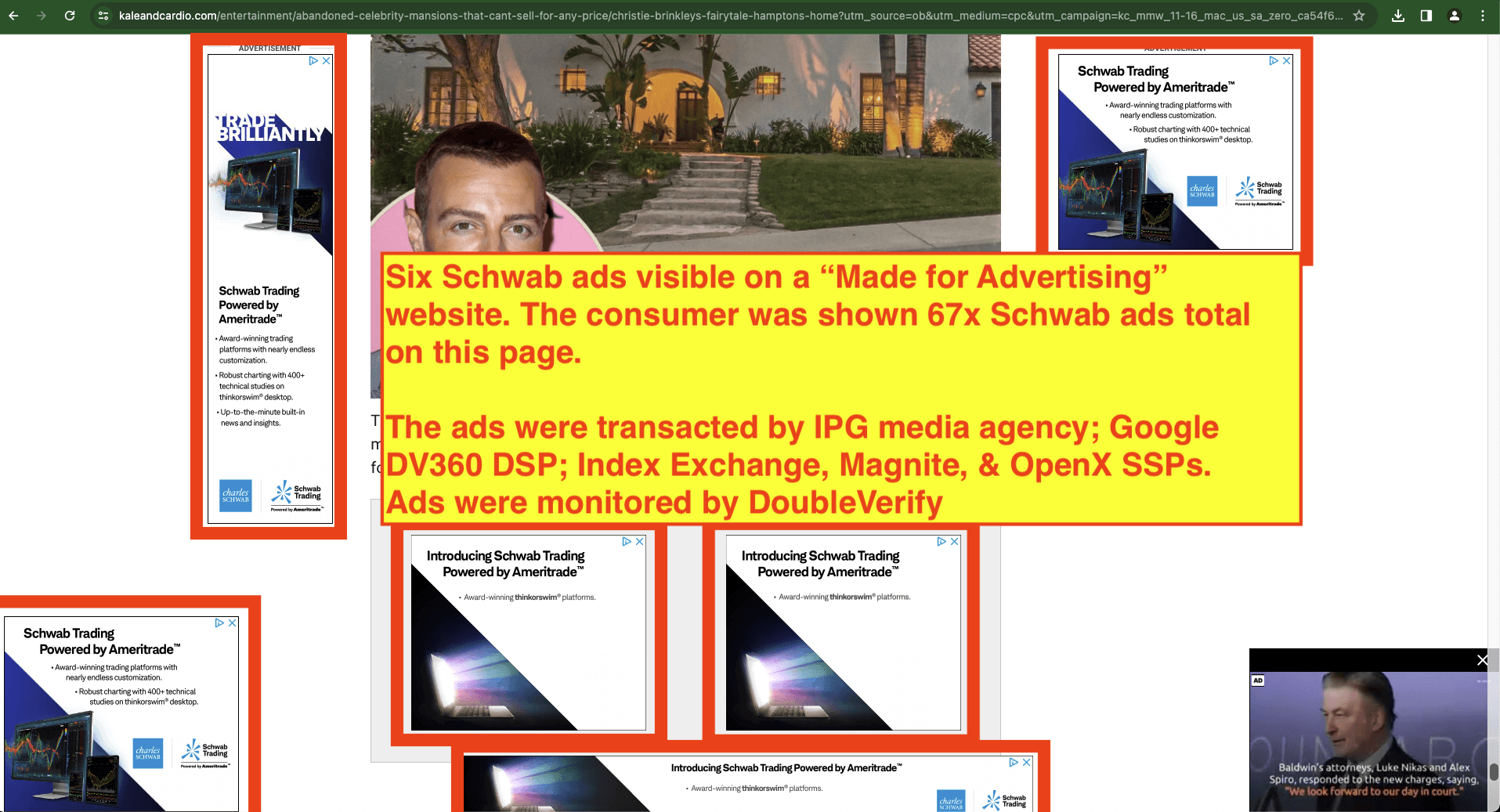
Screenshot of six Charles Schwab ads served on a website which meets the ANA’s, WFA’s, ISBA’s, 4A’s, and DeepSee.io’s definition of “Made for Advertising” website. The ads were transacted by IPG media agency, using Google DV360 DSP, multiple ad exchanges (OpenX, Magnite, Index Exchange), and were monitored by DoubleVerify. The consumer was shown 67x total Schwab ads on this one page in less than 10 minutes, in addition to ads for dozens of other brands.
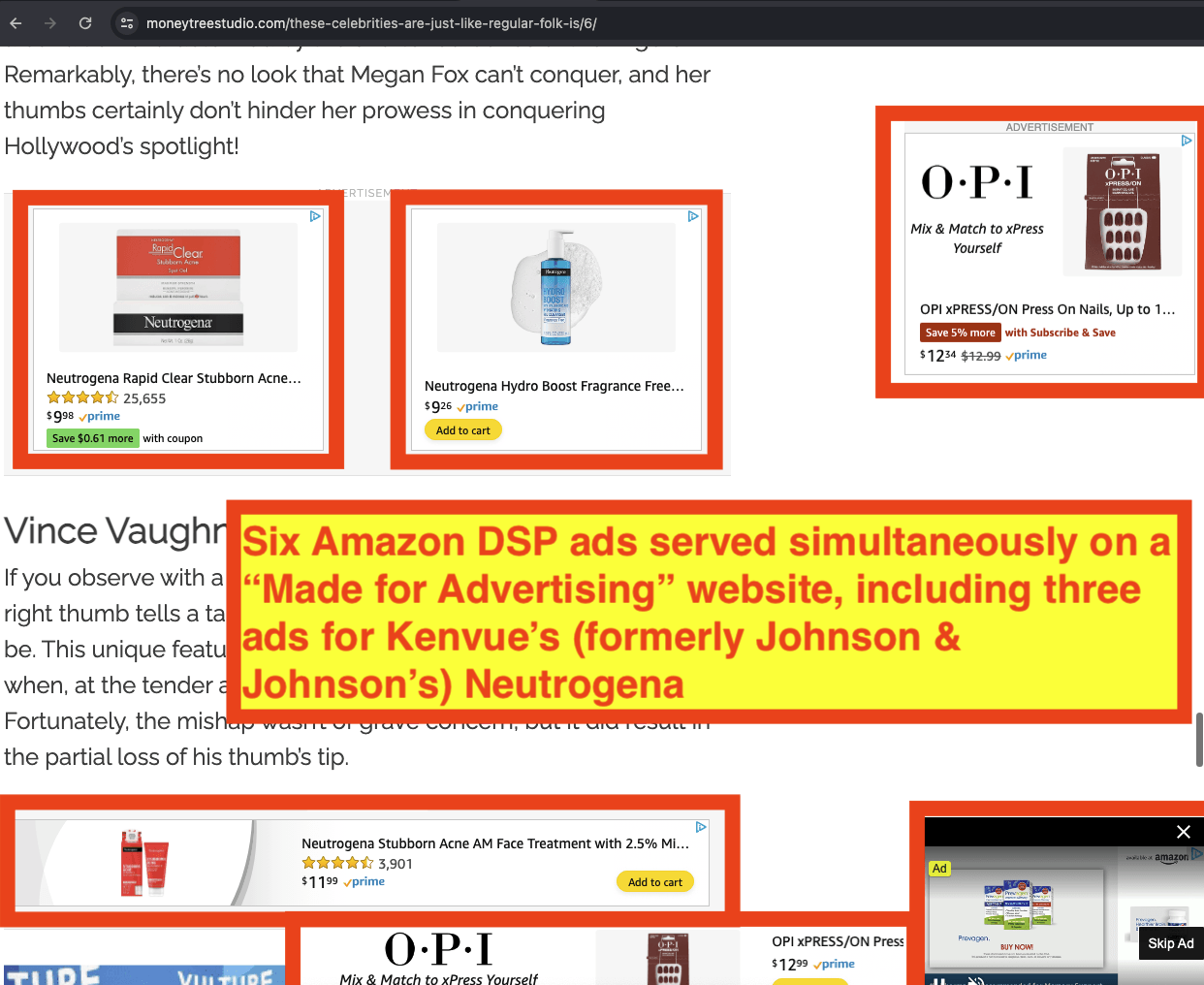 Six Amazon DSP ads observed on a website which meet’s the ANA’s, WFA’s, ISBA’s, 4A’s, Jounce Media’s, and DeepSee.io’s definition of “Made for Advertising” website. Visible are three ads for Kenvue’s Neutrogena.
Six Amazon DSP ads observed on a website which meet’s the ANA’s, WFA’s, ISBA’s, 4A’s, Jounce Media’s, and DeepSee.io’s definition of “Made for Advertising” website. Visible are three ads for Kenvue’s Neutrogena.
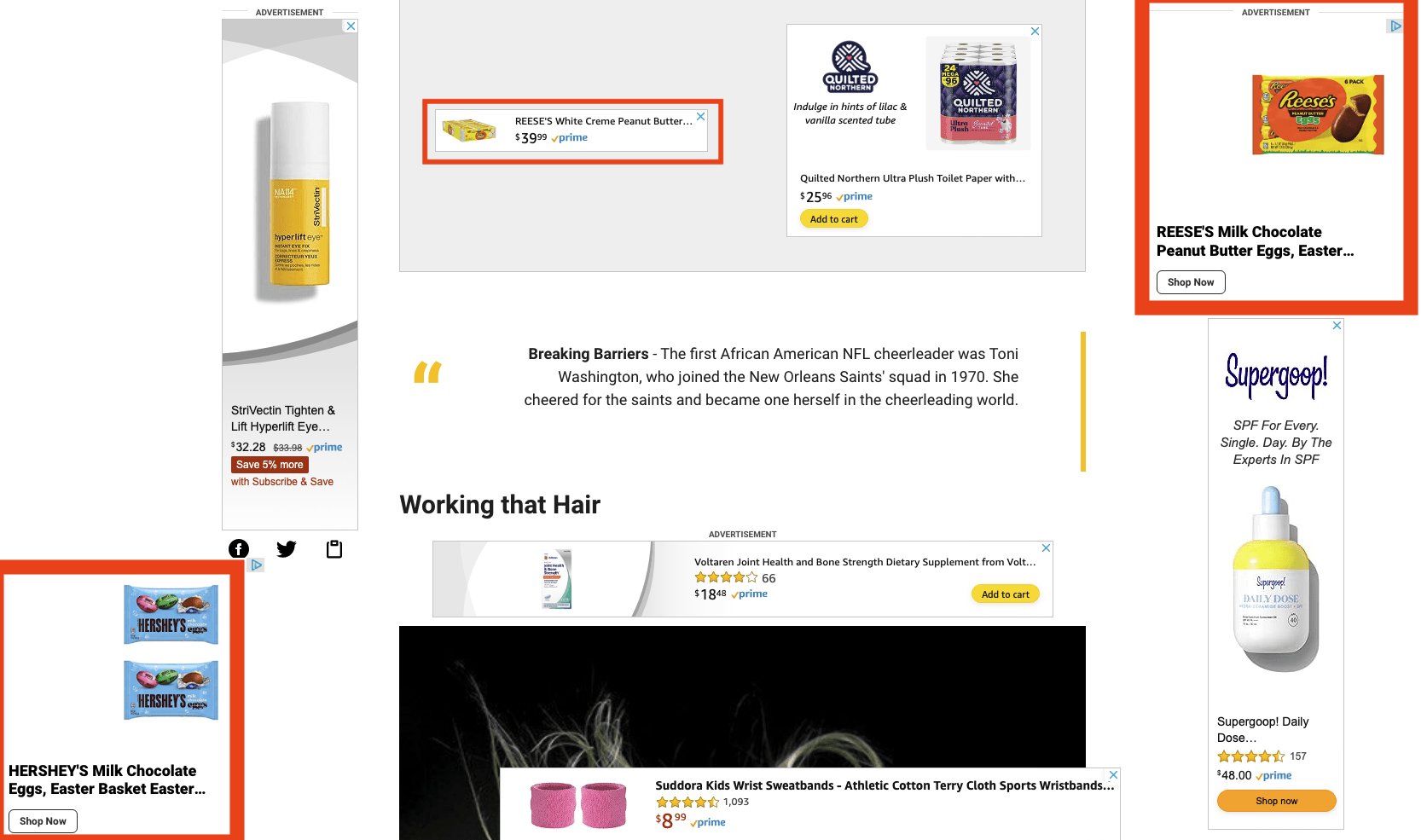
Screenshot showing seven ads transacted via Amazon retail media network and/or Amazon DSP on a “Made for Advertising” website. Three of the ads are for Hershey’s chocolate products.
Background on the industry response to MFA sites
On June 19th, 2023, the Association of National Advertisers (ANA) released a research report titled “ANA Programmatic Media Supply Chain Transparency Study”. This report found that 21% of overall ad impressions occur on MFA sites, and advertisers do not have control over their media placement decisions.
MFA websites “are largely useless for growth-oriented strategies” and that “Made for Advertising websites generally provide a poor user experience and potentially damage the reputation of digital advertising overall,” according to the ANA. MFA sites are also referred to as “Made for Arbitrage” sites by the 4A’s.
In the six months since the ANA published its Transparency Study, many ad tech vendors and media agencies issued public statements on actions they have taken to reduce brands’ ad placements on “Made for Advertising” websites.
For example, Digiday published an article stating the “crackdown on made-for-advertising sites is gaining momentum. Magnite, Sharethrough and PubMatic are blocking these sites, making it increasingly challenging for them to profit from their deceptive practices.”
ShareThrough ad exchange released an announcement stating “Sharethrough becomes the first ad exchange to remove MFA sites, which are sites created for the purpose of ad arbitrage, from all its off-the-shelf deals and custom PMPs created after July 1, 2023. The company is leveraging Jounce Media data to identify MFA sites and has built filters within its curation platform to remove them.”
A “spokesperson for Index Exchange told Adweek that the SSP prohibits MFA inventory.”
SSP PubMatic told Adweek that it was eliminating MFA inventory from the auction packages it sells. A spokesperson for Google said Google does not allow “publishers to engage in disruptive, invasive or deceptive ad-serving practices simply for the purposes of generating ad revenue.”
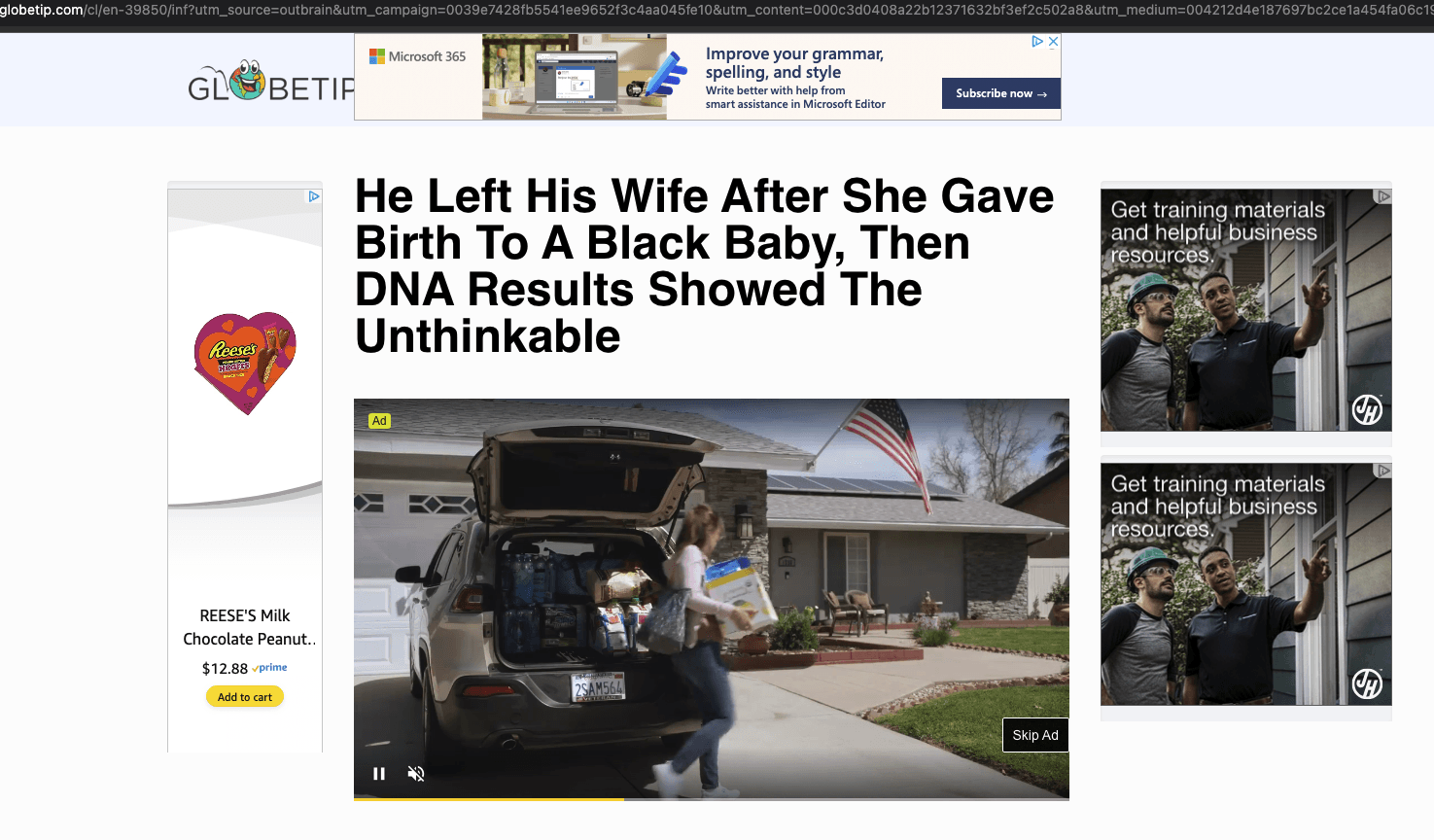
Screenshot of Hershey’s Reese’s, Microsoft, and James Hardie ads observed on a website which meets the ANA’s, WFA’s, ISBA’s, 4A’s, Jounce Media’s, and DeepSee.io’s definition of “Made for Advertising” website. The Hershey’s ads were transacted via Amazon DSP. Other ads on this page were transacted via OpenX, Nexxen, Xandr, Magnite, Index Exchange, TripleLift, Media.net, ShareThrough, Pubmatic, and other ad exchanges.
GroupM announced “the introduction of new protections against Made For Advertising (MFA) websites and domains”, which “will see GroupM integrate Jounce’s industry-leading technology in tracking MFA domains with GroupM’s leading campaign planning processes.”
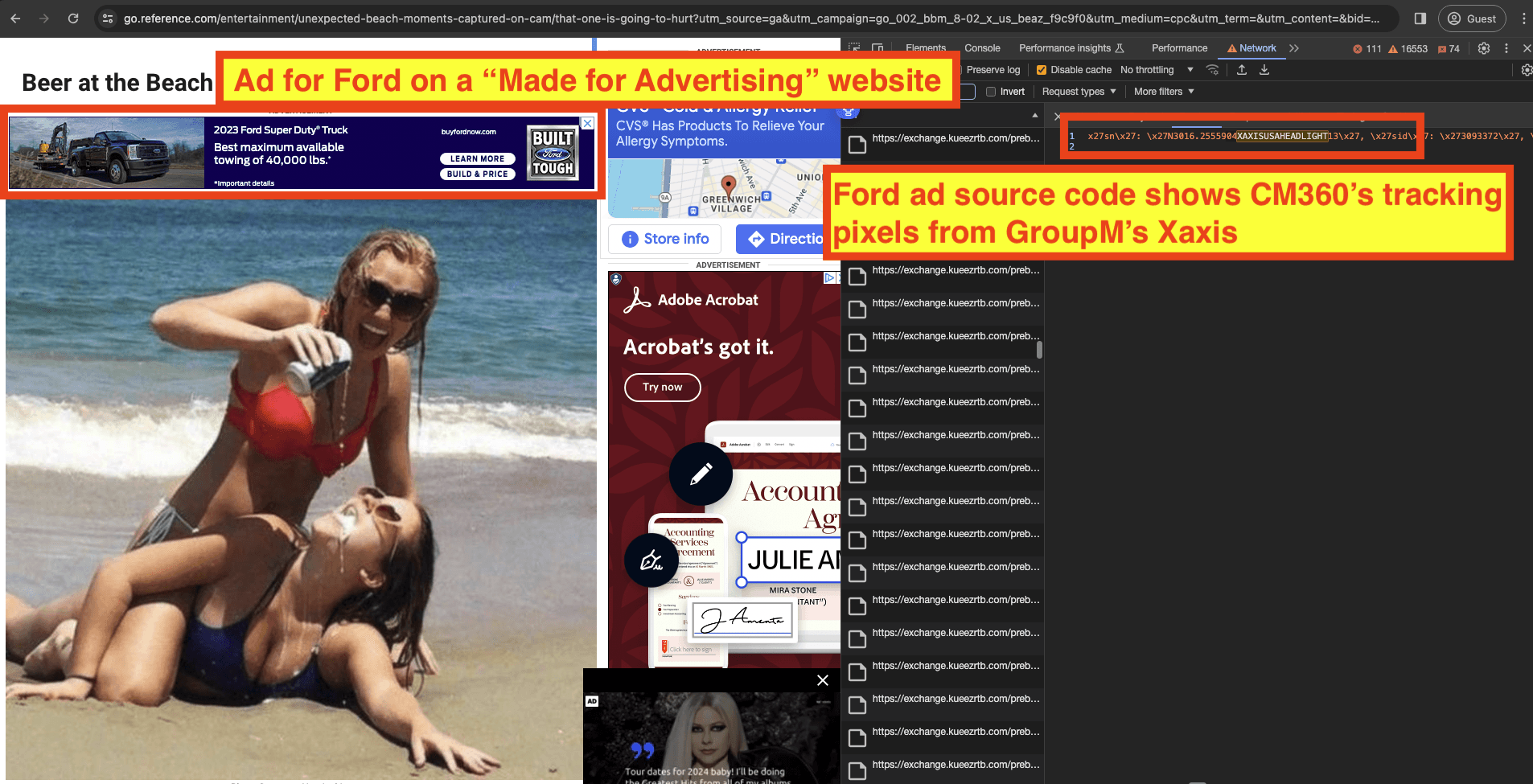
Screenshot of an ad for Ford, transacted by GroupM, observed on a website which meets the ANA’s, WFA’s, ISBA’s, 4A’s, and DeepSee.io’s definition of “Made for Advertising” website. The source code of the Ford ad reference’s GroupM’s programmatic trading desk Xaxis.
More recently, in February 2024, Digiday published an article titled: “Buyers say the MFA panic is over – but not forgotten”. The global head of brand assurance at Dentsu said, “In terms of priorities for 2024, MFAs are currently about a 4 out of 10 [...] we are confident that our current approach is successful”.

Screenshot showing four Cadillac General Motors ads served on a website which meet’s the ANA’s, WFA’s, ISBA’s, 4A’s, Jounce Media’s, and DeepSee.io’s definition of “Made for Advertising” website. The “Why this ad?” info modal shows the ads were placed by Dentsu’s Carat subsidiary. These and other Cadillac ads were placed using Google’s DV360 DSP and Index Exchange, TripleLift ad exchange.
Another agency executive said: “[MFAs] are not any more of a concern going into 2024 than [they were] last year because we have so many different systems in place that would mitigate any concern”. Digiday reported that the SVP and Head of Precision Media at Digitas (Publicis), said that MFAs are still a “higher priority” in 2024, but between the targeting tools and MFA filters created by Publicis Groupe and DSPs like The Trade Desk, she said she feels her team is in a strong position to maintain the “pursuit of quality inventory” in the new year. Another agency executive told Digiday that “We have identified tools and protocols to solve for MFAs and feel good about our path forward there.”
Omnicom Media Group’s CEO told Digiday in a December 2023 article that Omnicom has “been investing a lot of time and resources, partnering with vendors, partnering with technology companies in really screening websites for MFA-suspicious activity. And once that’s been confirmed, they’re being weeded out.”
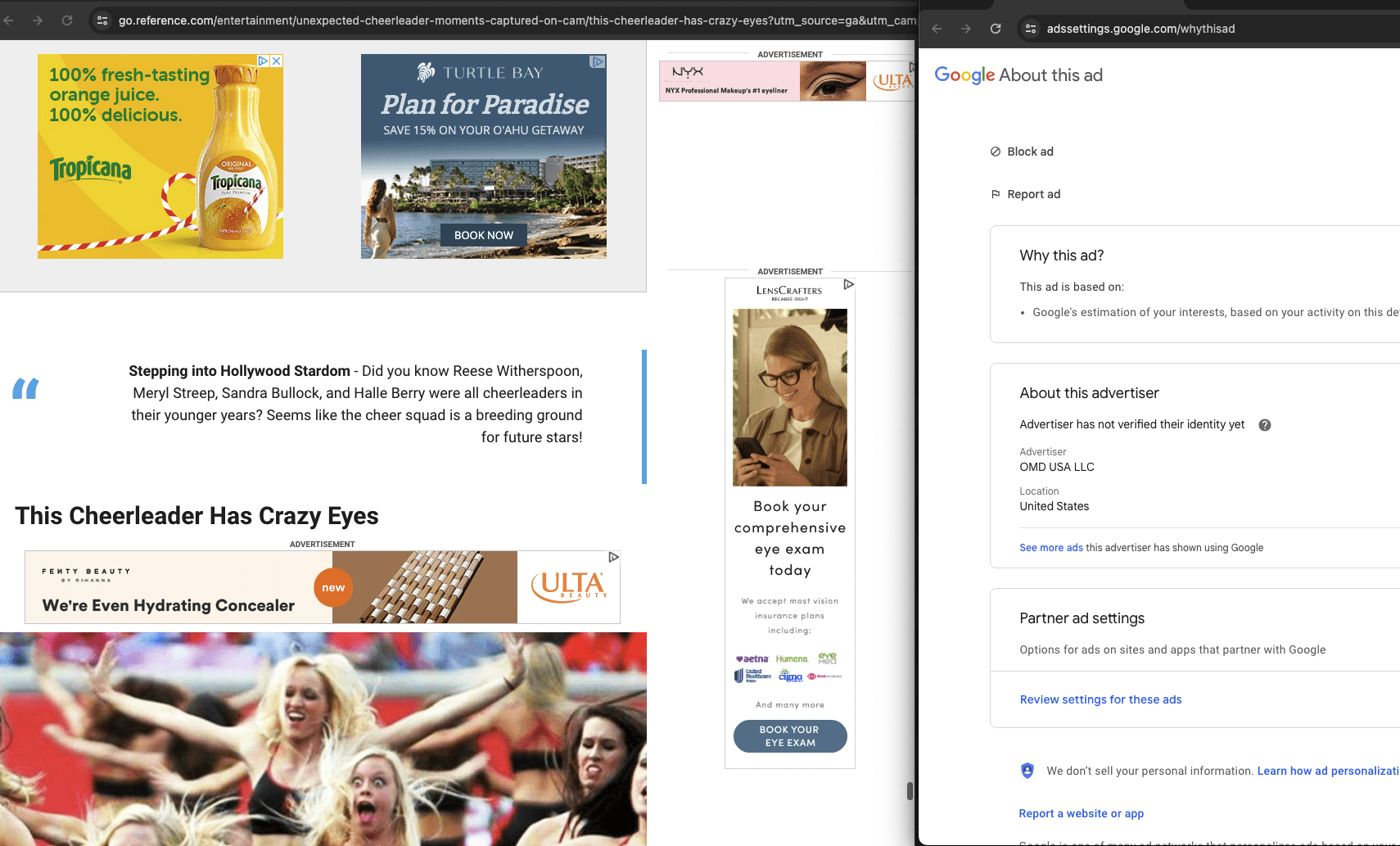
Screenshot showing Tropicana ads served on a website which meets the ANA’s, WFA’s, ISBA’s, 4A’s, Jounce Media, and DeepSee.io’s definition of “Made for Advertising” website. The “Why this ad?” info modal shows the ads were placed by OMD, an Omnicom subsidiary.
However, despite various vendors’ public statements, the ANA’s report contains a warning of caution: “it should be noted that advertisers would be well-advised to verify that such MFA-blocking offerings function as sold to ensure policy compliance” (emphasis added).
Overview of Adalytics findings
Informed by the ANA’s playbook recommendations and using empirical collection of publicly accessible data, this Adalytics observational study found that:
Hundreds of ANA member and other brands continue to have their ads observed on “Made for Advertising” websites as of January 2024, including major ones such as Procter & Gamble, Bayer, Reckitt, AT&T, Johnson & Johnson, AbbVie, Novartis, Pfizer, State Farm, PwC, Hershey’s, Unilever, Mondelez, Mars, Haleon, Ford, NBC Universal, Disney, AARP, Pfizer, Dell, US Army, US Air Force, US Navy, the Wall Street Journal, General Motors, Google, Meta, Hyundai, Molson Coors, and many others.
Almost all of the brands that participated in the ANA’s 2023 Programmatic Transparency Study continue to have their ads placed on “Made for Advertising” websites as of January 2024 - more than 6 months after the ANA released its transparency report.
Eighty percent of the SSPs invited to present at the ANA’s upcoming March 2024 event continue to serve ANA members’ ads on websites that meet their definition of MFA sites. The ANA event follows the publication of its Supply Chain Transparency Study, which included a report dedicated to addressing brands’ exposure to MFA sites.
Several US government agencies and departments were exposed to MFA sites, including the US Army, Navy, Social Security Administration, and Federal Trade Commission (FTC).
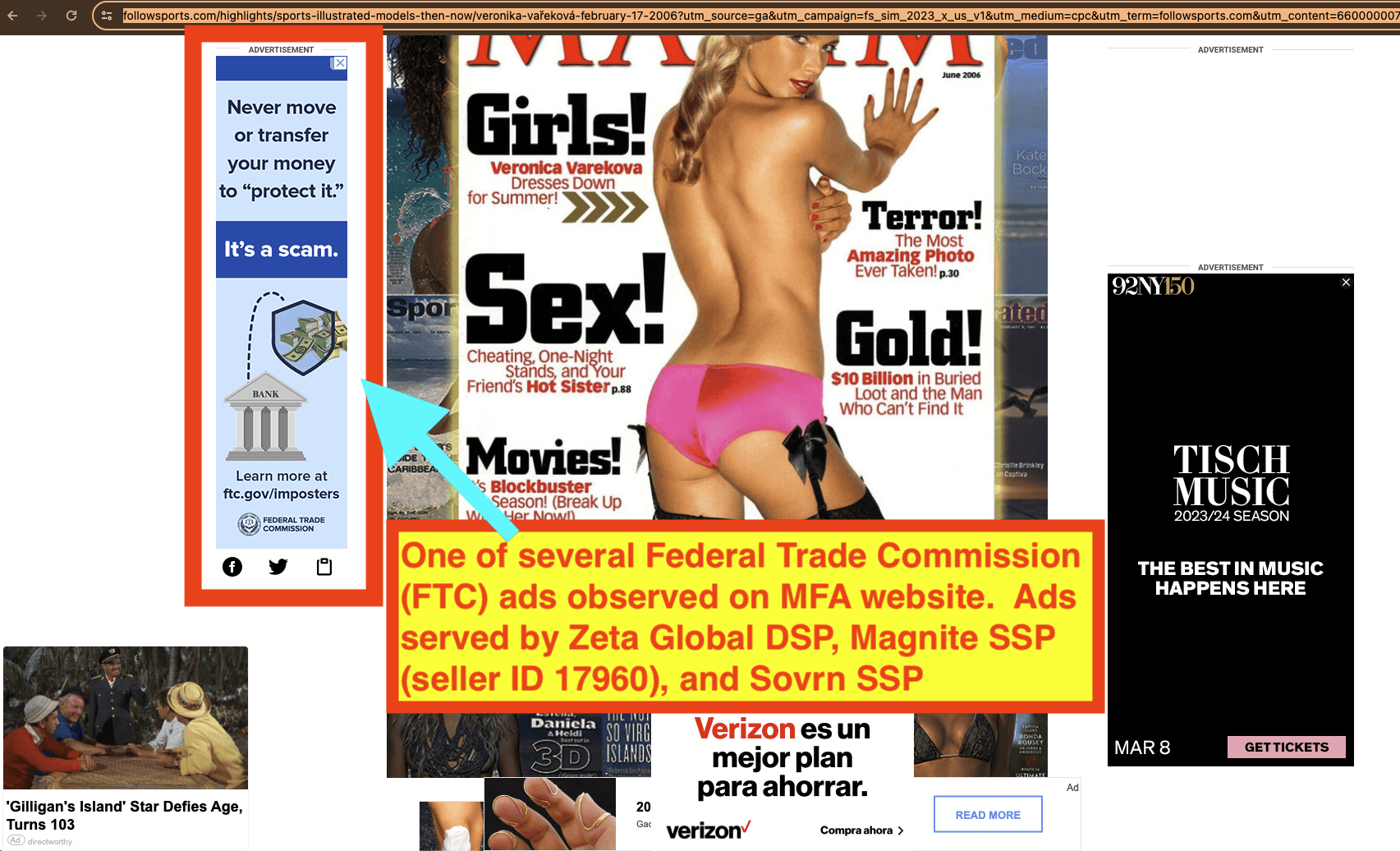
Screenshot from 2024 of a Federal Trade Commission (FTC) ad observed on a website not affiliated with Maxim which meets the ANA’s, WFA’s, ISBA’s, 4A’s, Jounce Media’s, and DeepSee.io’s definition of “Made for Advertising” website. The ad was transacted via Zeta Global DSP, Magnite SSP (seller ID 17960), and Sovrn SSP. Two Verizon ads (one stacked on the second one) are visible below.
MFA sites employ aggressive ad refreshes, which can result in a user being shown the same ad up to thousands of times during a single page view session, raising concerns about the efficacy or utilization of frequency capping. For example, H&R Block had 2,117 impressions served to one consumer on a single MFA article in less than one hour. Verizon had 781 ad impressions served to one consumer on an MFA article in less than one hour.
Due to an apparent lack of frequency capping when campaigns serve on MFA sites, some brands are paying astronomically high prices to reach a single consumer. For example, Kroger paid an effective cost per 1000 people reached of $5,491 to reach one consumer on an MFA site. Comcast paid an effective cost per 1000 people reached of $2,628 to reach one consumer on a MFA site in a single page view session. The cost to reach one unique viewer on an MFA site can be more expensive than the cost of incremental reach of advertising on the Super Bowl half-time show or of running ads on Netflix or Amazon Prime video.
Many ad exchanges and supply side platforms (SSPs) continue to serve ads on MFA sites, including ShareThrough, Epsilon Conversant, TripleLift,Teads, GumGum, Colossus, Sovrn, Sonobi, Ogury, Zeta Global, Nexxen, Google, Criteo, Smart AdServer, 33Across, Magnite, Pubmatic, Index Exchange, OpenX, OpenWeb, and Microsoft Xandr.
Some ad exchanges which claim to work with vendors such as Jounce Media to eliminate Made for Advertising inventory from Private Marketplace (PMP) deals appear to continue to serve brands’ ads on MFA sites specifically via PMP deals. For example, it appears that the Dell, Microsoft, Comcast, Vail Resorts, Adobe, and other brands had ads served on sites Jounce Media has classified as MFA specifically via PMP deals that were transacted via ShareThrough

Annotated screenshot of the Association of National Advertisers (ANA’s) “Meet the SSPs” showcase event on March 7th, 2024. Eighty percent of the SSPs invited to present at the ANA event were confirmed to serve multiple ANA members’ ads on websites which meet the ANA’s, WFA’s, ISBA’s, 4A’s, Jounce Media’s, and DeepSee.io’s definition of “Made for Advertising” website.
Many demand side platforms (DSPs), including Roku OneView, AdTheorent, Quantcast, StackAdapt, Comcast’s Beeswax, Criteo, Yahoo DSP, Xandr DSP, Epsilon Conversant, Google DV360, and Amazon DSP, have been observed transacting Made for Advertising inventory. Many pharmaceutical brands have their ads served on Made For Advertising sites via PulsePoint and DeepIntent - both are healthcare marketing focused platforms
Trade Desk and Walmart DSP (which runs on Trade Desk software) did not appear to have any ads served on Made for Advertising sites, possibly due to enforcement of its own inventory policies.
Many major brands appear to have their ads placed on MFA sites specifically via retail media networks (also known as RMNs), such as Amazon’s retail media network. Brands such as Hersheys, Bayer, Procter & Gamble, Haleon, S. C. Johnson & Son, Henkel, Unilever, Reckitt, Nestle, Clorox, Colgate, Google, Georgia-Pacific, Kenvue, PepsiCo, Coca-Cola, Mars, Smuckers, and General Mills had ads observed on MFA sites via retail media networks such as Amazon’s.
Many ads placed on Made for Advertising sites appear to include measurement or verification tags from vendors such as Integral Ad Science (IAS), DoubleVerify (DV), Oracle Moat, Pixalate, HUMAN (fka White Ops), and/or Fou Analytics.
Many major agencies - including all seven agency holding companies (Havas, Dentsu, Omnicom, Publicis, IPG, WPP, Stagwell) and independent agencies such as Horizon Media and Digilant appear to be transacting major brands’ ads on Made for Advertising sites. For example, IPG was observed transacting ads for Bristol Myers Squibb, American Express, BMO Bank, Charles Schwab, Johnson & Johnson, Kenvue, Gilead, and CVS on MFA sites. GroupM’s MindShare or Xaxis was observed transacting ads for Volvo, Ford and John Deere on MFA, and Dentsu’s Carat was observed transacting ads for General Motors on MFA. Omnicom was observed transacting Tropicana, Cogeco, and AT&T ads on MFA. Publicis was observed transacting ads for Verizon, Sonic Drive-In (part of Inspire Brands), Hulu, AAA, Toyota, Edenred, Citi, Starbucks, Marriott, Haleon, Walmart, USAA, Campbell Soup Company, Vanguard, Wingstop, and Lowe’s on MFA. Havas was observed transacting ads for Sanofi, Choice Hotels, Urovant, and NewYork-Presbyterian Hospital on MFA. Stagwell’s GALE was observed transacting thousands of H&R Blocks ads to the same few individuals on auto-refreshing MFA sites. Horizon Media was observed transacting United Healthcare and SleepNumber ads on MFA sites via DV360 and using DoubleVerify.
Thousands of brands appear to have their ads placed on Made for Advertising sites via the Microsoft Audience Network.
Some brands such as Grammarly and Vrbo continue to have their skippable YouTube TrueView video ads observed in muted, auto-playing out-stream video players on Made for Advertising websites via the Google Video Partners (GVP) network.
Many brands’ ads were placed on “Made for Advertising” sites via vendors which allege to use AI to serve or target ads, or wherein the vendors claim to have access to some kind of special dataset, such as NPI lists of US healthcare providers.
Table of Contents
What are “Made for Advertising” (MFA) websites? 20
Leading Trade Groups define “Made for Advertising” websites 23
Identifying a sample of “Made for Advertising” (MFA) websites 31
Considering the ownership and audience of the sample of putative “Made for Advertising” websites 43
Thousands of brands have their ads observed on “Made for Advertising” websites in 2024 50
Ad tech vendors observed transacting brands’ ads on “Made for Advertising” websites in 2024 69
Demand side platforms observed transacting brands’ ads on “Made for Advertising” websites in 2024 77
Brand Safety Vendors and Bot Detection Vendors Observed Collecting Data on MFA sites in 2024 89
Private marketplace (PMP) deals serving ads on “Made for Advertising” websites 95
Yieldmo observed potentially transacting PMP deals on “Made for Advertising” websites 97
Pubmatic observed potentially transacting PMP deals “Made for Advertising” websites 99
OpenX observed potentially transacting PMP deals serving ads on “Made for Advertising” websites 102
ShareThrough observed potentially transacting PMP deals on “Made for Advertising” websites 104
Retail Media Networks appear to transact ads on “Made for Advertising” websites 108
Media agencies observed transacting ads on “Made for Advertising” websites in 2024 139
Microsoft Audience Network 153
Potential solutions for advertisers 165
Background
What are “Made for Advertising” (MFA) websites?

Screenshot of a X (fka Twitter) post referencing “Made for Advertising” websites in August 2021.
According to the Association of National Advertisers, “MFA sites typically use sensational headlines, clickbait, and provocative content to attract visitors and generate page views, which in turn generate ad revenue for the site owner. MFA sites also usually feature low-quality content, and may use tactics such as pop-up ads, auto-play videos, or intrusive ads to maximize ad revenue.”

Illustration of what a Made for Advertising (MFA) website can look like. Source: Interactive Advertising Bureau (IAB) UK
The ANA states: “Some of the lower quality websites, especially Made for Advertising sites, create more carbon emissions than the average site. That is because they have many ads per page and indiscriminately make ad calls to as many demand sources (like SSPs, DSPs, and ad networks) as they possibly can. According to Scope3 (a new industry organization with the mission to decarbonize advertising), MFA sites are 26 percent higher in carbon emissions than non-MFA inventory”.
Furthermore, the ANA states: “MFA sites generally are designed to fool digital advertising buyers. MFA websites exhibit high measurability rates, good viewability rates, and low
levels of invalid traffic, and usually have brand-safe environments. They also
perform higher on video completion rates, often with autoplay ads that have the
sound off. Notably, media CPMs paid on MFA websites are 25 percent lower than
those paid on non-MFA websites. All this makes MFA websites attractive to DSP
bidding algorithms. But typically, MFA websites don’t perform well on key metrics like brand lift. According to Jounce Media, ads on MFA websites are at least 50 percent less
likely to be attributed with driving a sale than the internet average.”
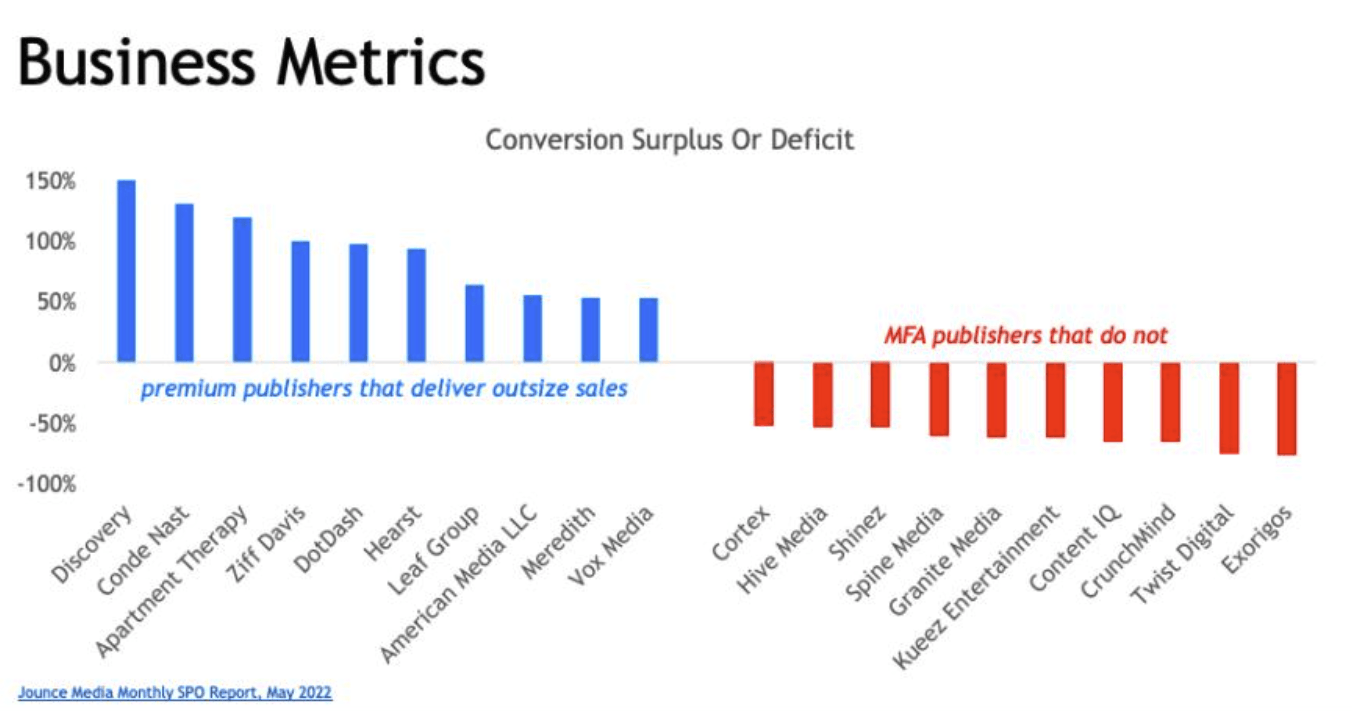
Histogram showing that “Made for Advertising” publishers tend to drive less conversions for advertisers than premium publishers. Source: Jounce Media Monthly SPO Report, May 2022, via Campaign
One of the contributors to the ANA report, Jounce Media states that: “MFA is defined as a category of “inventory that achieves superficial KPIs like viewability by creating a user-hostile advertising experience.””
Furthemore, the ANA states: “The experience of visiting MFA websites can also fool digital advertising buyers. Going directly to an MFA site (i.e., simply typing in the URL of the site) results in a very different ad experience than clicking on a referral link (often at the bottom of the page on the site of a well-known publisher). In the former case, the user experience is generally cleaner. In the latter case it is not, typically exhibiting characteristics in the aforementioned definition such as high ad-to-content ratio and rapidly auto-refreshing ad placements. While investigating MFA supply, DeepSee.io found that many remove ads when people visit a site directly, but flood the page when people come via social media, search engines, or content recommendation widgets.”

The same site visited directly vs visited by paid link. Source: DeepSee.io

Two screenshots of the same website. The top screenshot shows when the site is visited directly. The bottom screenshot shows there are significantly more ad density on the page when the visit is visited by a paid ad click on another website (Taboola, Outbrain, Facebook, etc).
According to Chris Kane, CEO of Jounce Media, “Made for Advertising” “ad inventory is viewable, brand safe and cheap, designed to meet standards buyers and content verification ad-tech firms have implemented in the past half-decade. Yet these sites rarely drive real-world business outcomes.” Kane further said: “There is more and more consensus among industry insiders that [MFA] meets all the industry’s minimums but fails basic inventory quality standards,” Kane said. “It’s not fraud, but it’s tiptoeing close to fraud.”
The Vice President of programmatic & display media at performance marketing agency Tinuiti, Geoff Litwer, told Adweek that: media “buyers currently have all the tools they need to mostly avoid MFA inventory, but that low-quality websites continue to exist because they help marketers fulfill vanity metrics without actually making for good advertising.“If you have a marketer whose CFO assigns a budget based on a particular KPI, [MFA] makes [their] life so much easier,” Litwer said. “[MFA] is the ‘feel-good, I can save time’ trick.””
Campaign reported that: “MFAs cannot manipulate outcomes, fake incremental brand, behavioural, or business outcomes. The only caveat is that MFA can game attribution measurement but not incrementality measurement [...] So, despite having killer reach and viewability metrics, the MFA inventory would be exposed as worthless if the campaign's goal was to drive sales."
The ANA states that Made for Advertising websites have “High percentage of paid traffic sourcing” and “often have little-to-no organic audience and are instead highly dependent on visits sourced from clickbait ads that run on social networks, content recommendations platforms, and even on the websites of reputable publishers. Buying paid traffic is the primary cost driver of operating an MFA business. Overcoming paid traffic acquisition costs requires MFA publishers to engage in aggressive monetization practices and arbitrage.”
Some MFA sites go even a step further, and specifically configure their websites to not appear in organic Google or Bing search results. This further reduces the probability that a viewer would arrive at one of the websites through organic, un-paid traffic sources.
Leading Trade Groups define “Made for Advertising” websites
On September 26th, 2023, a “consortium of marketing and advertising trade organizations [...] released a detailed definition of so-called “Made for Advertising” websites.” The “group included the ANA, the 4A’s, the World Federation of Advertisers (WFA) and the Incorporated Society of British Advertisers (ISBA). The MFA definitions were also developed in consultation with Chris Kane, Founder of Jounce Media, and Rocky Moss, Co-Founder and CEO of DeepSee.io.”
“MFA sites, also referred to by the 4A’s as “Made for Arbitrage” sites, are created for that singular purpose—to simultaneously buy and sell advertising inventory.” The ANA said “MFA sites generally are designed to fool digital advertising buyers. MFA websites exhibit high measurability rates, good viewability rates, low levels of invalid traffic, and usually have brand-safe environments.”
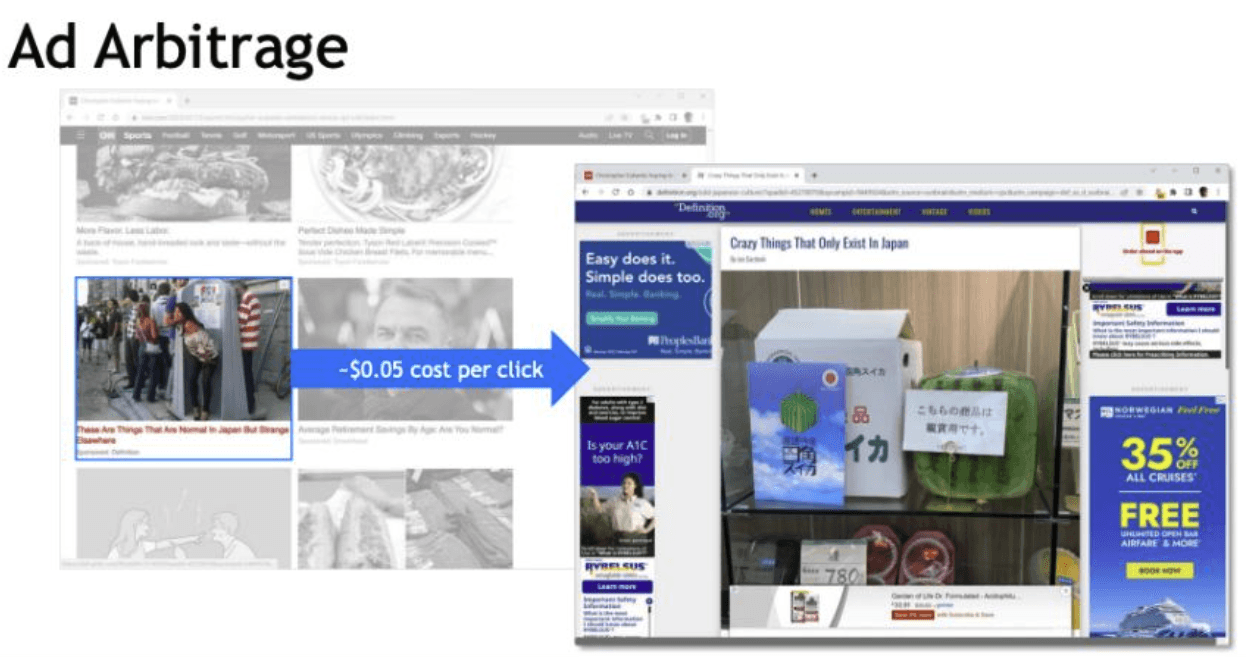
Source: Jounce Media, via Campaign
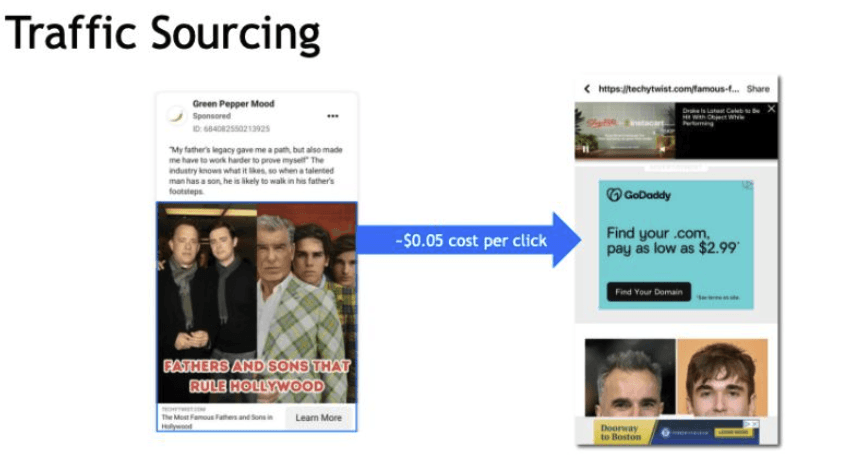
Source: Jounce Media, via Campaign
The trade organizations said MFA sites usually exhibit some combination of the following characteristics:
High ad-to-content ratio
Usually at least twice the internet average, e.g., ad-to-content ratio of 30+ percent for desktop.
Rapidly auto-refreshing ad placements
Numerous refreshing banner ads.
Autoplay video ads flood the site.
Slide shows forcing visitors to click through multiple pages to access content, with multiple ads.
High percentage of paid traffic sourcing
Made For Advertising publishers often have little-to-no organic audience and are instead highly dependent on visits sourced from clickbait ads that run on social networks, content recommendations platforms, and even on the websites of reputable publishers. Buying paid traffic is the primary cost driver of operating an MFA business. Overcoming paid traffic acquisition costs requires MFA publishers to engage in aggressive monetization practices and arbitrage.
Generic content (non-editorial or templated, low-quality content)
Often syndicated, dated and non-unique (articles regurgitated).
Usually poorly designed, templated website designs

A consortium of leading advertising trade groups established a joint definition for “Made for Advertising” sites. Source: Association of National Advertisers
Lastly, the IAB UK published a “Guide to identify made for advertising websites” in July 2023.
Which ad tech vendors and media agencies have issued statements about reducing ad delivery on “Made for Advertising” websites?
Since the ANA issued its June 2023 “First Look” report documenting the issue of “Made for Advertising” websites, a number of ad tech vendors and media agencies have issued statements or told journalists about various initiatives they were undertaking to reduce advertisers exposure to “Made for Advertising” websites.
ShareThrough, PubMatic, Magnite, OpenX, Nexxen, Yieldmo, Sovrn, TripleLift, and Media.net issued various blog posts or press releases disavowing “Made for Advertising” in certain cases. TripleLift said that “we are committed to: Blocking Made for Advertising (MFA) inventory from all private marketplace and publisher first-party data deals; Refusing to onboard any MFA inventory, a part of our supply standards.” Magnite said: “we ensure that all inventory made available meet our core standards [...] Magnite leads the way in protecting buyers from MFA sites.” Magnite’s inventory quality policies state that: “using automatic ad refreshes (unless instigated by an end-user refreshing the seller’s media)” is a form of “invalid impressions”.
OpenX states that it “has partnered with Jounce Media” and has “started to block known MFA traffic on Auction Packages running through OpenX.” It further states: “OpenX leverages the Jounce Media MFA domain list as the standard baseline, and in its continued commitment to inventory quality and transparency, the SSP has committed to eliminating MFA domains in all direct-sold deals by default.”
ShareThrough announced on June 14th, 2023 that “Sharethrough becomes the first ad exchange to remove MFA sites, which are sites created for the purpose of ad arbitrage, from all its off-the-shelf deals and custom PMPs created after July 1, 2023. The company is leveraging Jounce Media data to identify MFA sites and has built filters within its curation platform to remove them.”

SSP press releases announcing removal of MFA supply from PMPs, compiled by Jounce Media
PubMatic senior director of marketplace quality Eric Bozinny told Adweek in June 2023 that it “will announce it’s eliminating MFA inventory from the auction packages it sells.” Pubmatic issued a blog post in June 2023 regarding “Made for Advertising”, but it is now no longer accessible. The inaccessible blog post said: “PubMatic is [...] turning responsible media insights into action by eliminating made for advertising (MFA) websites from PubMatic-sold Auction Packages.” The inaccessible post further said: “our work to provide powerful, quality advertising experiences for buyers has been recognized by Jounce Media, which ranks PubMatic as the omnichannel supply-side technology company with the lowest exposure to MFA inventory among our peer group. According to Jounce Media’s Chris Kane, “Bidding into the PubMatic open auction creates less exposure to MFA inventory than bidding into the open auction from any other major exchange.”
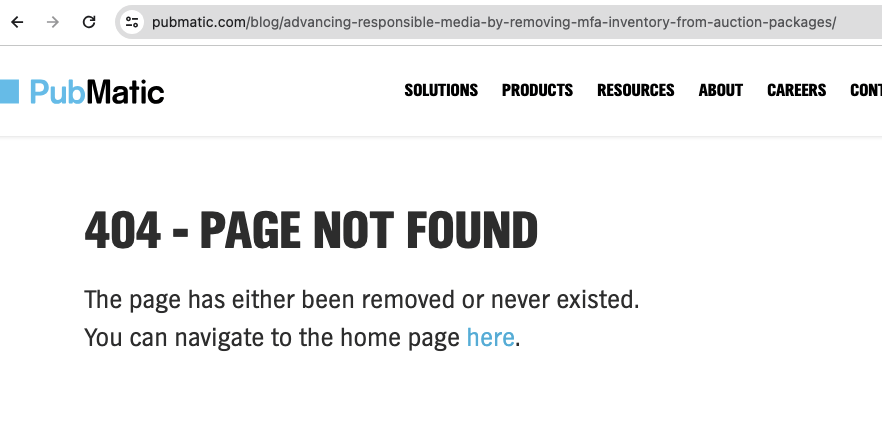
Screenshot of Pubmatic’s blog post titled: “Advancing Responsible Media By Removing MFA Inventory From Auction Packages.” (URL: https://pubmatic.com/blog/advancing-responsible-media-by-removing-mfa-inventory-from-auction-packages/) showing that the page is “not found”. An archived copy of the page can be found on the Internet Archive from June 2023.
Index Exchange told Digiday that: “We have always made an effort to block inventory that is low effort or low quality, has a high ad density to content ratio, and has high levels of social or display ad traffic, which are all common criteria of MFA content [...] Quality has been a cornerstone of Index since the launch of the exchange, and our policies are continually revised to support this, in lockstep with feedback from our buyers and partners.”
Several ad buying or demand side platforms (DSPs) have also issued statements regarding filtering out “Made for Advertising” in certain situations. For example, the DSP AdTheorent announced it was partnering with Jounce Media to “verify removal of Made for Advertising (MFA) Properties from Its Campaigns) [...] to ensure that AdTheorent’s campaigns remain MFA-free, unless affirmatively elected by an advertiser. “
DSP Centro Basis “partnered with Jounce Media to automatically prevent ads from being served on [Made for Advertising] sites.”
Digiday wrote that DSP Trade Desk “have put up a good fight, implementing robust measures to curb MFA inventory purchases through their ad tech platform” and “refuse to buy this [MFA] inventory outright.”
Several ad verification vendors also issued statements about helping brands monitor or eliminate delivery on “Made for Advertising” websites.
In September 2023, DoubleVerify announced a “solution to enable advertisers to monitor and avoid MFA”.
In October 2023, IAS “announced a new Made for Advertising (MFA) AI-driven site detection and avoidance product.” “IAS’s new product leverages AI to uncover MFA sites at scale” and “provide [advertisers] with the ability to both detect and avoid MFA sites”.
In November, 2023, Pixalate “announced the launch of “Made for Advertising” (MFA) technology to detect and block MFA websites, CTV and mobile apps.”
Several media agencies also issued public statements about various approaches or initiatives related to “made for advertising” websites.
GroupM announced “the introduction of new protections against Made For Advertising (MFA) websites and domains”, which “will see GroupM integrate Jounce’s industry-leading technology in tracking MFA domains with GroupM’s leading campaign planning processes.”
The global head of brand assurance at Dentsu told Digiday: “In terms of priorities for 2024, MFAs are currently about a 4 out of 10 [...] we are confident that our current approach is successful”.
Digiday reported that the SVP and head of precision media at Digitas (Publicis), said that MFAs are still a “higher priority” in 2024, but between the targeting tools and MFA filters created by Publicis Groupe and DSPs like The Trade Desk, she said she feels her team is in a strong position to maintain the “pursuit of quality inventory” in the new year.
Digiday reported that for Omnicom: “By using its own standards, as well as those of the ANA, OMG delivered results for its clients that it said outperformed the averages the ANA study revealed [...] OMG was able to keep MFA delivery to less than 1%.”
Omnicom Media Group’s CEO told Digiday in a December 2023 article that Omnicom has “been investing a lot of time and resources, partnering with vendors, partnering with technology companies in really screening websites for MFA-suspicious activity. And once that’s been confirmed, they’re being weeded out.”
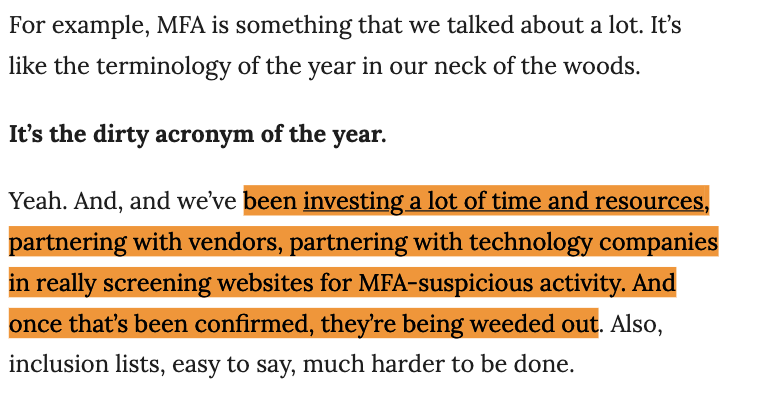
Screenshot from a December 2023 Digiday article interview with the CEO of Omnicom Media Group
The Director of Supply Intelligence at IPG’s KINESSO subsidiary wrote that: “At KINESSO, we have generated an arsenal of tactics to help us review inventory and weed out MFAs.”
Research methodology
In order to be able to observe which brands have ads served on “Made for Advertising” websites in January 2024, as well as which vendors were transacting said ads, it was first necessary to identify a sample of websites which can be reasonably described to meet the criteria for “Made for Advertising” sites. While there are hundreds to thousands of different unique domains which can meet the various criteria of being ‘Made for Advertising’, this study chose to focus on a list of twenty two websites for which there was relatively strong justification for sites being classified as “Made for Advertising”.
Identifying a sample of “Made for Advertising” (MFA) websites
In order to identify a list of twenty two websites which can be considered “Made for Advertising”, this study sourced information on tens of thousands of different websites, including the following metrics or data points:
ad delivery
ad refresh rates
number of simultaneously displayed video and banner ad slots per page
total number of unique or distinct ad slots per page
total number of ad impressions served to individual consumers per page
audience traffic sources (paid, organic, direct, search, etc)
ads.txt and sellers.json seller IDs
relative prevalence of ads served within mobile in-app browser webviews
number of templated or “cloned” websites, using network analyses to identify related websites
To better explain the last point regarding templated websites - in the network graph analysis below, one can observe a cluster of websites which appear to be linked by analytics and seller IDs, as well as content displayed.
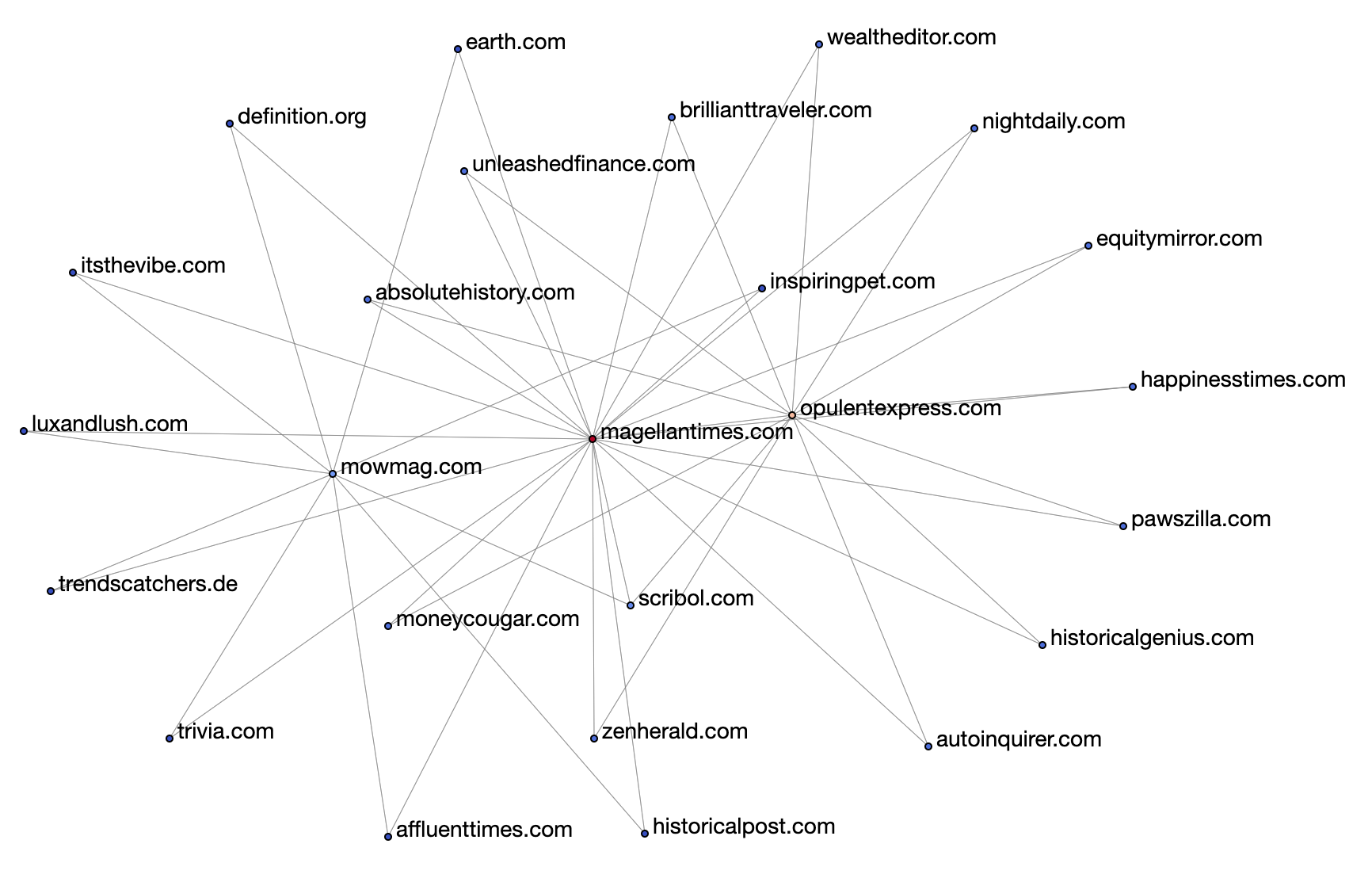
Network graph analysis of websites that are observed clustered together due to similarity in web assets and high entropy identifiers.
A manual inspection of these websites confirms that many of them appear to be visually similar in layout.

Screenshot of 3 different websites showing similar layouts, images, and content.
Furthermore, Adalytics reviewed a list of websites with both Jounce Media and DeepSee.io, who were both involved in the ANA’s programmatic transparency study in 2023 and helped various trade groups define the standard for “made for advertising”.
The list of websites was filtered to a sub-set which met all of the following criteria:
The website exhibited audience traffic sourcing, content, and ad delivery behaviors that are consistent with the Association of National Advertisers’ (ANA), American Association of Advertising Agencies’ (4A), Incorporated Society of British Advertisers’ (ISBA), and World Federation of Advertisers’ (WFA’s) detailed definition of “Made for Advertising” websites.
The websites were observed sourcing traffic via Taboola or Outbrain ads, and the websites were confirmed to have a large percentage of their audience traffic originating from paid media sources (as opposed to organic, search, direct, etc).
The websites were observed serving over one thousand ad impressions to a single consumer in a short duration page view session - due to either refreshing ad slots aggressively or loading new ads slots aggressively. This means that an advertiser could end up spending $5.00 to reach just one person/consumer, if the brand was paying $5.00 CPMs and had 1000 ads served on the putative MFA domain to a single consumer.
Were confirmed by DeepSee.io and/or Jounce Media to be classified by them as “Made for Advertising”.
With regards to ad placement density, the IAB UK’s “Guide to identify made for advertising websites” notes that its “Rules of Attention” research found that one or two ads per screen commanded more than double the attention of three plus ads.
Additionally, some of the filtered domains were observed to modulate how many ads are served to the viewer depending on how the viewer arrived on a given website. When a viewer navigates to a page on the website directly, far fewer or no ads are served to the viewer. However, when the viewer clicks on a Taboola or Outbrain ad that re-directs the viewer to the given page, specific code is triggered that loads a far higher density of ad units.
For example, in the two screenshots below, one can observe the exact same article page on the exact same domain. In the first screenshot, the consumer navigates directly to the given page by simply pasting in the exact page URL. In the second screenshot, the consumer navigates to the given page by first clicking on an Outbrain ad hosted on another website. One can observe that the density and number of ad slots is significantly higher when the viewer arrives on the page via paid media acquisition.

Screenshot of a website after a viewer arrives on the page through direct navigation - by directly typing in the URL of the page into their browser navigation bar. Only two ad slots are visible in the viewport.

Screenshot of the same website as shown above, after a viewer arrives on the page by clicking on an ad. At least six ad slots are visible in the viewport, and the ad slots refresh or rotate automatically leading to higher ad serving density.
Some of the filtered domains also disallow Googlebot and BingBot crawlers from indexing specific pages or sub-domains where they are hosting ads. This prevents the specific articles from appearing in Google or Bing search results. All user agents are also disallowed from indexing any images on the website. Many premium publishers specifically want Google or Bing to index and surface their content in search to attract readers. However, these putative “Made for Advertising” websites appear to specifically only want readers to find these individual ad dense pages after clicking on a paid ad on another website. Consumers are specifically discouraged from finding these ad dense article pages through search.
Wikipedia and Google’s documentation titled: “Block Search indexing with noindex” explain that the “noindex” attribute for the “robots” meta tag prevents all searching engines from indexing a specific page on your site.
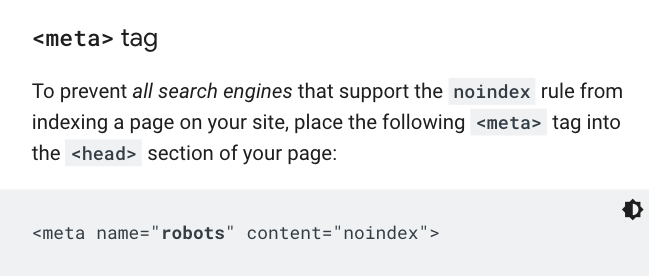
Source: Google’s documentation titled: “Block Search indexing with noindex”
For example, a specific article on the website Kueez.com, titled: “Woman Hilariously Recreates Celebrity Instagram Photos And The Results Are Too Good” was observed trying to attract readers through paid ads on other websites and serving many ad impressions. The specific page contains a “meta” tag in its source code that is set to “noindex”. This instructs crawlers such as Google search, Google news, and Bing search crawlers to avoid indexing a given page URL.

Screenshot of the source code on a particular Kueez.com article, showing that the “robots” meta tag is configured to “noindex”. This instructs Google and Bing to not index or show search results for the given page.
A quick manual Google and Bing search confirms that this specific kueez.com article cannot be located in Google or Bing search.

Google search query for ‘site:kueez.com "Woman Hilariously Recreates Celebrity Instagram Photos And The Results Are Too Good"’. No results are returned as the page is hidden from search crawlers by the “noindex” attribute.
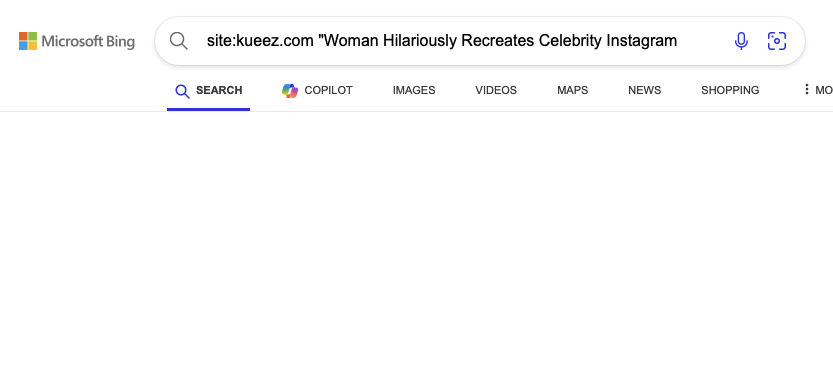
Bing search query for ‘site:kueez.com "Woman Hilariously Recreates Celebrity Instagram Photos And The Results Are Too Good"’. No results are returned as the page is hidden from search crawlers by the “noindex” attribute.
The sample of websites that were considered to meet the ANA and other trade groups’ definition of “made for advertising”, serve over 1,000 ad impressions to a single consumer in a single short duration page view session, have paid traffic acquisitions through Taboola, Outbrain, Facebook, and other sources, and were confirmed by DeepSee.io and Jounce Media to be “Made for Advertising” includes:
wealthydriver.com
daily-stuff.com
globetip.com
heraldweekly.com
heroinvesting.com
kueez.com
lifestyle1st.com
followsports.com
petsreporter.com
kaleandcardio.com
livestly.com
sciencepicker.com
smartworldmag.com
travelroo.com
worthly.com
moneytreestudio.com
natureworldtoday.com
travelerdoor.com
excellenttown.com
za.investing.com (note the "za." sub-domain of investing.com, and not the "normal" "www.investing.com" domain)
Additionally, there were two other sites identified for observation in this study:
sizzify.com
go.reference.com (subdomain only, and not inclusive of the "www.reference.com" sub-domain)
Jounce Media removed reference.com from its MFA domain list in October based on changes in the publisher's monetization strategy. Jounce Media added sizzlfy.com to its MFA domain list in March based on feedback from Adalytics.
The sizzify.com and go.reference.com sites exhibit properties consistent with the ANA's, 4A's, ISBA's, and WFA's definition of "Made For Advertising", and were confirmed to be classified as "Made for Advertising" by DeepSee.io. Furthermore, for the "go.reference.com" and the "za.investing.com" sub-domains, Adalytics observed that the publishers apparently applied the "robots" "noindex" meta tags specifically on articles on these sub-domains but not on the regular content on "www.reference.com" and "www.investing.com". This would have the effect of effectively "hiding" certain ad-dense pages on "go.reference.com" and "za.investing.com" from Google and Bing search engine results.
As an example, “globetip.com” was observed as running Outbrain ads on a foxnews.com article to drive readers to globetip.com. Various audience traffic sources suggest that more than 80% of globetip.com’s audience is acquired through paid media traffic sources.

Screenshot of an Outbrain ad promoting “globetip.com” on Fox News.
When a user arrives on the specific globetip.com article by first clicking on an Outbrain ad, five ad slots are seen.
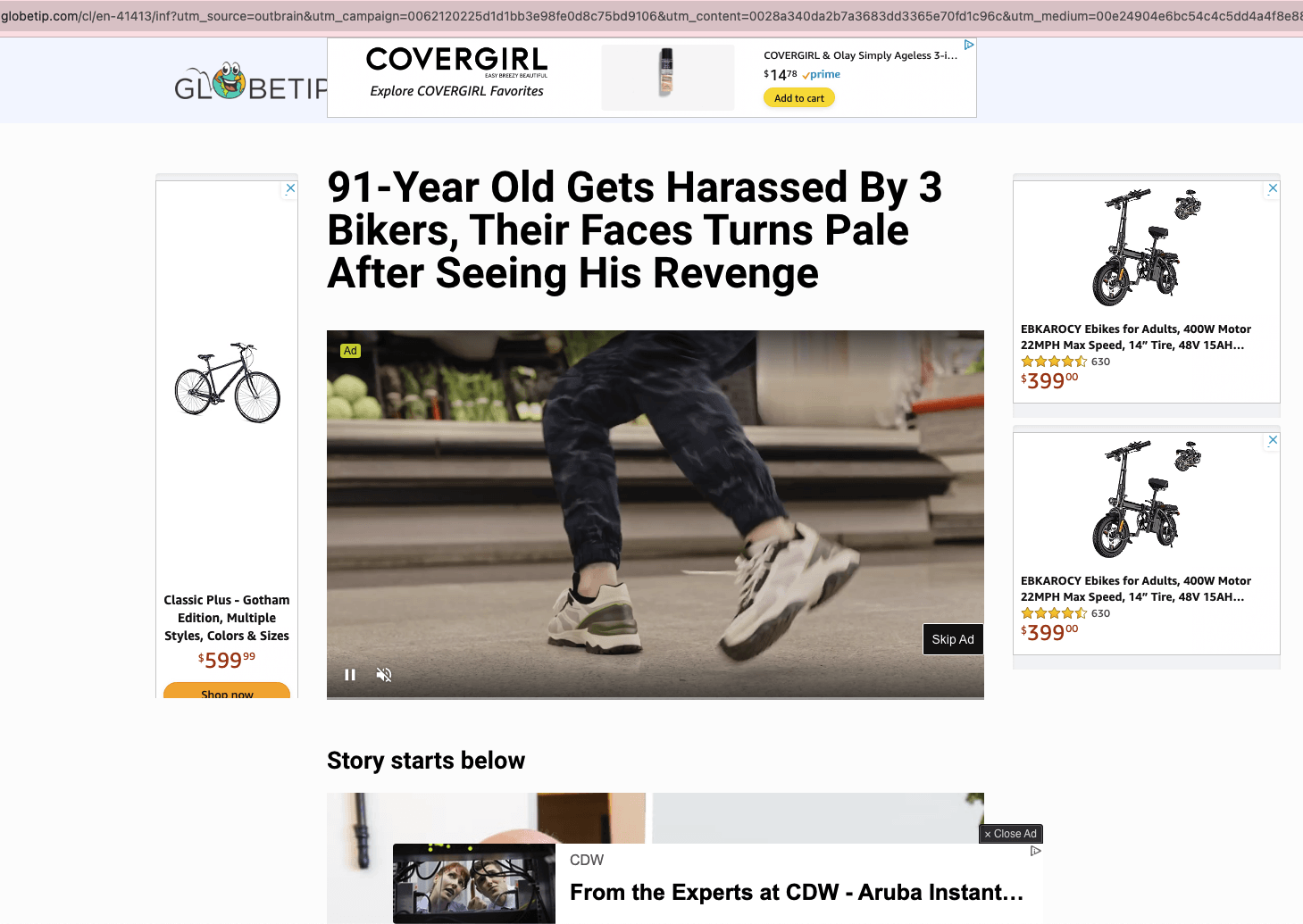
Screenshot of globetip.com after clicking an Outbrain ad. The website serves five ads.
Visiting the same exact page URL directly without any UTM string decorators shows far fewer ads on the page.
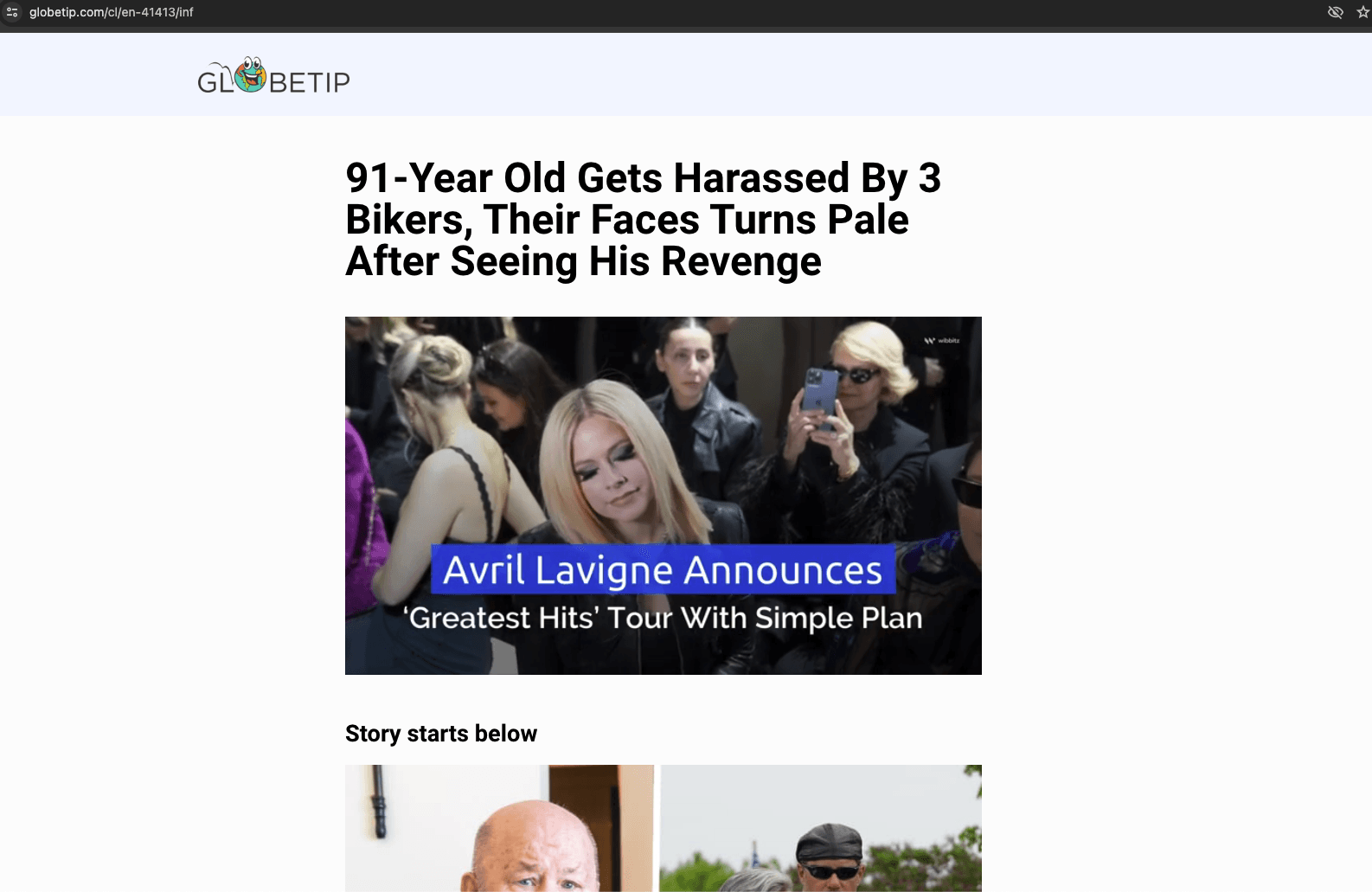
Screenshot of globetip.com after clicking directly typing in a page URL into the browser bar without any UTM string or query string parameters. No ads are visible.
The specific article on the website globetip.com, titled: “91-Year Old Gets Harassed By 3 Bikers, Their Faces Turns Pale After Seeing His Revenge” contains a “meta” tag in its source code that is set to “noindex”. This instructs crawlers such as Google search, Google news, and Bing search crawlers to avoid indexing a given page URL.
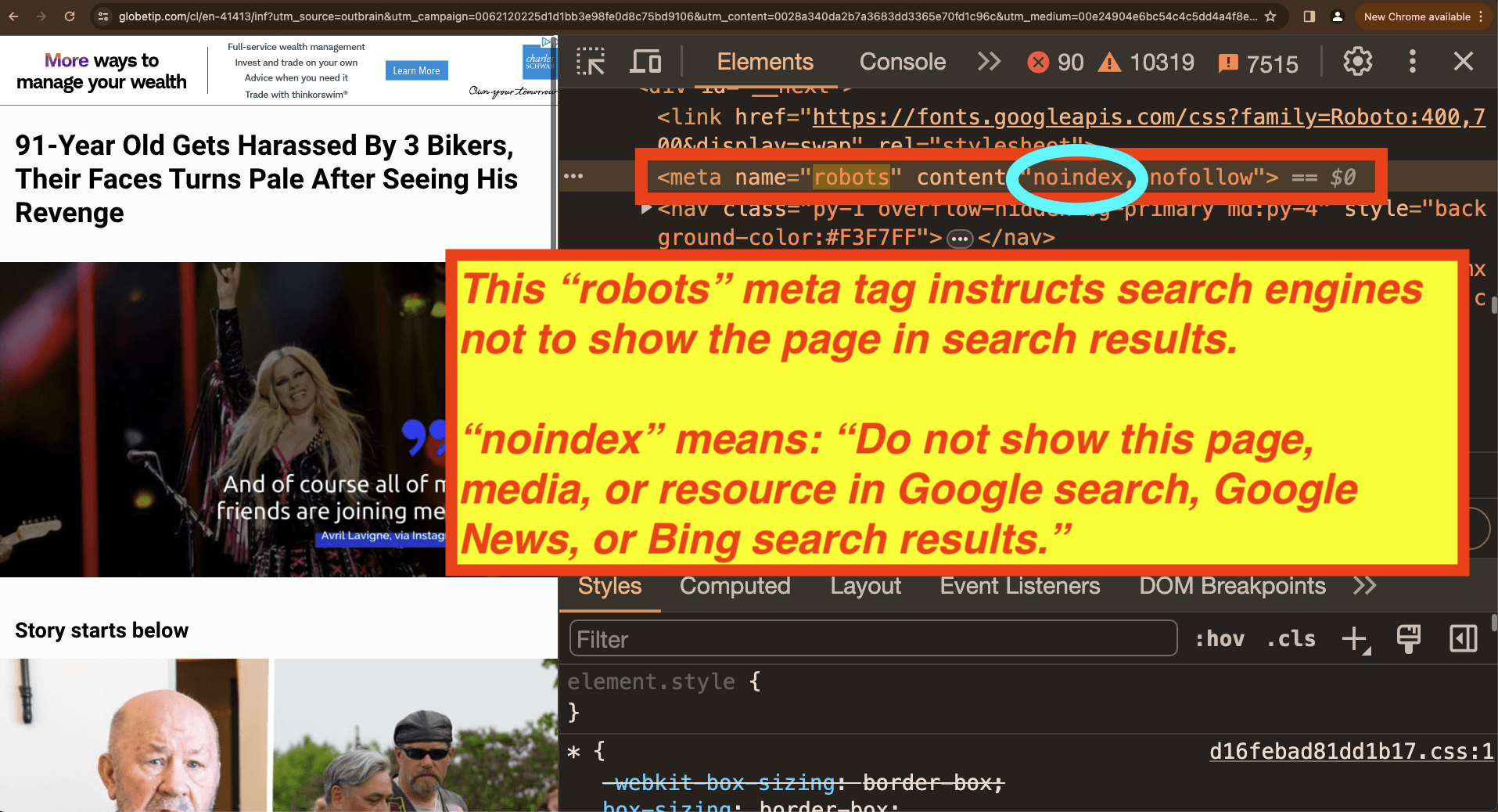
Screenshot of the source code on a particular globetip.com article, showing that the “robots” meta tag is configured to “noindex”. This instructs Google and Bing to not index or show search results for the given page.
A quick manual Google and Bing search confirms that this specific globetip.com article cannot be located in Google or Bing search.

Bing search query for ‘site:globetip.com "91-Year Old Gets Harassed By 3 Bikers, Their Faces Turns Pale After Seeing His Revenge"’. No results are returned as the page is hidden from search crawlers by the “noindex” attribute.
The website is observed serving hundreds of ad impressions in a few minutes after the consumer arrives on the page via an Outbrain ad.

A viewer being served hundreds of auto-refreshing ads on globetip.com
Considering the ownership and audience of the sample of putative “Made for Advertising” websites
One concern raised by many industry thought leaders is that blocking “Made for Advertising” websites may inadvertently result in also blocking of minority-owned publishers or diverse audience directed publishers.
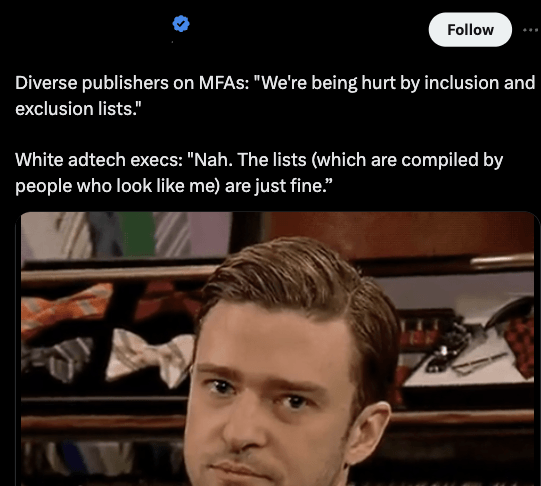
Source: X (fka Twitter)
According to AdMonsters, Jounce Media (one of the participants in the ANA Programmatic Transparency Study), “ According to Jounce Media’s data, Black-owned publishers are disproportionately *not* labeled as MFA.”
However, to account for these potential externalities and considerations, this study asked three programmatic media and ad tech experts to review the list of twenty two putative websites which appear to meet the ANA’s, WFA’s, ISBA’s, 4A’s, Jounce Media’s, and DeepSee.io’s definition of “Made for Advertising” website. The experts were asked to evaluate both the ownership and the audience focus of each website.
The three experts that were consulted with were:
a consultant on diverse and multicultural media who has worked at brands and agencies, and has been quoted in numerous trade press articles. The consultant asked not to be named.
Arielle Garcia, advisor & former chief privacy and responsibility officer at UM Worldwide media agency and columnist at AdExchanger
Nandini Jammi, the co-founder of Check My Ads Institute
The independent experts asserted that for each of the twenty two putative “Made for Advertising” websites, there was no evidence to suggest diverse ownership. The experts also asserted there was no declaration of diverse ownership on site, nor any self attestation of identity. The experts adjudicated that the sites had no stated diverse or multicultural audience focus.
The experts also noted that for some of the websites, it was not possible to identify the ownership of a site with the information provided on their respective webpages.
Some of the websites were described as being operated out of foreign countries.
Collecting data on “Made for Advertising” websites
After identifying a small sample of websites which meet industry tradegroup’s definition of “Made for Advertising” and are confirmed to be classified as MFA by DeepSee.io and/or Jounce Media, ad impression data was collected in January 2024 on this list of websites.
Data was gathered through an audience panel of volunteers using the Adalytics browser plugin, manual inspection, crawlers, some data extraction from internet archives such as URLScan.io or HTTP Archive, and other sources.
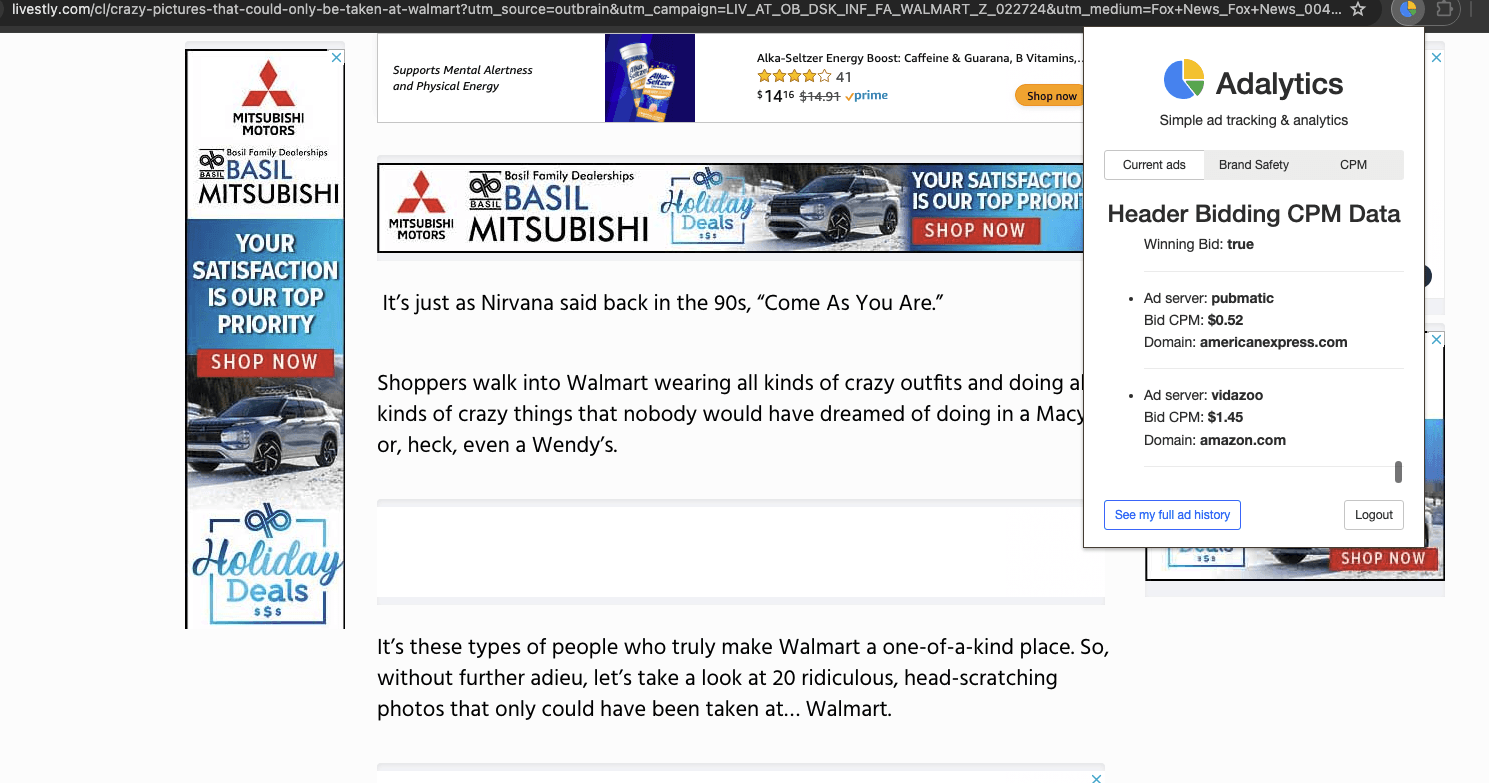
Screenshot of the Adalytics browser extension open
For each ad impression served on the sample list of MFA websites, several pieces of information were collected.
Firstly, the OpenRTB “adomain” (advertiser domain) or ad clickthrough URL for each ad was collected, in order to identify for which brand the ad was placed. For example, if the “adomain” or ad click through for a given ad observed on MFA site was “hrblock.com”, this was categorized as an apparent “H&R Block” ad. Note that this methodology has some caveats and requires some nuance in interpretation. For example, ads for which the “adomain” is “doubleclick.net” are actually redirected to another website domain, as this is an ad serving or tracking domain operated by Google’s ad systems.
Secondly, where possible, for each relevant ad, meta-data and source code was stored, parsed, and tagged in order to identify which Supply Side Platforms (SSPs) or ad exchanges were involved in transacting a given ad. For example, if an ad was served via the TripleLift header bidding adapter or contained an image pixel whose “src” (source) attribute was the endpoint “tlx.3lift.com/s2s/notify” or “tlx.3lift.com/header/notify”, the given ad on the MFA site was labeled as having been transacted by TripleLift ad exchange.
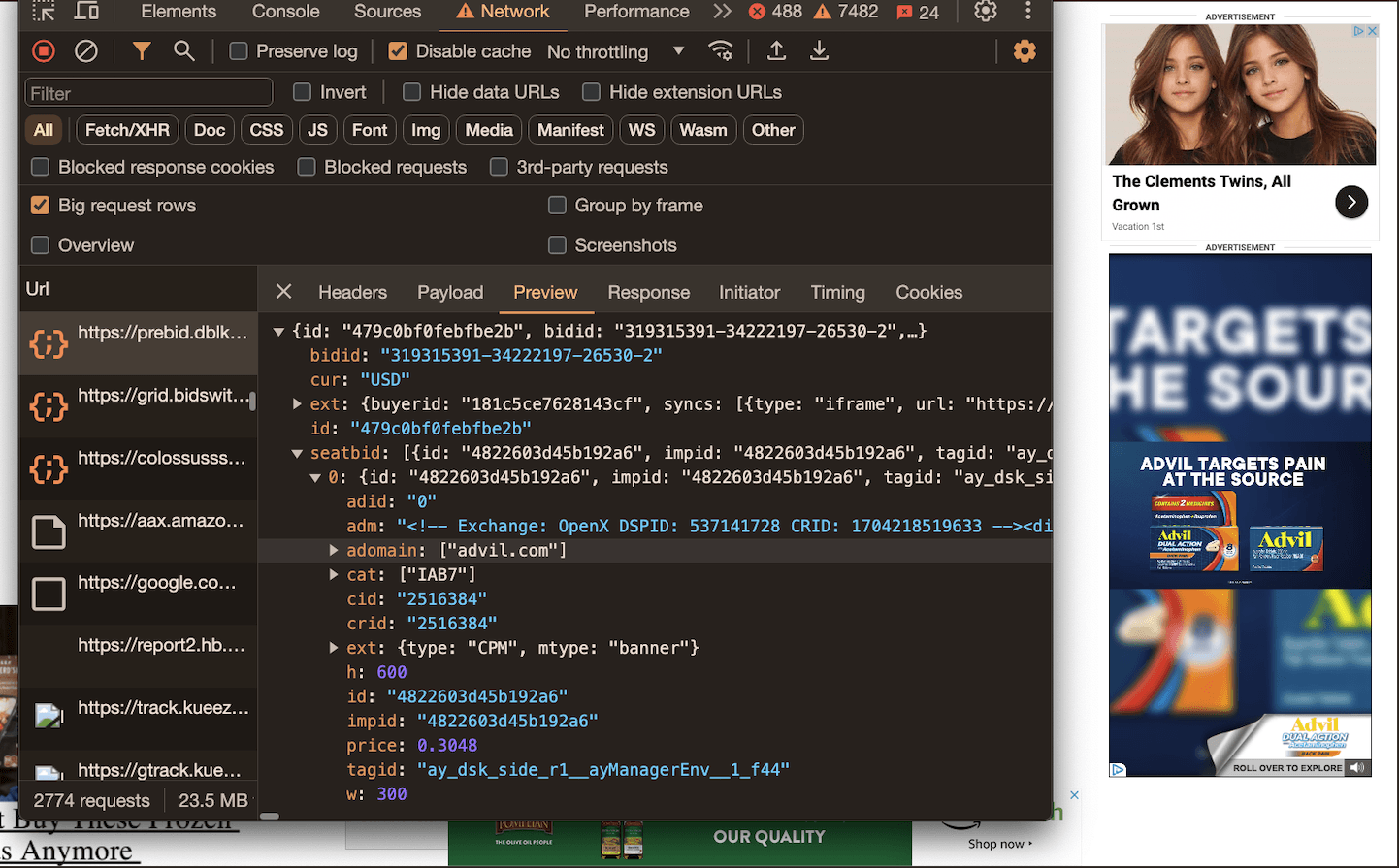
Screenshot of an ad, wherein the source code of the ad shows the adomain is “advil.com”. The source code of the ad shows the ad was transacted via OpenX SSP.
Similarly, the meta-data and source code of each ad observed on the list of MFA sites was tagged to determine which Demand Side Platform (DSP) was used to place an ad. For example, if the ad’s source code included references to “bid.adsrvr.org” or “googleads.g.doubleclick.net/dbm/ad” the ad was tagged as having been transacted via The Trade Desk or Google DV360 DSP, respectively.
The source code of each ad was analyzed to see which verification or measurement vendors received telemetry about a given ad impression. For example, ad impressions whose source code included references to “cdn.doubleverify.com/dvtp_src.js” or “pixel.adsafeprotected.com/jload” were labeled as having been measured by DoubleVerify or Integral Ad Science (IAS), respectively.
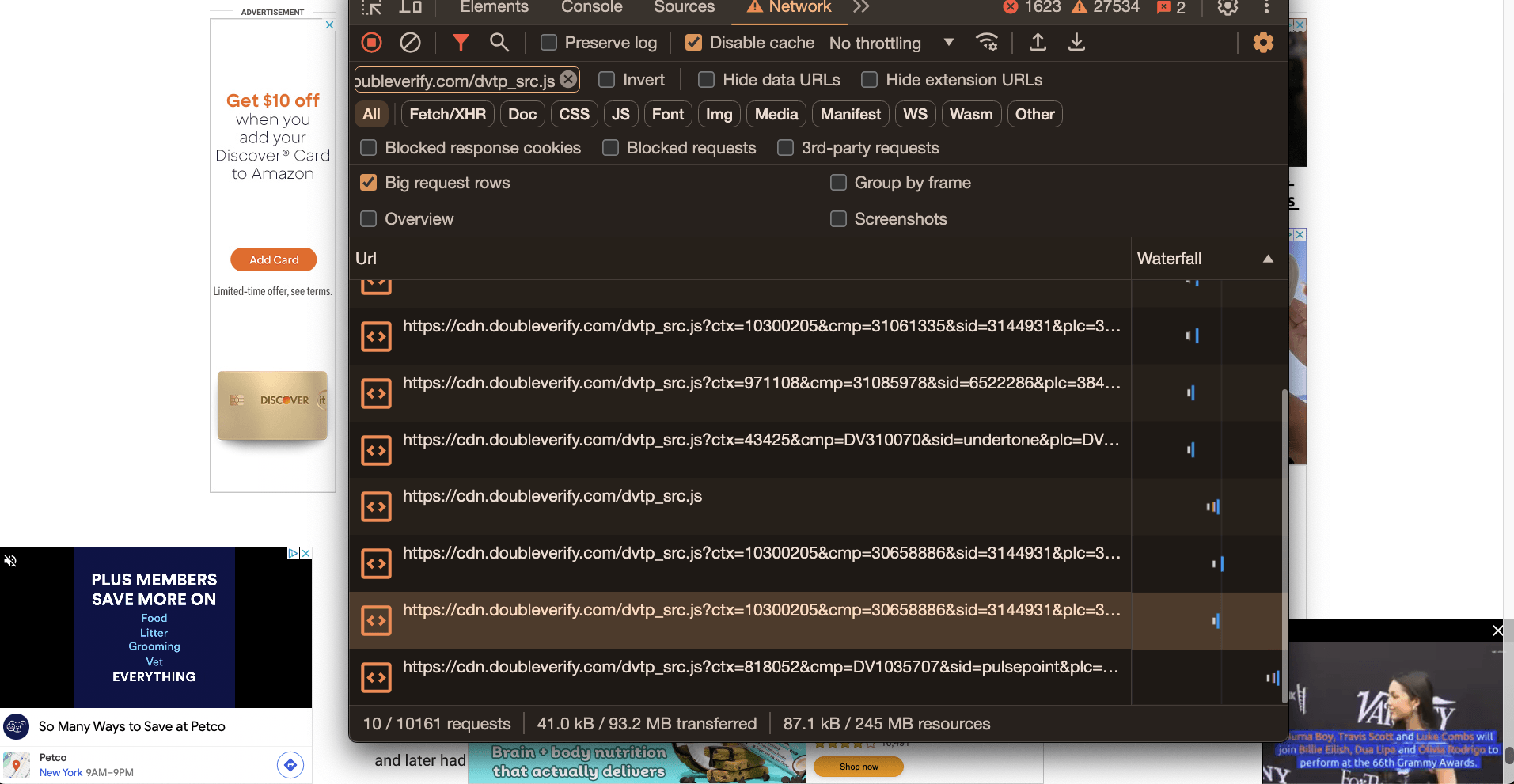
Screenshot showing DoubleVerify Javascript code being invoked multiple times from different ad creatives loading on a website.
The source code of some ads included Campaign Manager 360 (CM360) ad server pixels, which contain various high entropy or uniquely identifying strings. These CM360 ad server pixels occasionally indicate which agency was transacting a given ad. For example, in the screenshot below, one can observe ads for Ford on a MFA website, wherein the source code of the ad include CM360 pixels that contain the string “XAXISUSAHEADLIGHT” (Xaxis USA Headlight). Xaxis is the programmatic trading arm of WPP / GroupM.

Screenshot of Ford ad, wherein the source code of the Ford ad contains a CM360 ad server tracking pixel which contains the string “XAXISUSAHEADLIGHT”.
As another example, in the screenshot below, one can observe ads for CVS. The source code of the ad references a CM360 pixel with the string “MATTERKIND”. Matterkind is the former name of IPG’s programmatic trading desk. IPG lists CVS as one of its brand clients on its website.
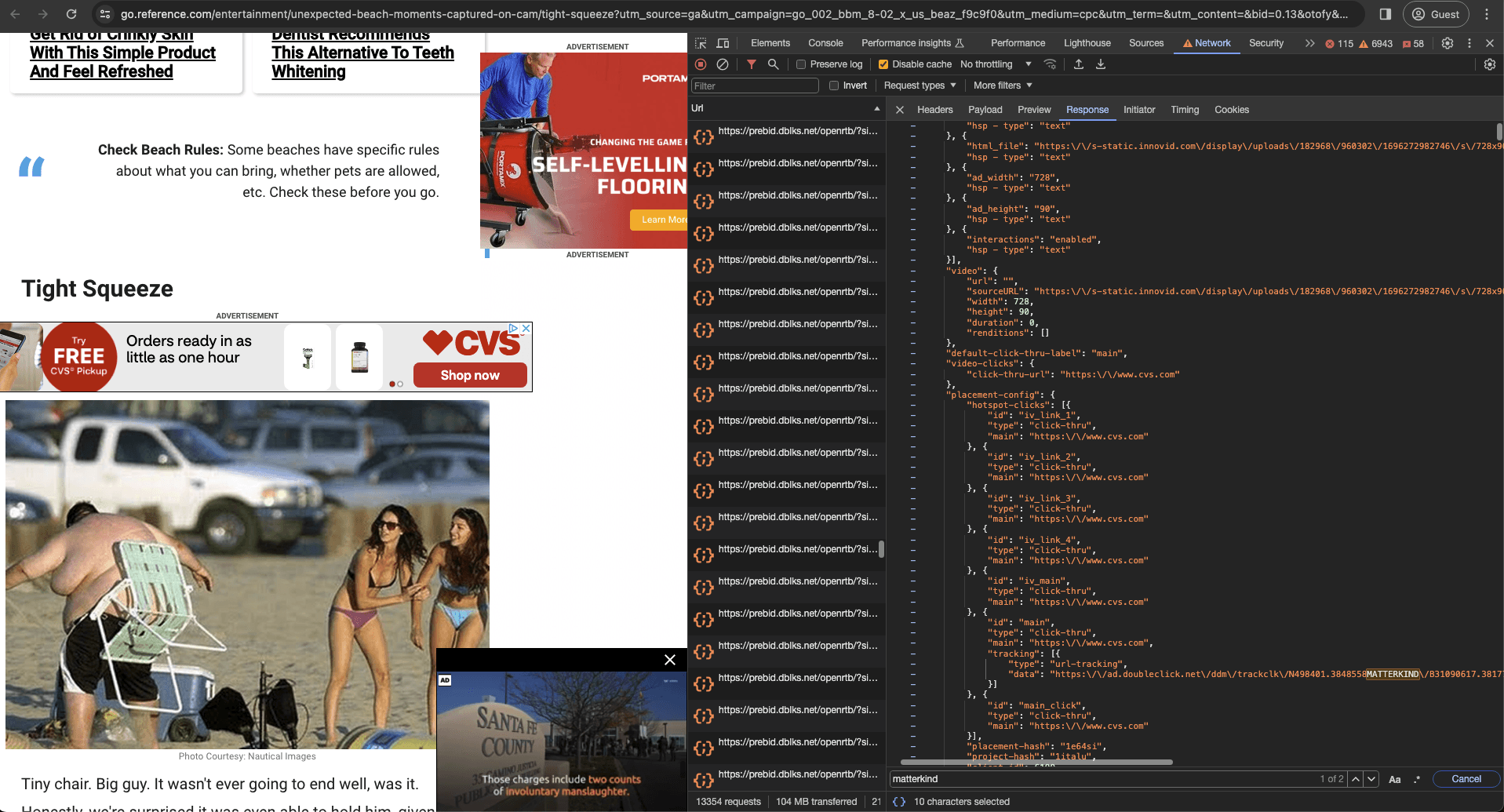
Screenshot of a CVS ad, wherein the source code of the CVS ad contains a CM360 ad server tracking pixel which contains the string “MATTERKIND”.
Some ads also contain a “Why this ad?” information modal, which includes details about which media agency is directing ad placement on behalf of a given brand. For example, in the screenshot below, one can see an ad for AT&T. The “Why this ad?” modal for the ad shows the ad was transacted by Omnicom’s Hearts & Science subsidiary.

Screenshot of a AT&T ad, wherein the “Why this ad?” section references “Hearts & Sciences”, a subsidiary of Omnicom media agency.
Lastly, for each ad impression, the total number of times a given consumer was shown ads from a given brand on a single MFA website in a single session was tracked. This information helps assess when a consumer was over-exposed to ads from a given brand due to ad refreshes on a MFA website. Furthemore, wherein available, the Adalytics browser plugin collected header bidding pricing data showing how much brands were paying certain media supply chain vendors for a given ad impression that was rendered. This information helped assess how much brands were paying to reach individual consumers on MFA pages.
Given this methodology, one must note that this report is not meant to be construed as a comprehensive or quantitative audit. It cannot assert whether one vendor transacts more or less “Made for Advertising” impressions relative to another. It cannot assert whether one particular brand or agency spent more or less than another on “Made for Advertising” websites in general. It cannot ascertain which participant in a media supply chain implicitly or explicitly made a decision to transact MFA. The scholastic, observational nature of this study simply allows a binary, qualitative assessment of whether or not a given vendor was observed transacting ads on websites which are consistent with consensus definitions of “Made for Advertising” in January 2024.
Results
Thousands of brands have their ads observed on “Made for Advertising” websites in 2024
Thousands of different brands and advertisers (as defined by distinct “adomains”) were observed to have their ads served in 2024 on the sample of websites which meet the ANA’s, WFA’s, ISBA’s, 4A’s, Jounce Media’s, and/or DeepSee.io’s definition of “Made for Advertising” website. Many of these brands were ANA members or even participants in the ANA’s 2023 Programmatic Transparency Study.
This included Fortune 500 brands such as Procter & Gamble, Hershey’s, Microsoft, Verizon, Google, AT&T, Disney, Meta, Mondelez, Mars, Clorox, Nike, General Motors, Johnson & Johnson, Charles Schwab, Apple, General Mills, Nestle, Wells Fargo, Pfizer, PepsiCo, Bayer, Reckitt Benckiser, Toyota, Amazon, Novartis, AstraZeneca, BMW, American Express, PwC, Opdivo (Bristol Myers Squibb), State Farm, Geico, and many others.
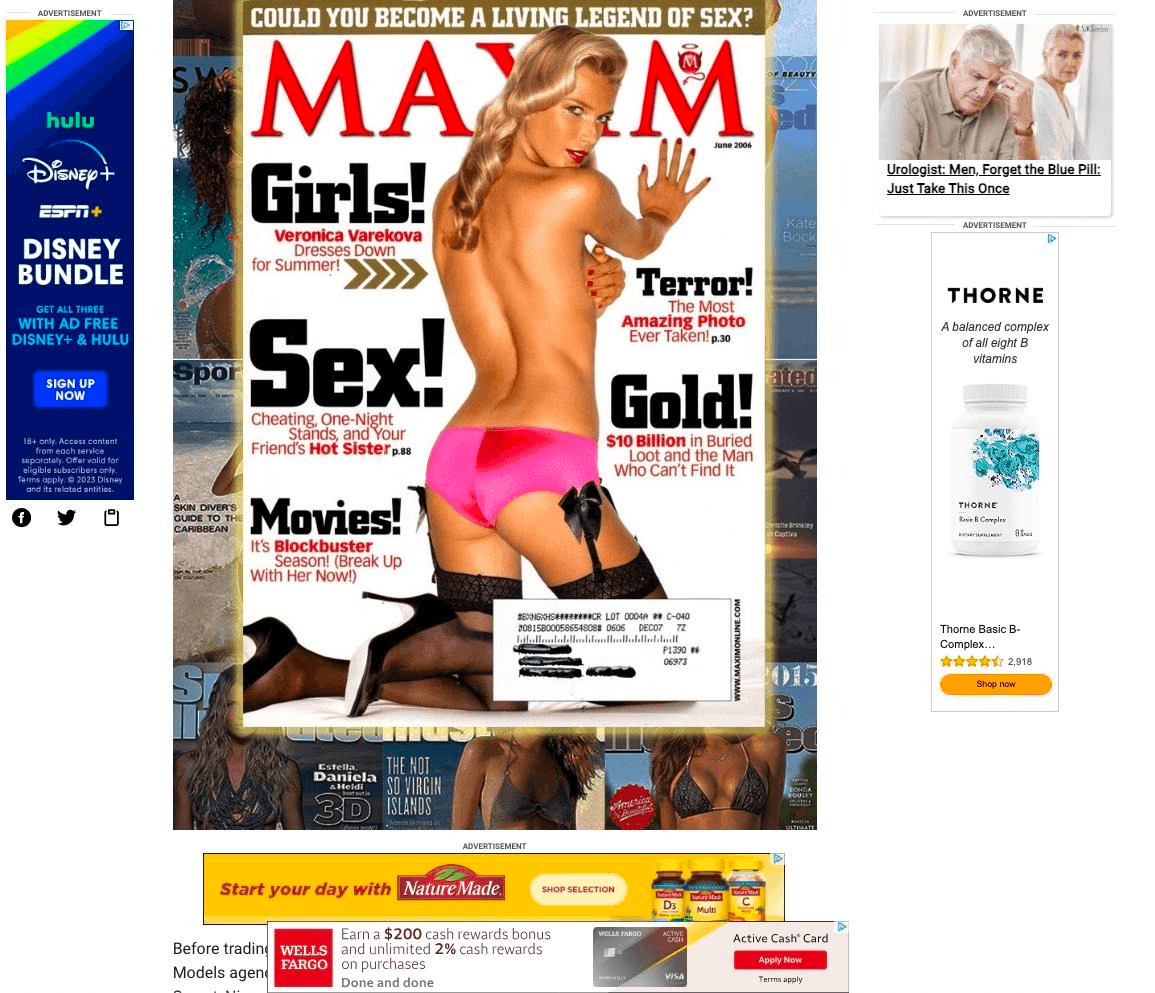
Screenshot from 2024 of Disney+, Wells Fargo and other ads observed on a website not affiliated with Maxim which meet’s the ANA’s, WFA’s, ISBA’s, 4A’s, Jounce Media’s, and DeepSee.io’s definition of “Made for Advertising” website.

Screenshot from 2024 of three American Express ads and a Norwegian cruise line ad observed on a website which meet’s the ANA’s, WFA’s, ISBA’s, 4A’s, Jounce Media’s, and DeepSee.io’s definition of “Made for Advertising” website.
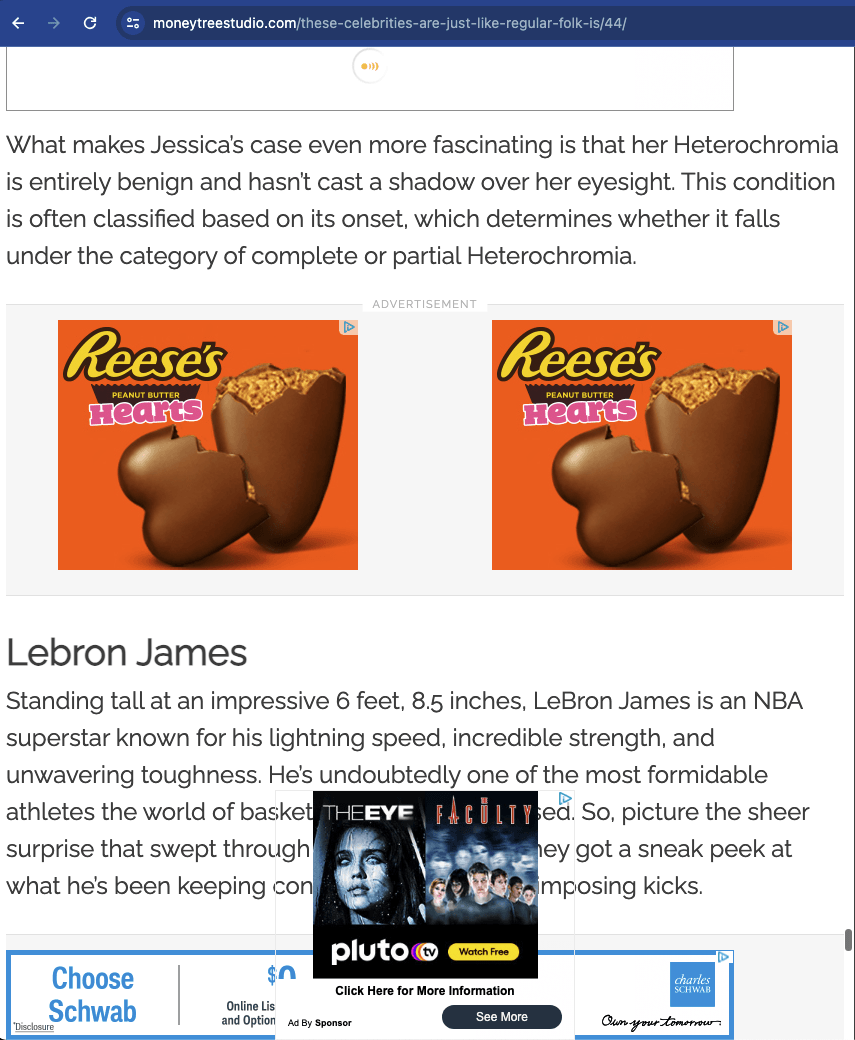
Example screenshot from 2024 of a Charles Schwab, PlutoTV, and two Hershey's Reese’s ads observed on a website which meet’s the ANA’s, WFA’s, ISBA’s, 4A’s, Jounce Media’s, and DeepSee.io’s definition of “Made for Advertising” website.

Screenshot of three Google Workspace ads observed on a website which meet’s the ANA’s, WFA’s, ISBA’s, 4A’s, Jounce Media’s, and DeepSee.io’s definition of “Made for Advertising” website.
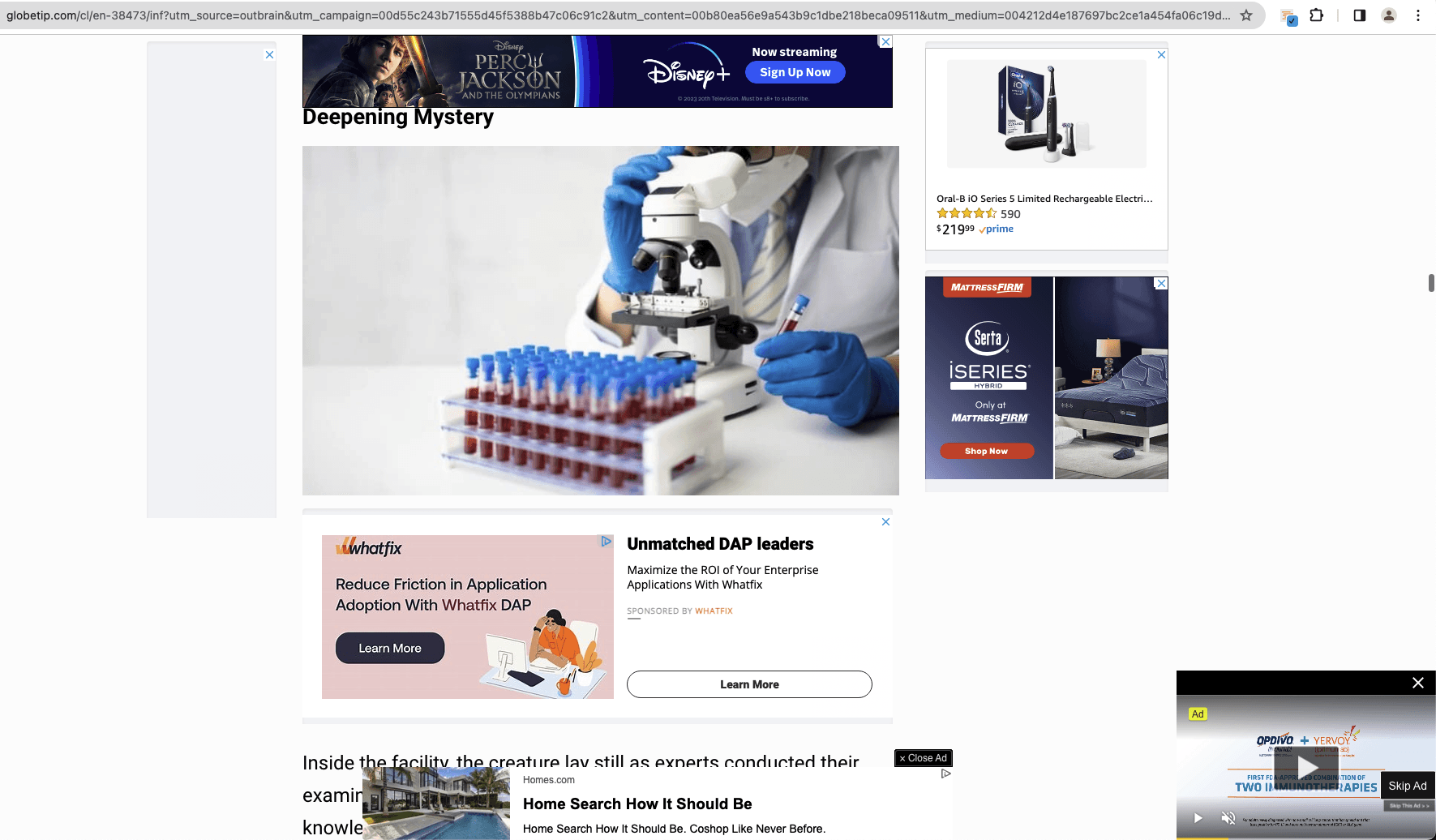
Screenshot from 2024 of a Disney+, MattressFirm, Bristol Myers Squibb (Opdivo) and Procter & Gamble (Oral-B) ad observed on a website which meet’s the ANA’s, WFA’s, ISBA’s, 4A’s, Jounce Media’s, and DeepSee.io’s definition of “Made for Advertising” website.

Screenshot from 2024 of a Clorox, YouTube TV, and other ads observed on a website which meets the ANA’s, WFA’s, ISBA’s, 4A’s, Jounce Media’s, and DeepSee.io’s definition of “Made for Advertising” website.
In addition to large brands, various non-profit organizations were observed to have their ads served on the aforementioned sample of websites in 2024 which meet the criteria for “Made for Advertising”. These include the AARP, Planned Parenthood, the UK National Trust, Unicef USA, Leukemia & Lymphoma Society, Salvation Army, Sydney Children's Hospitals Foundation, Moffitt Cancer Center, Alzheimer’s Association, American Heart Association, the Red Cross, and others.
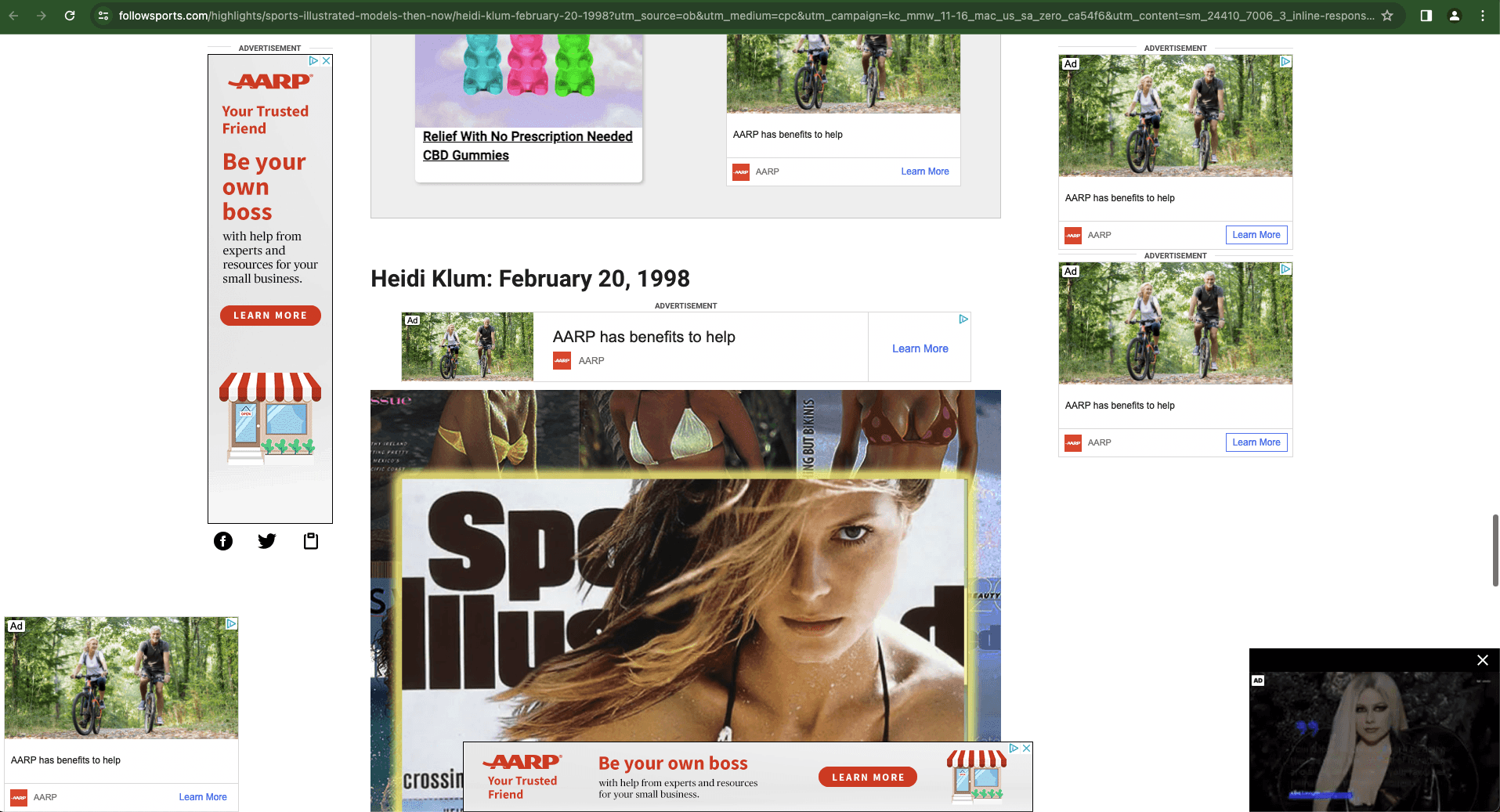
Screenshot from 2024 of six AARP ads observed on a website which meets the ANA’s, WFA’s, ISBA’s, 4A’s, Jounce Media’s, and DeepSee.io’s definition of “Made for Advertising” website not affiliated with Sports Illustrated.

Screenshot from 2024 of four Planned Parenthood ads observed on a website which meets the ANA’s, WFA’s, ISBA’s, 4A’s, Jounce Media’s, and DeepSee.io’s definition of “Made for Advertising” website.
Various government and military organizations were also observed to have their ads served on the aforementioned sample of websites in 2024 which meet the criteria for “Made for Advertising”. These include the US Federal Trade Commission (FTC), US Federal Bureau of Investigation (FBI), UK MI5 Security Service (UK’s domestic counterintelligence agency), US Drug Enforcement Administration (DEA), UK GCHQ’s (UK’s signals intelligence agency), US Social Security Administration (SSA), the SUS Intelligence Community, US Department of State, US Department of Transportation, US CDC, US Department of Health & Human Services, US Treasury, US Internal Revenue Service (IRS), US Department of the Interior, US Department of Agriculture, US Department of Veterans Affairs, US Air Force, US Army, US Coast Guard, US Navy, New York City Police Department, the Australian Defence Force, the Australian Department of Social Services, the Australian Sports Commission, and many state, provincial and municipal government entities.
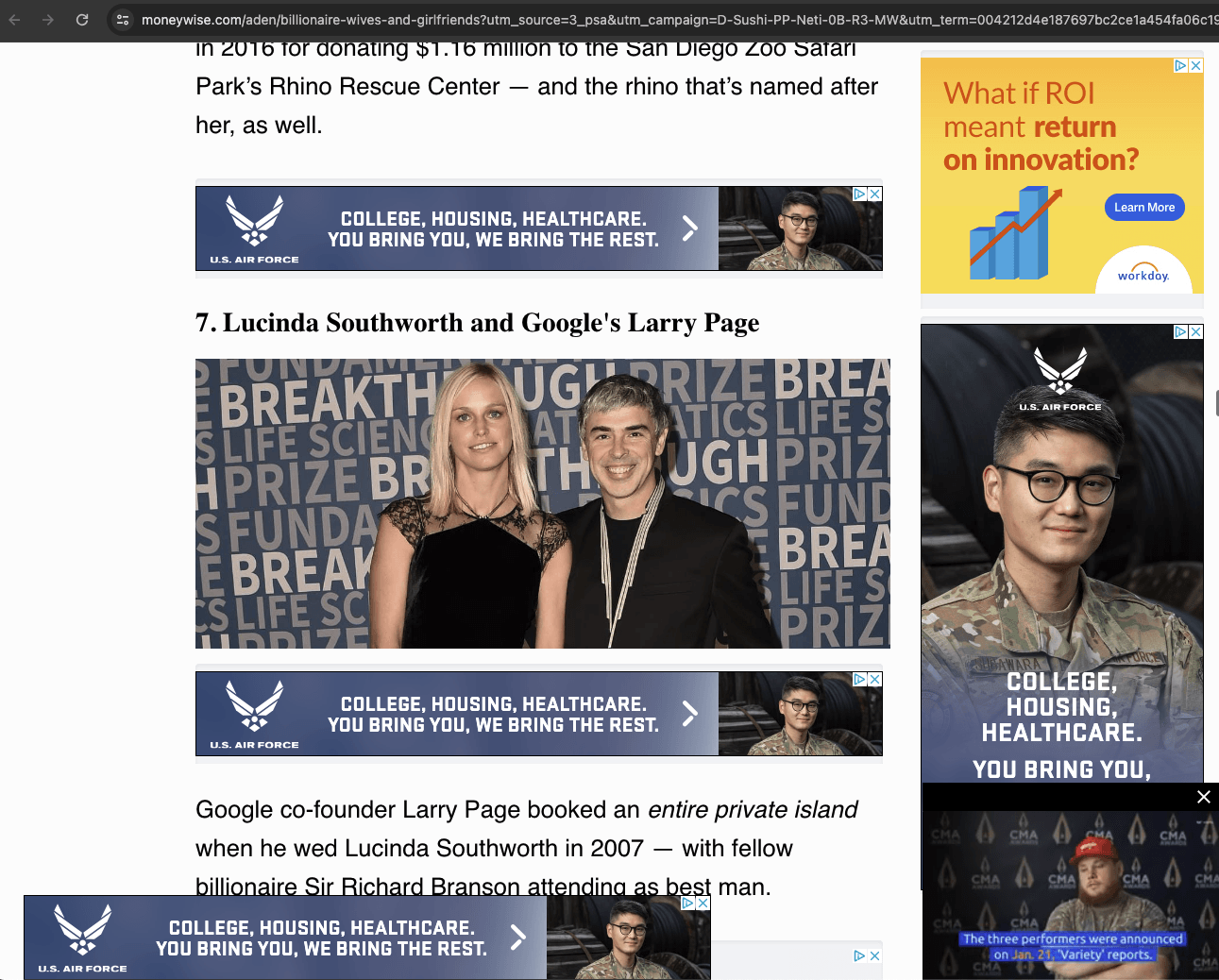
Screenshot from 2024 of four US Air Force ads observed on a website which meets the ANA’s, WFA’s, ISBA’s, 4A’s, Jounce Media’s, and DeepSee.io’s definition of “Made for Advertising” website.

Screenshot from 2024 of a Federal Trade Commission (FTC) ad observed on a website not affiliated with Maxim which meets the ANA’s, WFA’s, ISBA’s, 4A’s, Jounce Media’s, and DeepSee.io’s definition of “Made for Advertising” website. The ad was transacted via Zeta Global DSP, Magnite SSP (seller ID 17960), and Sovrn SSP. Two Verizon ads (one stacked on the second one) are visible below.
In the data table below, one can observe which advertisers’ ads were observed most frequently on the sample of aforementioned “Made for Advertising” websites in January 2024. For example, H&R Block ads were seen far more frequently than any other individual brand’s ads on “Made for Advertising” sites.

Bar plot illustrating which advertisers’ ads were observed most frequently in January 2024 on a sample of websites which meet the ANA’s, WFA’s, ISBA’s, 4A’s, Jounce Media’s, and DeepSee.io’s definition of “Made for Advertising” website.
16 out of 17 disclosed brands who participated in the ANA’s Programmatic Transparency study were observed having ads served on “Made for Advertising” sites in 2024
The Association of National Advertisers (ANA)’s 2023 Programmatic Media Supply Chain Transparency Study sourced data and worked with “21 marketer participants include a range of big, mid-size, and smaller companies and there was representation from 11 categories.” 17 out of the 21 participants allowed their identities to be publicized; these included:
Nissan
Shell
StateFarm
Walgreens
Kaiser Permanente
St Jude Children’s Research Hospital
Little Caesars
White Castle
Molson Coors
Nascar
PGA Tour
Dell Technologies
HP
Discover
Kenvue
Kimberly-Clark
Mondelez International

Twenty-one marketers participated in the ANA’s 2023 Programmatic Transparency Study. The 21 marketer participants include a range of big, mid-size, and smaller companies and there was representation from 11 categories. 17 of the 21 brands allowed themselves to be publicly cited in the ANA’s report. Of these 17 brands, 16 were observed to have had their ads served on “Made for Advertising” websites in January 2024.
Of these seventeen disclosed participants in the ANA’s 2023 study, sixteen were observed to have ad impressions served in January 2024 on the aforementioned sample of websites which meet the ANA’s, WFA’s, ISBA’s, 4A’s, Jounce Media’s, and DeepSee.io’s definition of “Made for Advertising”.
For example, in the screenshots from 2024 below, one can observe ads for Molson Coors, Discover, Kenvue, Dell Technologies, Mondelēz International, and State Farm observed on various websites described in the aforementioned “Methodology” section of this report.
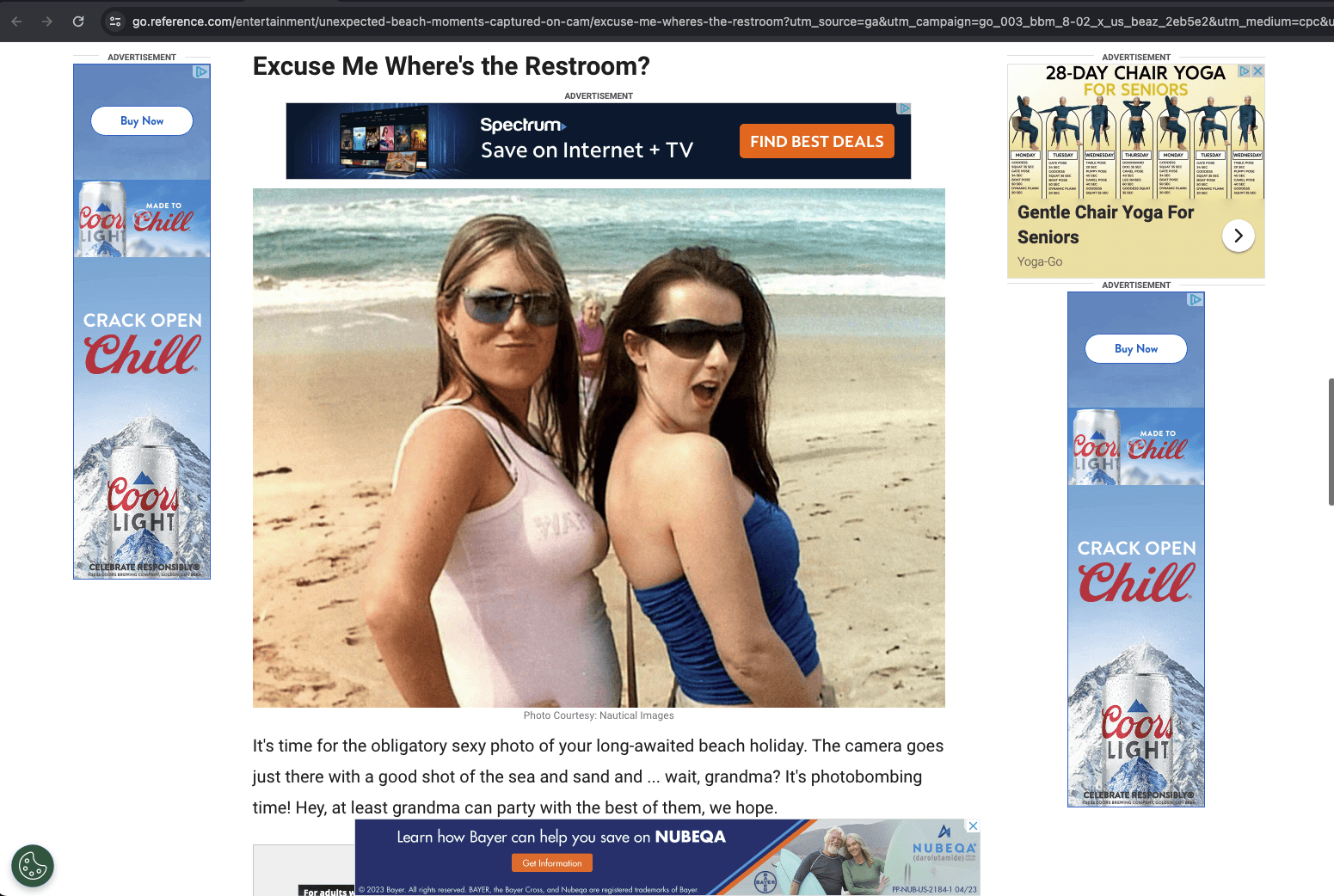
Screenshot from 2024 showing two Molson Coors ads observed on a website which meets the ANA’s, WFA’s, ISBA’s, 4A’s, Jounce Media’s, and DeepSee.io’s definition of “Made for Advertising” website. Molson Coors was one of 17 disclosed participants in the ANA’s 2023 Programmatic Transparency Study. Visible on the page also is an ad from Bayer (Nubeqa).

Screenshot from 2024 showing a Discover ad observed on a website which meets the ANA’s, WFA’s, ISBA’s, 4A’s, Jounce Media’s, and DeepSee.io’s definition of “Made for Advertising” website. Discover was one of 17 disclosed participants in the ANA’s 2023 Programmatic Transparency Study. Visible on the page also are ads from Nikon, NBCUniversal's Peacock, and Mars’ M&M’s.

Screenshot from 2024 showing a Kenvue (Tylenol) and a Dell Technologies ad observed on a website which meets the ANA’s, WFA’s, ISBA’s, 4A’s, Jounce Media’s, and DeepSee.io’s definition of “Made for Advertising” website. Kenvue and Dell Technologies was two of 17 disclosed participants in the ANA’s 2023 Programmatic Transparency Study.

Screenshot from 2024 showing a Mondelēz International’s belVita ad observed on a website which meets the ANA’s, WFA’s, ISBA’s, 4A’s, Jounce Media’s, and DeepSee.io’s definition of “Made for Advertising” website. Mondelēz was one of 17 disclosed participants in the ANA’s 2023 Programmatic Transparency Study.
State Farm, which was one of the 17 disclosed participants in the ANA’s Programmatic Transparency Study, was cited in a January 2024 Digiday article as having adopted “the shared standards and best practices from both ANA and its own initiative.” The article further mentions: “As a State Farm partner, Omnicom Media Group has been a game-changer for our programmatic media strategy,” said Alyson Griffin, head of marketing at State Farm. “Understanding where our ads are delivered and how they’re purchased are a key part of proving the effectiveness of our advertising.””
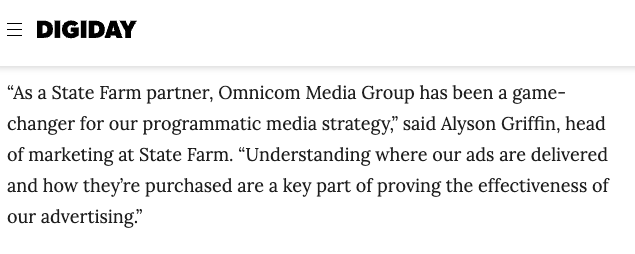
Source: Digiday
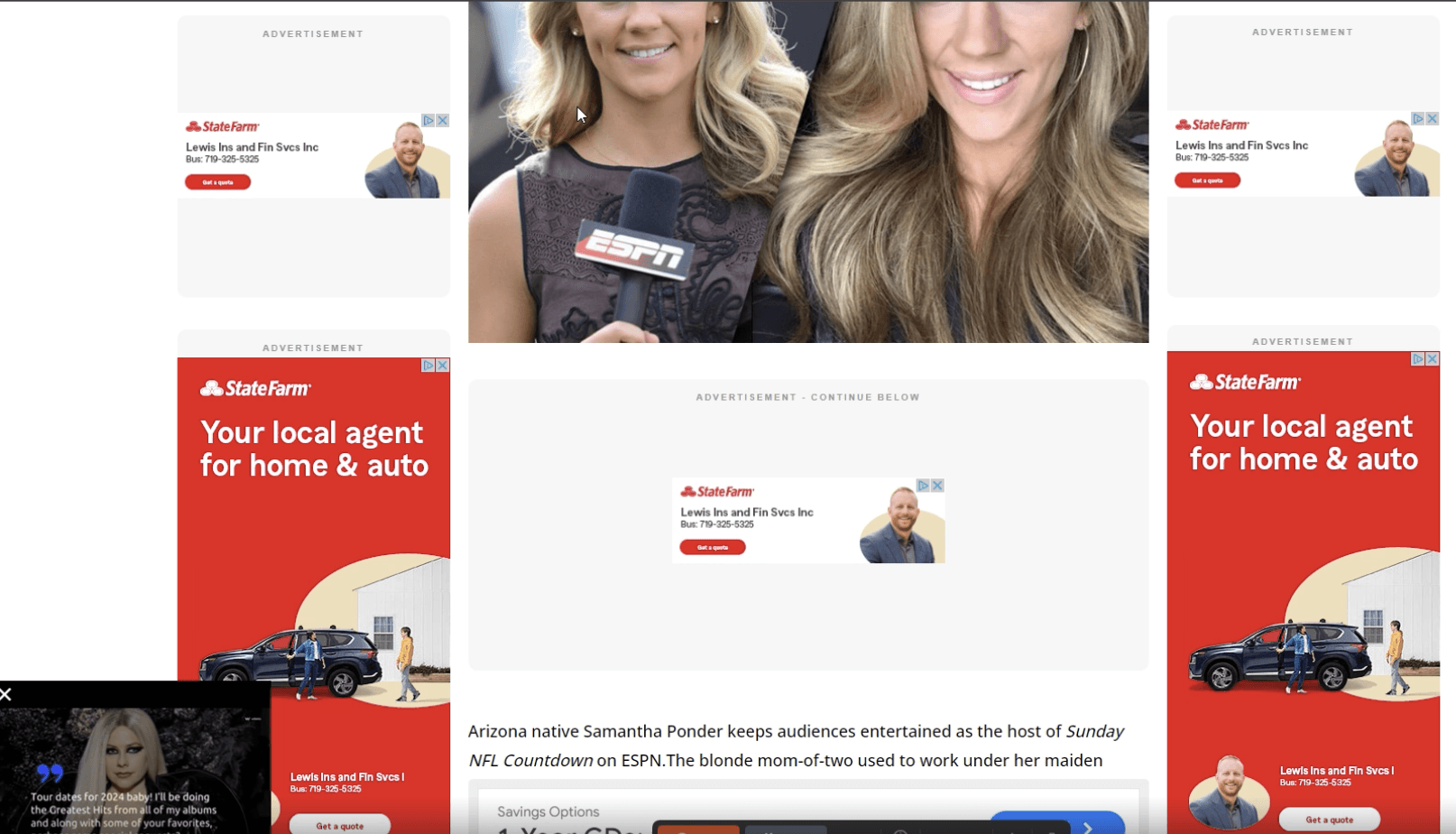
Screenshot showing five State Farm ads served on a website which meet’s the ANA’s, WFA’s, ISBA’s, 4A’s, and DeepSee.io’s definition of “Made for Advertising” website. State Farm was one of 17 disclosed participants in the ANA’s 2023 Programmatic Transparency Study.
In addition to companies which participated in ANA’s 2023 Programmatic Transparency Study as advertisers, PricewaterhouseCoopers (PwC) participated in the study as a service provider.

Screenshot from the ANA’s 2023 Programmatic Transparency Study, showing that PwC US was listed as a vendor.
Digiday reported that: “In December 2021 The Association of National Advertisers confirmed PricewaterhouseCoopers as lead partner for a landmark study geared toward bringing further transparency into the programmatic media-buying landscape. Although, 18 months later, the pairing has run its course after the ANA ended the relationship over dissatisfaction with PwC’s performance.”
Ads promoting PwC were also observed on the aforementioned sample of “Made for Advertising” websites in January 2024. For example, in the screenshot below one can observe three simultaneous ad for PwC served on a website which meet’s the ANA’s, WFA’s, ISBA’s, 4A’s, Jounce Media’s, and DeepSee.io’s definition of “Made for Advertising” website.

Screenshot from 2024 showing three PwC ads observed on a website which meet’s the ANA’s, WFA’s, ISBA’s, 4A’s, Jounce Media’s, and DeepSee.io’s definition of “Made for Advertising” website. PwC was “awarded the job” of executing the ANA’s 2023 Programmatic Transparency Study.
Ad tech vendors observed transacting brands’ ads on “Made for Advertising” websites in 2024
As described in the “Methodology” section of this report earlier, when ads were observed serving on the sample of websites which meet the ANA’s, WFA’s, ISBA’s, 4A’s, Jounce Media’s, and DeepSee.io’s definition of “Made for Advertising” website, the source code and meta-data of each ad was stored, processed, and analyzed. This digital forensics analysis allowed determination of which Supply Side Platforms (SSPs) or ad exchanges, Demand Side Platforms (DSPs), verification vendors, and data providers were involved in transacting a given brand’s ads on a “made for advertising” website.
Ad exchanges and supply side platforms observed transacting brands’ ads on “Made for Advertising websites in 2024

Annotated screenshot of the Association of National Advertisers (ANA’s) “Meet the SSPs” showcase event on March 7th, 2024. Eighty percent of the SSPs invited to present at the ANA event were confirmed to serve multiple ANA members’ ads on websites which meet the ANA’s, WFA’s, ISBA’s, 4A’s, Jounce Media’s, and DeepSee.io’s definition of “Made for Advertising” website.
Many SSPs or ad exchanges were observed to serve thousands of different brands’ ads on the sample of MFA websites.
This includes SSPs, ad networks, ad exchanges, publisher yield optimization services, or other types of ad delivery platforms, including:
Google Ad Manager (GAM) and related ad delivery or bidding systems
Magnite
Xandr
33Across
Pubmatic
Conversant
MediaGrid
TripleLift
Index Exchange
Sovrn
Next Millennium
OpenX
Colossus
Media.net
Yieldmo
Rise Codes
AdaptMX-AMX
Microsoft Audience Network
Sharethrough
Criteo
Sonobi
PulsePoint / ContextWeb
Nativo
Unruly-Termor International-Nexxen
Teads
ADYOULIKE-OpenWeb
Smart AdServer-Equativ
RichAudience
OneTag
Minute Media
GumGum
LoopMe
Brightcom
Ogury
Seedtag
Qortex AI
Adagio
Disqus-Zeta Global
Vidazoo
For example, Magnite was observed transacting ads for 11,671 different brands on the sample of MFA websites in 2024, including ads for brands such:
United States Federal Trade Commission (FTC)
Procter & Gamble
State Farm
US Army
Hershey’s
American Express
H&R Block
Nestle
Comcast
Sanofi
Expedia
Disney
Johnson & Johnson
Lowes
Dell
Pfizer
NBCUniversal
Toyota
USAA
Ford
Paramount
Southwest airlines
Coca-Cola
Verizon
Clorox
Haleon
Discovery

Screenshot from 2024 of a Federal Trade Commission (FTC) ad observed on a website which meets the ANA’s, WFA’s, ISBA’s, 4A’s, Jounce Media’s, and DeepSee.io’s definition of “Made for Advertising” website not affiliated with Maxim. The ad was transacted via Zeta Global DSP, Magnite SSP (seller ID 17960), and Sovrn SSP. Two Verizon ads (one stacked on the second one) are visible below.
Pubmatic (which appears to have deleted or removed its June 2023 announcement “Advancing Responsible Media By Removing MFA Inventory From Auction Packages”) was observed transacting ads for 7,588 different brands on the sample of MFA websites in 2024, including ads for brands such:
State Farm
InterContinental Hotels Group
Ford
Hershey’s
American Express
Sanofi
Gerber Life
MI5 / UK Security Service (the UK government’s domestic counterintelligence agency)
Planet Fitness
Vrbo
Comcast
H&R Block
Dell
Disney
Microsoft
United airlines
Pfizer
Kroger
US Bank
ESPN
Home Depot
TripleLift was observed transacting ads for 8,451 different brands on the sample of MFA websites in 2024, including ads for brands such:
Procter & Gamble
Mars
Hershey’s
Mondelez International
Clorox
US Centers for Disease Control (CDC
JMorgan Chase
American Express
Apple
Disney
Planet Fitness
Dell
US Army
Nestle
Microsoft
Sanofi
Haleon
NBCUniversal
Pfizer
Charles Schwab
Samsung
Nike
Paramount
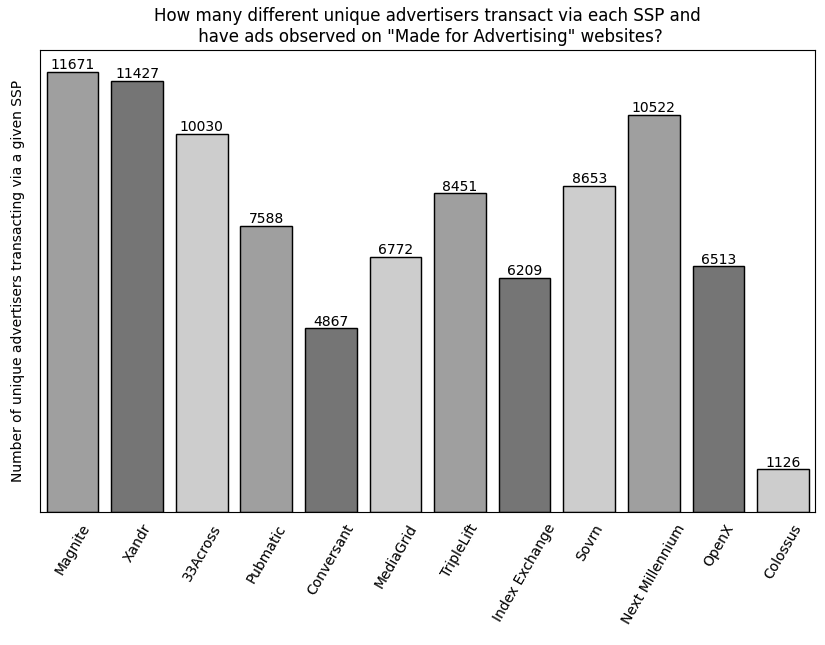
Bar graph illustrating the number of distinct “adomains” (advertisers) observed transacting ads via a given SSP on the websites in the sample of websites which meet various definitions of “Made for Advertising”.
In the histogram below, one can observe the relative abundance or frequency of ads transacted via various SSP or ad delivery platforms on the sample of websites which meet various definitions of “Made for Advertising” in January 2024.
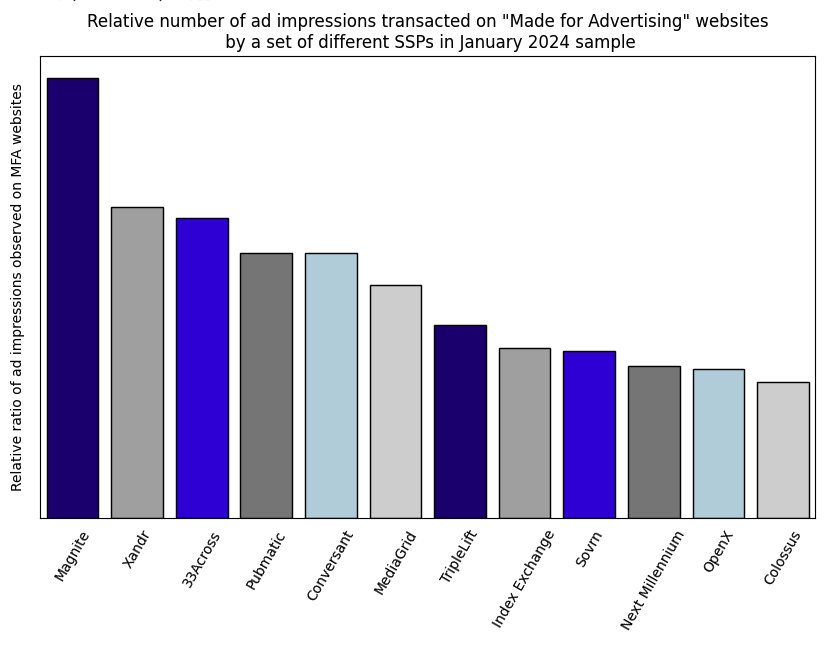
Histogram illustrating the relative number of ad impressions transacted by various SSPs or ad serving platforms in a January 2024 sample of various websites which meet various definitions of “Made for Advertising”.
Many brands appear to be transacting on the sample of “Made for Advertising” websites dozens of different supply paths or via reseller chains. It is unclear whether or how the decision to transact via so many distinct supply paths is consistent with media buyers’ Supply Path Optimization (SPO) efforts.
For example, American Express was observed transacting MFA ads via: Google Ad Manager, RichAudience, Pubmatic, Index Exchange, AdaptMX-AMX, TripleLift, OpenX, Magnite, Colossus, Sovrn, Media.net, 33Across, Next Millennium, MediaGrid, Criteo, Xandr, Unruly-Termor International-Nexxen, Sharethrough, Nativo, Minute Media, Yieldmo, GumGum, Sonobi, Conversant, Brightcom, and others.
Disney was similarly observed transacting through several dozen different supply paths on “Made for Advertising” websites, including Google Ad Manager, Pubmatic, Magnite, Index Exchange, Sovrn, OpenX, AdaptMX-AMX, Media.net, TripleLift, MediaGrid, 33Across, Next Millennium, Xandr, Conversant, RichAudience, Qortex AI, Smart AdServer-Equativ, Colossus, Rise Codes, Minute Media, Sharethrough, Adagio, Unruly-Termor International-Nexxen, Ogury, Nativo, Brightcom, GumGum, LoopMe, PulsePoint / ContextWeb, Yieldmo, and OneTag.
State Farm was observed transacting on “Made for Advertising” websites via Sonobi, Pubmatic, Magnite, Rise Codes, Sovrn, Minute Media, 33Across, Smart AdServer-Equativ, Conversant, TripleLift, MediaGrid and a few others.
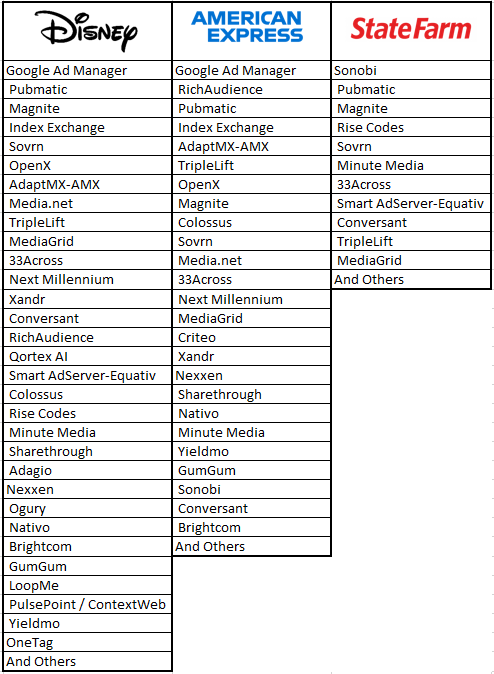
Some brands were observed transacting through a relatively smaller number of distinct SSPs on “Made for Advertising” websites, though one must be careful drawing conclusions from this due to inherent sampling biases and stochasticity. Procter & Gamble was observed transacting on “Made for Advertising’ websites through a relatively smaller number of ad exchanges, including Index Exchange, Sovrn, Pubmatic, and Triplelift. Similarly, Unilever was observed transacting on MFA websites through Pubmatic, Sovrn, Magnite, Media.net, MediaGrid, and Unruly-Tremor International-Nexxen.
Demand side platforms observed transacting brands’ ads on “Made for Advertising” websites in 2024
In addition to evaluating which specific SSPs or ad exchanges were involved in transacting a given brands’ ads on the sample of websites which meet various definitions of “Made for Advertising” in January 2024, each ad impression was also examined to infer what Demand Side Platform or ad buying network was involved in transacting a given ad.
The list of demand side platforms (DSPs), ad buying platforms or networks, bidders, or managed buy vendors who were observed transacting ads on the aforementioned of “Made for Advertising” websites in January 2024 includes:
Google DV360
Amazon
Conversant
Xandr
Quantcast DSP
Yahoo DSP
StackAdapt
Zemanta
molocoads DSP
Beeswax
Adelphic
Genie by Media Force
Adobe Advertising Cloud
InMobi DSP
Appier
Smadex DSP
Cognitiv DSP
Amobee DSP
Criteo
DeepIntent Healthcare DSP
Zeta Global
Exponential
PulsePoint
Kayzen
Loopme
Roku Oneview (DataXu)
Simpli.fi
RTB House
MaxPoint-Valassis Digital
Cox Automotive DSP
Cluep
Travel Audience GmbH
AdTheorent
GroundTruth
Samsung DSP (AdGear)
Sift Media
InMarket/ThinkNear
MediaGo DSP
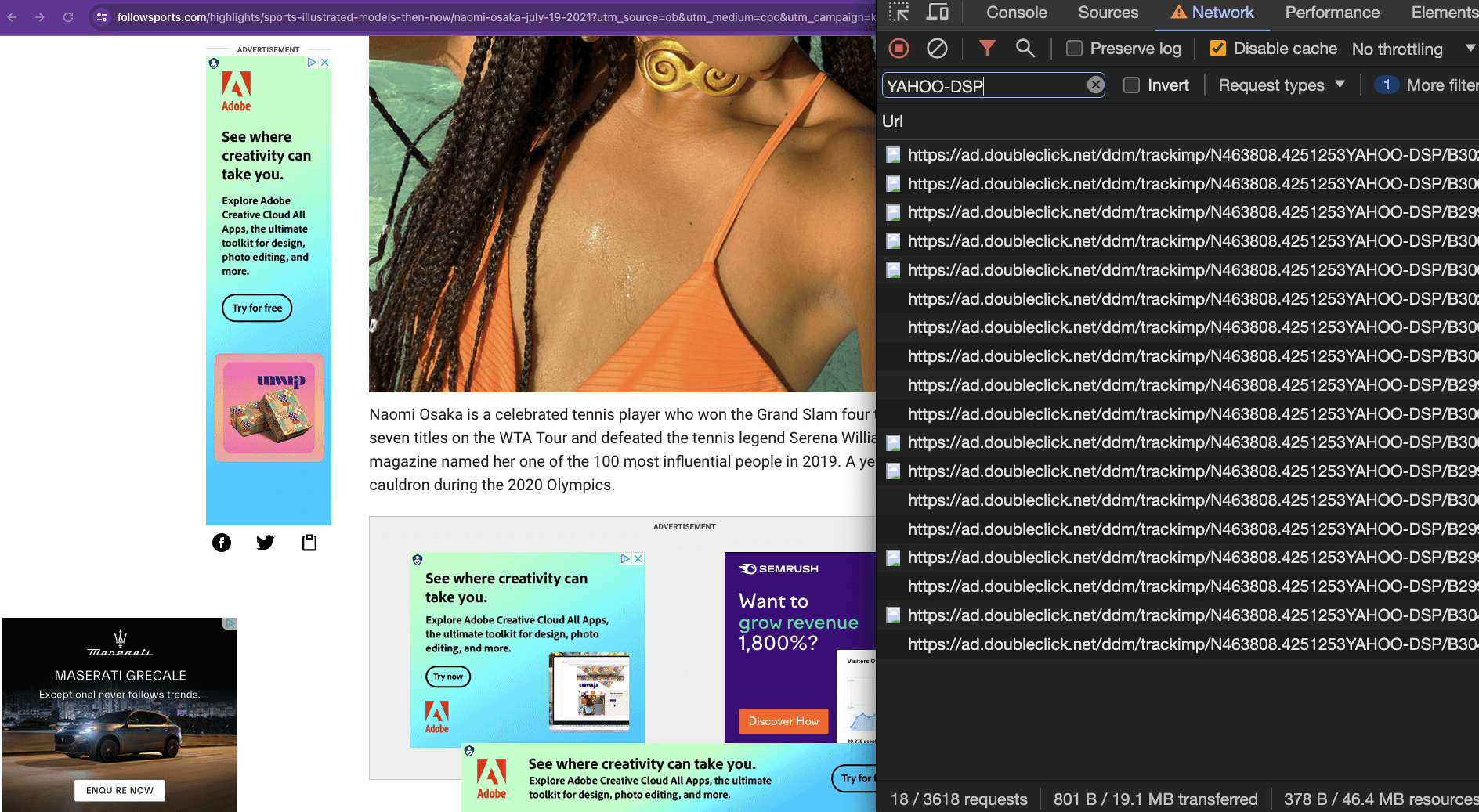
Screenshot of a website which meets various definitions of “Made for Advertising”. Chrome developer tools is open on the right side, showing 18 distinct HTTPS requests to Campaign Manager 360 (360), which contain the string “YAHOO-DSP”.

Screenshot showing two FTC ads served simultaneously on a website on a website which meets the ANA’s, WFA’s, ISBA’s, 4A’s, Jounce Media’s, and DeepSee.io’s definition of “Made for Advertising” website. The ads were transacted via Zeta Global DSP.
For example, Google DV360 or Google Ads was observed transacting ads for 7,272 different brands on the sample of MFA websites in 2024, including ads for brands such as:
H&R Block
Vrbo
NBCUniversal
Comcast
Mint Mobile
Sephora
IHG
Google
Lowe’s
Kenvue
JPMorgan Chase
American Express
Nestle
Disney
Amazon DSP was observed transacting ads for 2,601 different brands on the sample of MFA websites in 2024, including ads for brands such as:
Hershey’s
Disney
Amazon
Clorox
Conagra Brands
Nestle
Energizer
Haleon
PepsiCo
Discovery
Mars
Coca Cola
Warner Bros Discovery
Colgate Palmolive
Meta
Google
Sanofi
Kenvue
StackAdapt DSP was observed transacting ads for the Canadian Armed Forces and other brands on the sample of MFA websites in 2024.
Comcast owned Beeswax DSP was observed transacting ads for 1,352 different brands on the sample of MFA websites in 2024, including ads for brands such:
Indeed (careers network)
Draft Kings
Kaiser Permanente
Navy Mutual
Grainger Industrial Supply
FanDuel
Bet MGM
Centennial Bank
Many different hospital, medical device, and pharmaceutical brands were observed transacting ads on the sample of MFA websites using two “specialist DSPs” that describe themselves as being “purposefully for the healthcare industry” or a “healthcare marketing technology”. These were PulsePoint and DeepIntent Healthcare Advertising DSP. DeepIntent won “Best Demand-Side Technology” in the 2023 AdExchanger Awards for helping to “improve audience quality.”
Brands whose ads were observed to transact via Pulsepoint, a healthcare marketing focused ad platform, on the sample of “made for advertising” websites, included:
Aadi Bioscience
AbCellera
AbbVie
Abbvie
Acacia Pharma Group Plc
Acetaminophen Awareness Coalition
Acorda Therapeutics
Alcon
Alexion
Alkermes Pharma
Almatica
Amgen
Arcutis Biotherapeutics
Argenx
Ascendis
Ascendis Pharma
Astellas Pharma US
AstraZeneca
Atrius Health
Averitas
Axogen
Azurity Pharmaceuticals
BD Biosciences
Bausch + Lomb
Bayer
Bayer Pharmaceuticals
Becton, Dickinson and Company
BioCryst
Biogen
Biomarin
Bioventus
Blueprint Medicines
Bristol Myers Squibb
Brookwood Baptist Health
CHG Healthcare
CSL Behring
CTI Biopharma
Calliditas
Catalyst Pharmaceuticals
Children's Hospital Association
Cincinnati Children's Hopsital Medical Center
Click Therapeutics
Daiichi Sankyo
Dermavent
Edwards Lifesciences
Edwards Lifesciences Corporation
Eisai Inc
Esperion
Exact Sciences
Exelixis
Exeltis
Ferring Pharmaceuticals
Fresenius Medical Care
G1 Therapeutics
GSK
Genentech USA (part of Roche)
Genentech USA Inc
HB Harmony Biosciences
Harmony Biosciences
Harvard Medical School Teaching Hospital
Immunogen Inc
Indivior
Insmed
Inta-Cellular Therapies
Ionis
Janssen (part of Johnson & Johnson)
Jazz
Karyopharm
Kowa
Kyowa Kirin
Leo
Lexicon
Lilly
Mallinckrodt
Mallinckrodt Pharmaceuticals
Mass General Brigham
MedStar
Meranini
Merck
Merus
Moffitt Cancer Center
Mölnlycke Health Care AB
NS Pharma
Neurocrine Biosciences
Novartis
Novo Nordisk
Novocure
On24
Orphalan
Ortho Dermatologics
Otsuka America Pharmaceutical, Inc
Paratek
Passage Bio
Pfizer
Pharmacosmos Therapeutics
Radius Health
Reata Pharmaceuticals
Regeneron
Salix Pharmaceuticals
Sandoz
Sanofi
Seres Therapeutics
Servier
Sprycel
Stemline
Storysoft
Sumitomo Pharma
Sun Ophthalmics
Sun Pharmaceutical Industries
TG Therapeutics
TH Medical
Takeda
Tarsus
Temple University Health System
Tersera Therapeutics
Teva
Think Surgical
Thinking Huts
UCB
University of Kansas Health System
University of Pennsylvania
University of Texas MD Anderson Cancer Center
Vericel Corporation
Vertex
Viatris
W. L. Gore & Associates, Inc
WebMD
X4
scPharmaceuticals
Healthcare and pharmaceutical brands whose ads were observed to transact via DeepIntent on the sample of “made for advertising” websites in January 2024, included:
Johnson & Johnson (Janssen)
lynparzahcp.com - AstraZeneca - source code of the ad contains references to “interpublic.com”, suggesting the ad was also transacted on MFA by IPG media agency
merckvaccines.com - Merck - source code of the ad contains references to “interpublic.com”, suggesting the ad was also transacted on MFA by IPG media agency
ALkermes
AXS
Abbott
Abbott
Abbvie
Agios Pharmaceuticals
Alexion Pharmaceuticals
Alkermes
Amazon
Amgen
AstraZeneca
Ballad Health
Biogen
Boehringer Ingelheim
Boston Scientific
Bristol Myers Squibb
CSL Behring
Centers for Disease Control and Prevention
Chiesi
Children's Health
Deciphera Pharmaceuticals
Endo
Error
Esperion Pharmaceuticals
Exeltis
Gilead
Halozyme
Huntsman Mental Health Institute
Indivior
Inizio
Intercept
Kenvue
Kyowa Kirin
Laboratory Corporation of America Holdings
Madrigal Pharmaceuticals
Merck
Mirum Pharmaceuticals
My Health Team Inc
New York Presbyterian Hospital
Novartis
Otsuka Holdings Co
Otter Pharmaceuticals
Pfizer
Sanofi
Seagen
Smith Nephew
Spectrum Pharmaceuticals
Sun Dermatology
Sun Pharma
Sun Pharmaceutical Industries
Syndax Pharmaceuticals
Taiho Oncology
Takeda Pharmaceuticals America, Inc.
UPMC Health Plan Inc
Viatris
Zarbees
myNEURELIS

Barplot showing how many different brands were observed transacting via a given ad buying platform on a sample of websites which meet various definitions of “Made for Advertising”.
In the histogram below, one can observe the relative abundance or frequency of ads transacted via various SSP or ad delivery platforms on the sample of websites which meet various definitions of “Made for Advertising” in January 2024.
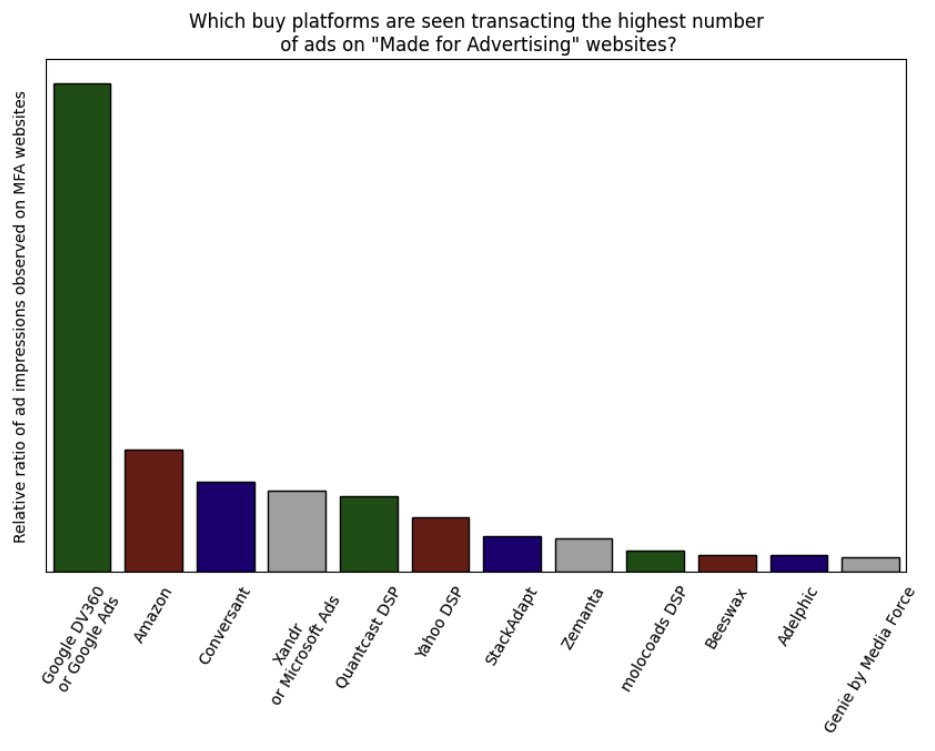
In the histogram below, one can observe the relative abundance or frequency of ads transacted via twelve DSPs, bidders, or managed buying platforms in the sample of websites which meet various definitions of “Made for Advertising” in January 2024. These were the twelve most prevalent or commonly observed DSPs transacting on MFA in the sampleset. Otherwise DSPs were observed transacting less frequently, whilst certain DSPs - such as the Trade Desk and Walmart DSP - were not observed transacting ads on MFA at all.
Some DSPs which have publicly stated they partner with Jounce Media to block “Made for Advertising” ad inventory were observed apparently transacting ads on sites which meet the Jounce Media, DeepSee.io, and others’ definition of “Made for Advertising”. For example, Horizon Therapeutics, Amgen (tepezza.com), and Hallmark Channel ads were observed transacting on the sample of websites described in the Methodology section via AdTheorent. Centro Basis was observed transacting a very small number of impressions on the sample of websites which meet the aforementioned definitions for “Made for Advertising”.
One must note that vendors might provide media buyers the option of disabling MFA filters or guardrails, while successfully filtering out MFA inventory for other buyers by default. For example, AdTheorent specifically states on their website that their partnership with Jounce Media is designed to “ensure that AdTheorent’s campaigns remain MFA-free, unless affirmatively elected by an advertiser.”
One might notice the absence of any impressions on the sample of “Made for Advertising” websites from the DSP The Trade Desk (TTD) or Walmart DSP (which runs on top of TTD). Adexchanger previously noted that: “TTD has quietly blocked the vast majority of MFAs since long before it became a hot-button issue. Although some people consider MFA revenue to be an easy, short-term cash grab for demand- and supply-side platforms, TTD’s ability to win and retain accounts was probably helped by the fact that it discreetly avoids that inventory. Meanwhile, practically every other DSP would partake, even if agencies were unaware of the issue at the time.” The Trade Desk’s “Inventory Policies” state that TTD will not bid on sites using many of the MFA practices. For example, TTD policies state: “Ad refresh must be limited to intervals of 30 seconds or more and must occur only while in-view. Excessive or non-viewable refreshed ads will result in the site or seller being blocked.” Furthermore, TTD also states: “Inventory that appears to result from synthetic or purchased traffic (for example, incentivized, rewarded web views, or clickbait style advertising) is subject to restriction.”
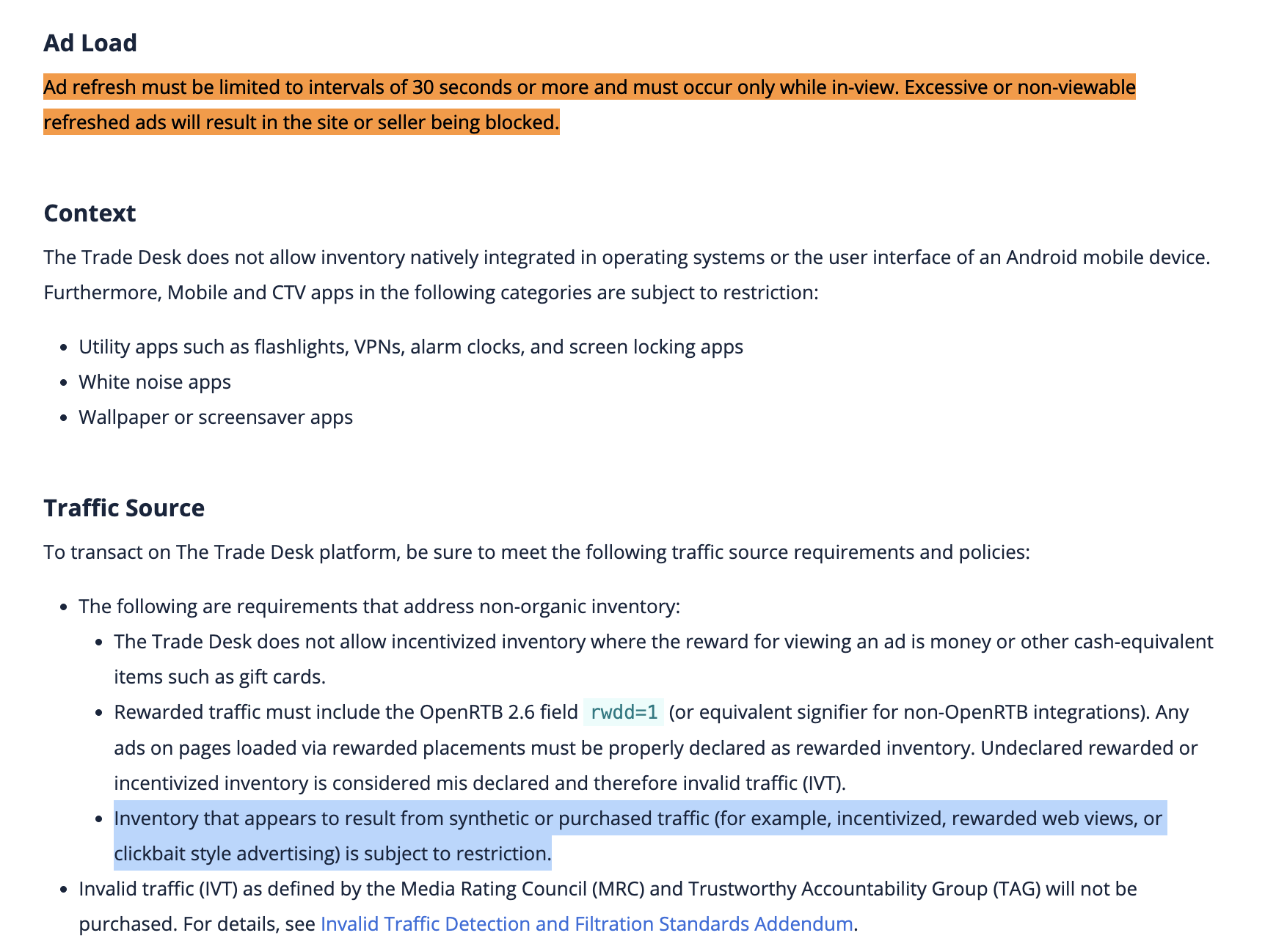
Screenshot of The Trade Desk DSP’s “Inventory Policies”
Brand Safety Vendors and Bot Detection Vendors Observed Collecting Data on MFA sites in 2024
In addition to evaluating which specific SSPs and DSPs were involved in transacting a given brands’ ads on the sample of websites which meet various definitions of “Made for Advertising” in January 2024, each ad impression was also examined to infer what verification vendors were involved in monitoring a given ad impressions.
Several of these vendors issued announcements in 2023 about releasing products to monitor or avoid Made for Advertising websites. In September 2023, DoubleVerify announced a “solution to enable advertisers to monitor and avoid MFA”. In October 2023, IAS “announced a new Made for Advertising (MFA) AI-driven site detection and avoidance product.” “IAS’s new product leverages AI to uncover MFA sites at scale” and “provide [advertisers] with the ability to both detect and avoid MFA sites”. In November, 2023, Pixalate “announced the launch of “Made for Advertising” (MFA) technology to detect and block MFA websites, CTV and mobile apps.”
The list of verification and monitoring platforms who were observed monitoring ads on the aforementioned list of “Made for Advertising” websites in January 2024 includes:
Oracle Moat
Integral Ad Science (IAS)
DoubleVerify
HUMAN (fka White Ops)
Pixalate
FouAnalytics
For example, in the screenshot below, one can observe multiple Comcast Xfinity ads served on a website which meets various definitions of “Made for Advertising”. The source code of the ad contains multiple references to doubleverify.com.

Screenshot showing three Comcast Xfinity ads observed on a website which meets various definitions of “Made for Advertising” website. The source code of each Comcast ad includes multiple references to Double Verify.
In the screenshot below, one can observe Disney ads served on another website which meet various definitions of “Made for Advertising”. The source code of the Disney ad references “adsafeprotected.com”, a tag and pixel serving domain

Screenshot of a Disney ad observed on a website which meets the ANA’s, WFA’s, ISBA’s, 4A’s, Jounce Media’s, and DeepSee.io’s definition of “Made for Advertising” website. The source code of the includes references to IAS’s measurement tag serving domain ‘adsafeprotected.com’.
Furthermore, one can observe that on some “Made for Advertising” websites, vendors like Moat, IAS or DoubleVerify received hundreds of points of telemetry and data. For example, in the screenshot below one can see that IAS’s adsafeprotected.com domain was invoked 437 times transacting or measuring various brands’ ads.

Screenshot of Chrome developer tools’ Network tab open on a website not affiliated with Sports Illustrated which meets the ANA’s, WFA’s, ISBA’s, 4A’s, Jounce Media’s, and DeepSee.io’s definition of “Made for Advertising” website. The network tab shows 437x HTTPS requests were sent to IAS’s “adsafeprotected.com” domain.
In the barplot below, one can observe the number of different brands and advertisers’ whose ads were observed on “Made for Advertising” websites and contained measurement code from a given vendor. For example, 6835 different advertisers (as defined by unique ‘adomains’) whose ads were served on MFA websites appeared to include measurement code from Oracle Moat within their ad creatives. One must note that some brands, such as Johnson & Johnson, have many different products and thus “adomains”. For example, Johnson & Johnson was observed placing ads for which the “adomains” included jannssen.com as well as several specific pharmaceuticals, including imbruvica.com, stelarainfo.com, tremfya.com, and others. Each of these unique adomains, if observed having their ads measured by a given vendor, would be counted as a distinct advertiser.
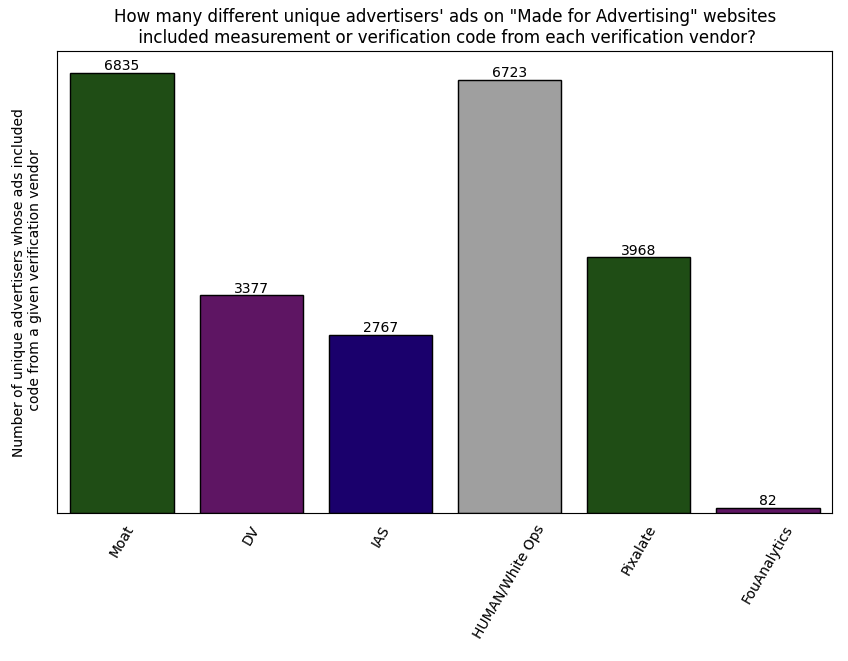
Barplot illustrating how many different advertisers appeared to have code from a given measurement or verification vendor in the source code of their ad creative when the ad served on a “Made for Advertising” website.
One must also note that some verification or monitoring code is not configured by an advertiser or their agency, but rather, by their SSPs or DSPs automatically. For example, HUMAN (fka White Ops) has partnerships with many leading SSPs and DSPs which will stochastically inject HUMAN’s JavaScript code into the source code of various brands’ ads being served on consumer’s device. As such, even though HUMAN likely does not have contracts directly with many advertisers, their visibility into the placement and delivery of various brands’ ads on “Made for Advertising” sites is widespread due to their integration with various ad tech vendors. For example, Pubmatic states that it partners with IAS and White Ops (now known as HUMAN).
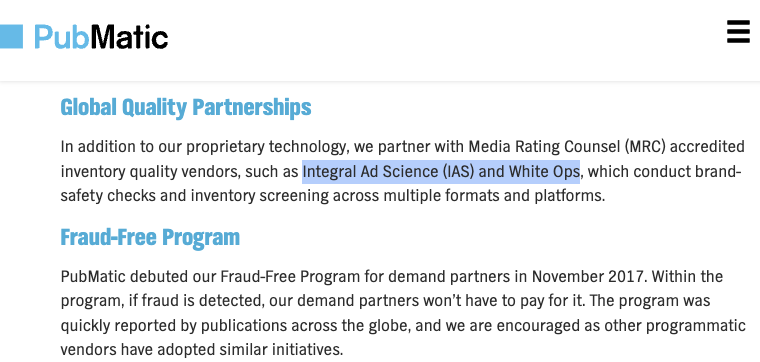
Pubmatic partners with IAS and HUMAN (fka White Ops)
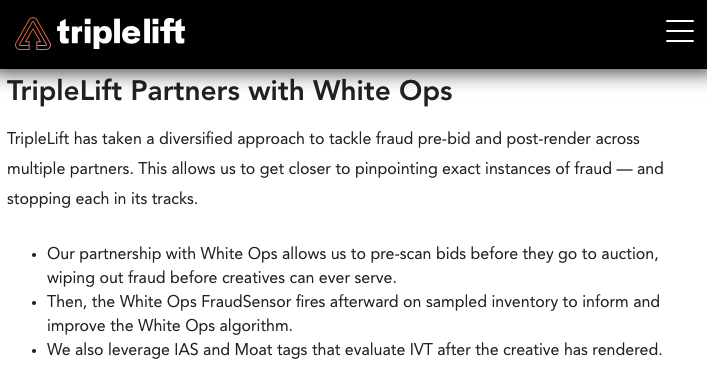
TripleLift partners with HUMAN (fka White Ops), IAS, and Moat
Many ads transacted via OpenX appeared to include various monitoring or measurement code from Pixalate, which may be suggestive of a partnership between OpenX and Pixalate. OpenX’s website lists Pixalate as a “service provider”.
Brands whose ads were observed serving on “Made for Advertising” websites and contained Pixelate tags included: Adobe, H&R Block, Comcast, Sanofi, NBCUniversal, Navy Federal, Vrbo, Jet Blue, Planet Fitness, Kroger, Lowe’s, Microsoft, Disney, Verizon, Comcast, Dell, Sephora, Bet MGM, Southwest Airlines, Blue Apron, Anthem, BMO Bank, and others.
In the case of FouAnalytics, it appears that many pharmaceutical brands, when transacting via PulsePoint Healthcare Marketing platform on “Made For Advertising” websites, have FouAnalytics code inserted into their ad creatives. This raises the possibility that FouAnalytics may have some form of monitoring partnership with PulsePoint. Brands whose ads appeared on “Made for Advertising” websites and included FouAnalytics code in the source code of their creatives include: Bayer, Amgen, TG Therapeutics, Novartis, Harmony Biosciences, Johnson & Johnson, Edward Lifescience Corporation, Mallinckrodt Pharmaceuticals, Bioventus LLC, Genentech (Roche), Novo Nordisk, Radius Health, Argenx, Otsuka Pharmaceuticals, and Cardinal Health.
Brands whose ads appeared on “Made for Advertising” websites and appeared to have measurement from IAS included: Nestle, Disney, Jet Blue, Microsoft, CDC (US Centers for Disease Control), Johnson & Johnson, United Airlines, Nintendo, Anthem, Vrbo, Planet Fitness, Verizon, US Coast Guard, Progressive, Kenvue, Haleon, McDonald’s, All State, Toyota, and others.
Brands whose ads appeared on “Made for Advertising” websites and appeared to have measurement from DoubleVerify included: Comcast, Pandora, Lowe’s, Dell, Pfizer, Norwegian Cruise Lines, H&R Block, Petco, Charles Schwab, US Army, National Society for the Prevention of Cruelty to Children (nspcc.org.uk), Sanofi, Marriott, Major League Baseball, Abbvie, Bristol Myers Squibb, General Mills, UK National Trust, Reckitt Benckiser (k-y.com), Navy Federal, and others.
In the histogram below, one can view the relative number of ad impressions whose source code included code from various verification vendors. Moat code was observed in ad creatives on “Made for Advertising” websites most frequently.
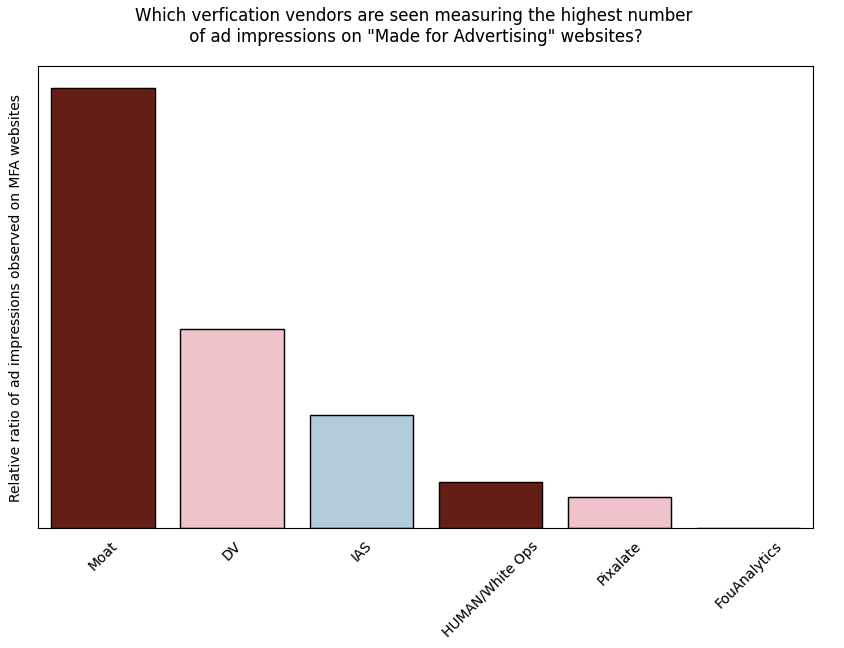
Histogram showing the relative volume of impressions observed on a sample of Made for Advertising websites in 2024, wherein the given ad contained code from a given verification vendor.
It is unclear how many - if any - of the brands whose ads contained IAS, DV, and Pixalate source code, were leveraging these vendors’ solutions for monitoring and avoiding “Made for Advertising” websites.
Private marketplace (PMP) deals serving ads on “Made for Advertising” websites
The ANA Programmatic Media Supply Chain Transparency Study defines Private Marketplace (PMP) as “Inventory that a seller (SSP, ad network, or publisher) makes available programmatically on an exchange to select advertisers or buyers. As compared to the Open Marketplace (OMP), with PMPs advertisers have a greater control over what audiences, publishers, and placements their spend goes to and where their ads appear at a pre-agreed price. In some cases, there is also preferential access to ad inventory.”
The report further states that “Private Marketplace deals have long been perceived as “premium” or “privileged” offerings, promising higher-quality inventory and better viewability. This quality assurance is often the driving factor behind PMPs commanding a higher price compared to OMP inventory.”
However, the ANA study found that “not all categories of PMPs with matched DSP and ad verification live up to the promise of being "premium" or "privileged." The presence of MFA sites, known for their low-quality content and poor user experience, particularly in the category of PMPs over 500 domains, substantially dilutes the supposed premium nature of some PMPs. That MFA activity reached over 30 percent in Private Marketplace deals for some
study participants.”
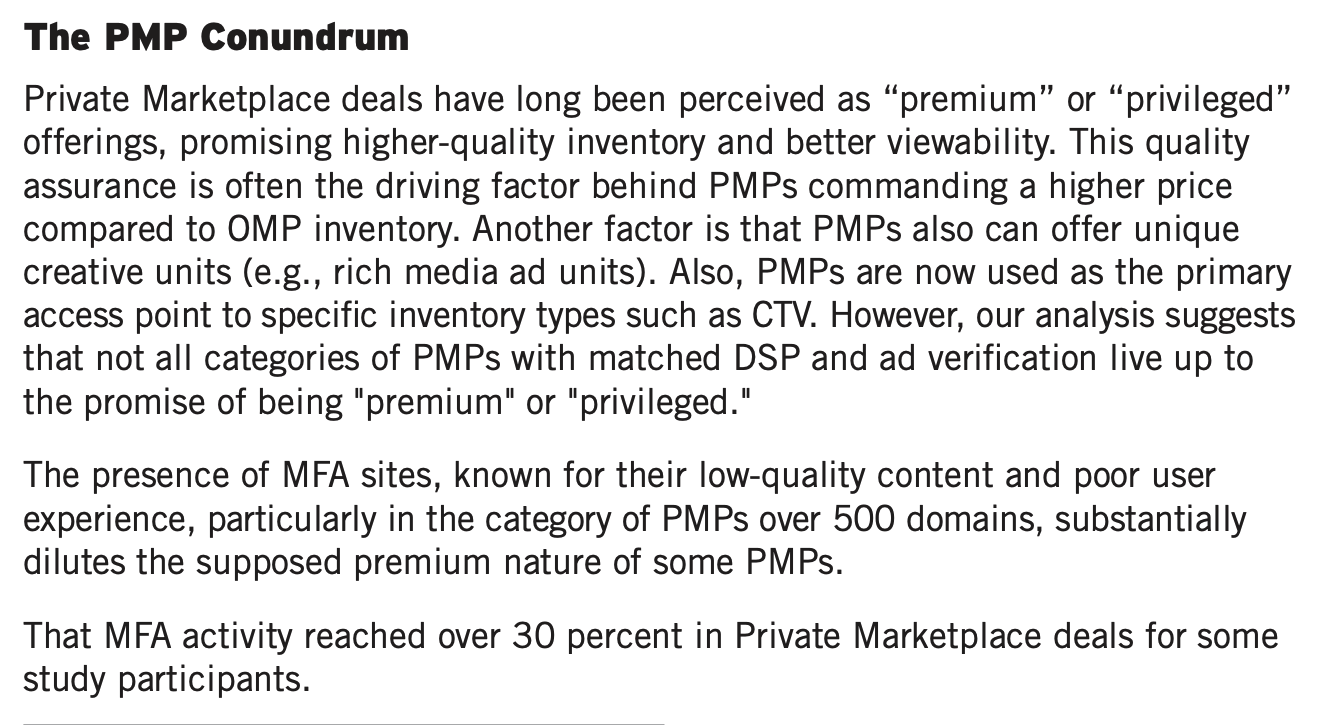
Screenshot from the ANA Programmatic Media Supply Chain Transparency Study: Complete Report
The ANA report found that on average, 14% of PMP deal spend in its sample was allocated to MFA inventory.
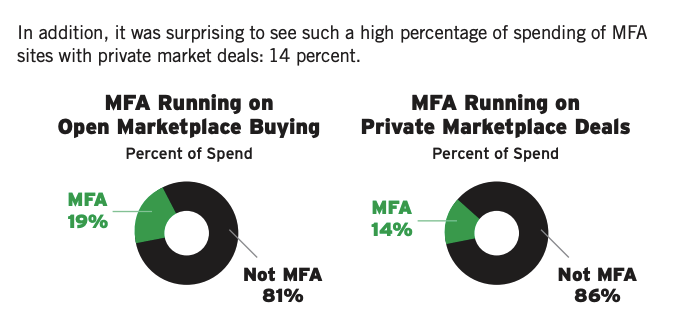
Screenshot from the ANA Programmatic Media Supply Chain Transparency Study: Complete Report
Given the ANA’s findings, a portion of this observational study was focused on determining if any ad tech vendors could be seen placing ANA brand members ads on the sample of “Made for Advertising” websites in January 2024.
For a subset of ad impressions observed it was possible to extract various identifiers from the source code or meta-data of the ad impressions that were indicative of various “deal IDs”. For example, some ads observed transacted via Prebid and contained not empty values in the “deal ID” attribute of submitted bid responses. In other cases, ads were transacted via various vendors which appear to encode a “deal ID” attribute directly in the source code of an individual ad creative. The source code of many ads which transact via ShareThrough SSP on “Made for Advertising” sites appear to contain references to specific deal ID codes.
Yieldmo observed potentially transacting PMP deals on “Made for Advertising” websites
Yieldmo’s website states that: “Yieldmo’s PMPs offer buyers significant advantages over open exchange inventory in that they exclude MFA sites (as defined by Jounce Media), and are often curated to more attentive ad placements. This delivers better advertiser outcomes and protects our customers from wasting money on MFA sites and other low-quality traffic.”
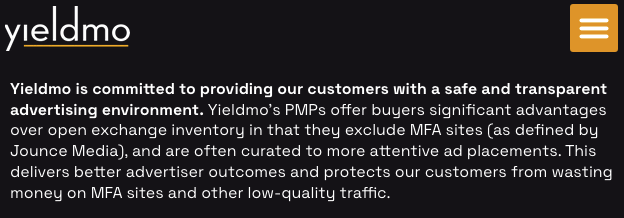
Screenshot from Yieldmo’s website, saying that it excludes MFA sites as defined by Jounce Media from its PMPs.
Elevance Health (formerly known as Anthem, Inc.) is an American health insurance provider based in Indiana, and number 22 on the Fortune 500. Elevance Health ads were observed transacting on the sample of “Made for Advertising” websites in January 2024 via DV360 DSP and Yieldmo. The ads contained monitoring code from IAS.
The source code of the Elevance ads included references to “yieldmo_nyiax_elevance_standarddisplay_ron_dv360”. “ron” likely refers to “Run of Network”, and “nyiax” is likely a reference to NYIAX, which is an “Advanced Contract Management" platform for digital advertising. NYIAX’s website states that its platform allows for “unmatched security, transparency, and efficiency across all transactions, regardless of the complexity or scale. Every aspect of the NYIAX platform, from our vast discovery network to our automated compliance assurance, has been developed with transparency in mind.”

Screenshot of an anthem.com (Elevance Health) ad - transacted via DV360, Yieldmo and IAS - observed on a “Made For Advertising” website in January 2024. The source code of the ad references “ias_dealId” and is set to “yieldmo_nyiax_elevance_standarddisplay_ron_dv360”.
Pubmatic observed potentially transacting PMP deals “Made for Advertising” websites
PubMatic senior director of marketplace quality Eric Bozinny told Adweek in June 2023 that it “will announce it’s eliminating MFA inventory from the auction packages it sells.” Pubmatic issued a blog post in June 2023 regarding “Made for Advertising”, but it is now no longer accessible. The no longer accessible blog post said: “PubMatic is [...] turning responsible media insights into action by eliminating made for advertising (MFA) websites from PubMatic-sold Auction Packages.” The deleted post further said: “our work to provide powerful, quality advertising experiences for buyers has been recognized by Jounce Media, which ranks PubMatic as the omnichannel supply-side technology company with the lowest exposure to MFA inventory among our peer group. According to Jounce Media’s Chris Kane, “Bidding into the PubMatic open auction creates less exposure to MFA inventory than bidding into the open auction from any other major exchange.”

Screenshot of Pubmatic’s blog post titled: “Advancing Responsible Media By Removing MFA Inventory From Auction Packages.” (URL: https://pubmatic.com/blog/advancing-responsible-media-by-removing-mfa-inventory-from-auction-packages/) showing that the page is “not found”. An archived copy of the page can be found on the Internet Archive from June 2023.
Comcast ads were observed transacting on the sample of “Made for Advertising” websites in January 2024 via DV360 DSP and Pubmatic SSP. The Comcast ads contained monitoring code from Doubleverify.
The source code of the Comcast ads included references to “deal=PM-RPNH-3759”.
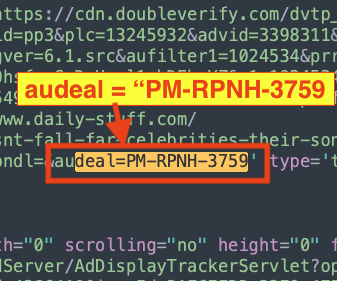
Screenshot of a comcast.com (Comcast) ad - transacted via DV360, Pubmatic and DoubleVerify - observed on a “Made For Advertising” website in January 2024. The source code of the ad references “audeal” and is set to “PM-RPNH-3759”.
Multiple other brands had ads transacted via TripleLift on the sample of websites which meet various definitions of “Made for Advertising” in January 2024 and included deal ID code references starting in “PM-”. These included: Comcast, NatWest, Jared (jewelry), Enterprise (car rental), Haleon, Elevance Health (fka Anthem), Kay Jewelers, AT&T, and others.
| Deal ID observed transacting via Pubmatic on MFA | Advertiser |
| PM-RPNH-3759 | comcast.com |
| PM-JBEG-4751 | natwest.com |
| PM-RTNM-8747 | jared.com |
| PM-WFRM-8363 | comcast.com |
| PM-JZNH-9598 | nationalcar.com |
| PM-AXXY-5885 | haleon.com |
| PM-JBEG-4751 | natwest.com |
| PM-OUTL-6398 | anthem.com |
| PM-RPNH-3759 | comcast.com |
| PM-RTNM-8747 | kayoutlet.com |
| PM-RTNM-8747 | kay.com |
| PM-YICU-7009 | att.com |
TripleLift observed potentially transacting PMP deals serving ads on “Made for Advertising” websites
TripleLift’s website states that the firm “work[s] with Jounce Media to help validate supply chain directness and inventory quality.” Triplelift further states: “we are committed to: Blocking Made for Advertising (MFA) inventory from all private marketplace and publisher first-party data deals; Refusing to onboard any MFA inventory, as part of our supply standards.”
The United States Army was observed transacting on the sample of “Made for Advertising” websites in January 2024 via DV360 DSP and Triplelift SSP. The Triplelift ads contained monitoring code from Doubleverify.

Screenshot of a goarmy.com (US Army) ad - transacted via DV360, TripleLift and DoubleVerify - observed on a “Made For Advertising” website in January 2024. The source code of the ad references “audeal” and is set to “tlx-58966”.
Multiple other brands had ads transacted via TripleLift on the sample of websites which meet various definitions of “Made for Advertising” in January 2024 and included deal ID code references starting in “tlx-”. These included: Comcast, TD Canada, British United Provident Association (BUPA, a health insurance company), Royal Bank of Canada (RBC), and others.
| Deal ID observed transacting via Triplelift on MFA | Advertiser |
| tlx-41221 | comcast.com |
| tlx-58966 | goarmy.com |
| tlx-60280 | comcast.com |
| tlx-37842 | comcast.com |
| tlx-32947 | comcast.com |
| tlx-42177 | comcast.com |
| tlx-18218 | tdcanadatrust.com |
| tlx-47927 | bupa.co.uk |
| tlx-39083 | rbc.com |
| tlx-41277 | comcast.com |
| tlx-36434 | comcast.com |
OpenX observed potentially transacting PMP deals serving ads on “Made for Advertising” websites
OpenX states that it “has partnered with Jounce Media” and has “started to block known MFA traffic on Auction Packages running through OpenX.”
It further states: “OpenX leverages the Jounce Media MFA domain list as the standard baseline, and in its continued commitment to inventory quality and transparency, the SSP has committed to eliminating MFA domains in all direct-sold deals by default.”
Elevance Health (formerly known as Anthem, Inc.) has ads observed on a sample of “Made for Advertising” websites in January 2024 via DV360 DSP and OpenX. The ads contained monitoring code from IAS.
The source code of the Elevance ads’s included references to “ias_dealId=OX-bef-JUoJBy”.

Screenshot of a anthem.com (Elevance Health) ad - transacted via DV360, OpenX and IAS - observed on a “Made For Advertising” website in January 2024. The source code of the ad references “ias_dealId” and is set to “OX-bef-JUoJBy”.
Multiple other brands had ads transacted via OpenX on the sample of websites which meet various definitions of “Made for Advertising” in January 2024 and included deal ID code references starting in “OX-”. These included: Comcast, Century Link, NBCUniversal, Verizon, Jet Blue, Navy Federal, Wyndham Hotels, Blue Apron, Brooks (running shoes), Vrbo, US Army, Natwest, Norwegian Cruise Lines, Moffitt Cancer Center, Adobe, US Bank, Kroger, BMO Bank, Sobeys, and others.
| Deal ID observed transacting via OpenX on MFA | Advertiser |
| OX-TEO-8e3gKN | comcast.com |
| OX-XPT-dsM0UA | centurylink.com |
| OX-XPT-pdBKvv | peacocktv.com |
| OX-33a-oqQfJO | comcast.com |
| OX-bef-JUoJBy | anthem.com |
| OX-XPT-SiE14g | verizon.com |
| OX-bef-aE6VxD | jetblue.com |
| OX-bef-DJ4Xbe | navyfederal.org |
| OX-bef-UrQuyE | wyndhamhotels.com |
| OX-bef-Maxjkn | wyndhamhotels.com |
| OX-XPT-KXfB2M | blueapron.com |
| OX-XPT-GKrGqU | comcast.com |
| OX-XPT-NJjZmi | brooksrunning.com |
| OX-XPT-4M48mI | vrbo.com |
| OX-XPT-NReF7h | goarmy.com |
| OX-XPT-C3Cv3s | natwest.com |
| OX-bef-XaHpV9 | ncl.com |
| OX-XPT-mStZdj | comcast.com |
| OX-bef-n2Lkik | moffitt.org |
| OX-XPT-KILVwV | adobe.com |
| OX-bef-irlKyY | wyndhamhotels.com |
| OX-XPT-yeK6N6 | adobe.com |
| OX-XPT-BKYMOr | vrbo.com |
| OX-XPT-3jsgTc | usbank.com |
| OX-XPT-ltC0Qp | adobe.com |
| OX-bef-Ei0w5e | adobe.com |
| OX-XPT-eavqY4 | adobe.com |
| OX-bef-rlJD6Y | adobe.com |
| OX-XPT-XNr2Be | adobe.com |
| OX-XPA-6hLqnD | kroger.com |
| OX-XPT-wCfpC6 | bmo.com |
| OX-XPT-3okBI8 | voila.ca |
| OX-XPA-0jvboz | kroger.com |
ShareThrough observed potentially transacting PMP deals on “Made for Advertising” websites
ShareThrough announced on June 14th, 2023 that “Sharethrough becomes the first ad exchange to remove MFA sites, which are sites created for the purpose of ad arbitrage, from all its off-the-shelf deals and custom PMPs created after July 1, 2023. The company is leveraging Jounce Media data to identify MFA sites and has built filters within its curation platform to remove them.”
 ShareThrough post from June 14th, 2023
ShareThrough post from June 14th, 2023
Microsoft was observed transacting on the sample of “Made for Advertising” websites in January 2024 via Xandr DSP and ShareThrough SSP. The ads were monitored by IAS. The source code of the Microsoft ads included references to “deal_id: m9Wi6”.

Screenshot of a Microsoft ad - transacted via Xandr DSP, ShareThrough, and IAS - observed on a “Made For Advertising” website in January 2024. The source code of the ad references “deal_id” and is set to “m9Wi6”.
Adobe was observed transacting on the sample of “Made for Advertising” websites in January 2024 via Quantcast DSP and ShareThrough SSP. The ads were monitored by HUMAN (fka White Ops). The source code of the Adobe ads included references to “deal_id: CDLFk”.

Screenshot of an Adobe ad - transacted via Quantcast DSP, ShareThrough, and HUMAN (fka White Ops) - observed on a “Made For Advertising” website in January 2024. The source code of the ad references “deal_id” and is set to “CDLFk”.
Multiple other brands had ads transacted via ShareThrough on the sample of websites which meet various definitions of “Made for Advertising” in January 2024 and included “deal_id” code reference in the source code of the ShareThrough media ad creative. These included: Verizon, McDonald’s, Carnival (cruise lines), Vail (ski resorts), Square (fintech), Warner Bros. Discovery, Sonic Drive-In, Dell, Cogeco (Canadian telecoms company), O'Reilly Media, Royal Bank of Canada, Samsung, General Mills, Enterprise (car rental), US Army, TG Therapeutics, Pulte (house builder), BMO Bank, TerSera Therapeutics, Max (fka HBO Max), Planet Fitness, Norton (antivirus), Singapore Airlines, and others.
| Deal ID observed transacting via ShareThrough | Advertiser |
| m9Wi6 | microsoft.com |
| e3sPr | comcast.com |
| Vh4fM | tracfone.com |
| FdtJa | adobe.com |
| 9jt7T | mcdonalds.com |
| L21Bf | carnival.com |
| bDrVy | vail.com |
| hAawY | squareup.com |
| qN8t5 | wbd.com |
| o6R4x | sonicdrivein.com |
| CDLFk | dell.com |
| Vh4fM | visible.com |
| TsdEB | cogeco.ca |
| HfrF5 | thundervalleyresort.com |
| 9BPvf | oreilly.com |
| E2UJq | samsunghvac.com |
| jbvEt | warnerbros.com |
| NoYEq | rbc.com |
| Wv2aE | coastcapitalsavings.com |
| zVTtR | generalmills.com |
| MEif4 | paylocity.com |
| auCKY | enterprise.com |
| t7KKs | goarmy.com |
| iHJ2P | arcticgardens.ca |
| 3yrWK | briumvi.com |
| gnNLy | homedepot.ca |
| qA16z | pulte.com |
| bYtpW | betway.com |
| HfrF5 | hungryhowies.com |
| wQ5is | norton.com |
| HfrF5 | pcmtrials.com |
| EjbCh | planetfitness.com |
| JhT11 | bmo.com |
| PZJdF | max.com |
| Jz7pW | xermelo.com |
| bGkgx | singaporeair.com |
The ANA Programmatic Media Supply Chain Transparency Study emphasizes the “Need for Data-Driven Verification”, noting that: “The study findings underscore the critical need for data-driven verification to ensure marketers receive the value they expect from PMPs. Transparency is the linchpin for this transformation. Marketers can harness the power of log-level data analysis to peer inside each PMP, classify sites into quality tranches (good, okay, and bad quality), and subsequently reprice PMPs to reflect their true value. This data-driven approach reduces risk with PMP investments, ensuring that marketers receive the quality and performance they rightfully expect.”

Screenshot from the ANA Programmatic Media Supply Chain Transparency Study: Complete Report
Retail Media Networks appear to transact ads on “Made for Advertising” websites
During the course of January 2024, many major brands such Procter & Gamble, Sanofi, Reckitt, Mars, Mondelez, Kenvue, Unilever, Haleon, Hershey’s, Google, Meta, Kellanova, Conagra Brands, PepsiCo, Coca-Cola, Henkel, Clorox, Colgate-Palmolive, Abott, L'Oreal, J.M. Smucker, Kraft Heinz, Danone, Campbell Soup, Adidas, Nike, and others were observed to have their ads served on “Made for Advertising” websites via Retail Media Networks (RMNs).
Screenshot showing three Unilever Murad ads served simultaneously via Amazon retail media network and/or Amazon DSP on a “Made for Advertising” website.
According to Insider Intelligence, “A retail media network is an asset owned and operated by a retailer which publishes advertisements, or a third-party publisher that contains ads which leverage a retailer’s first-party shopper data. Retail media networks may include websites, mobile apps, streaming services, email channels, stores, or partner assets like social networks and digital billboards.”
It can include: “Off-site ads leverage retailer data but are served through retail media partnerships.”
Some well known examples of retailers with retail media networks include Amazon, Walmart, Target, Bestbuy, and Instacart. eMarketer estimates in 2022 Amazon will have a “76.9% share of retail digital media ad spend. By comparison, Walmart is the second largest at 6.1%, followed by Instacart at 1.9%.”
Clearcode states that: “Retail media ads can also come in many forms, with the main ones being: Sponsored products [...], Onsite advertising [...], Offsite advertising: A brand’s products or services displayed as ads on a different website (e.g. not the retailer’s) using a retailer’s first-party data.”

Example of retail media advertising. Source: Clearcode
Amazon ads’ “A guide to retail media networks” explains retail media networks thusly: “retailers enable brands to buy advertising across a collection of digital channels (e.g., websites, apps) that include both channels owned by the retailer directly and channels owned by third-party media companies that work with the retailer to offer ad inventory to brands to further market their products beyond a retailer’s owned properties.
If retailers want to further expand a brand’s reach with a wider audience, they may work with media companies to open up ad space inventory for third-party brands or activate their other digital properties as well.”

Source: Amazon ads - A guide to retail media networks
Adweek reported that “U.S. ad spend on off-site retail media network inventory is projected to grow to $11 billion this year, according to Insider Intelligence.” Adweek further reported that:
“Buying Retail Media Off-Site Could Worsen Transparency Issues for Brands”
“Off-site retail media is a growing category, but one that restricts buyer control”
“When retailers buy off-site media on behalf of brands, they may lack the expertise and access of media agencies”
“Another issue is measurement [...] metrics like reach and frequency are not always guaranteed in off-site media buys”
“[brand] clients rely on these retailers buying their inventory in massive quantities [...] don’t have as much leverage because brands can’t go toe-to-toe with retailers that hard.”
Amazon, Walmart, Target, and other retail media networks were not listed as vendor participants in the ANA’s 2023 study, which appeared to be primarily focused on “programmatic” ad buys. The ANA’s public report does not make any mention or references to “retail media networks”.
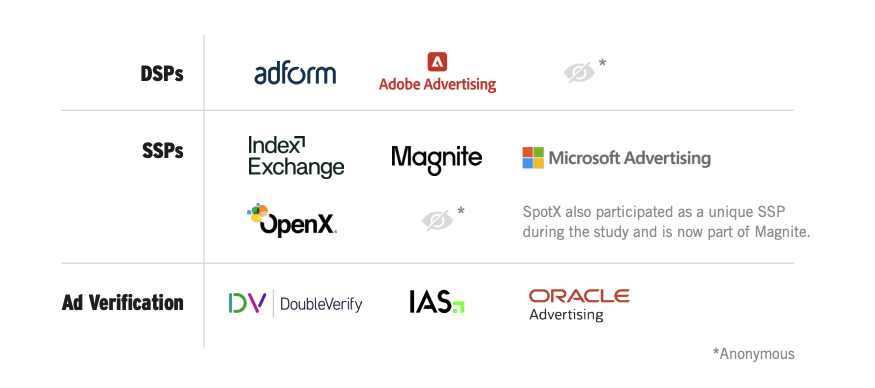
Screenshot from the ANA’s 2023 Programmatic Transparency Study, showing the 3 DSPs, 6 SSPs, and 3 ad verification vendors which participated in the study.
Many ANA member and other brands appeared to have their ads served on “Made for Advertising” websites in January 2024 via off-site retail media networks. Furthermore, these networks sometimes served the same ad to a given consumer dozens or hundreds of times in a single pageview session on an auto-refreshing “Made for Advertising” site.
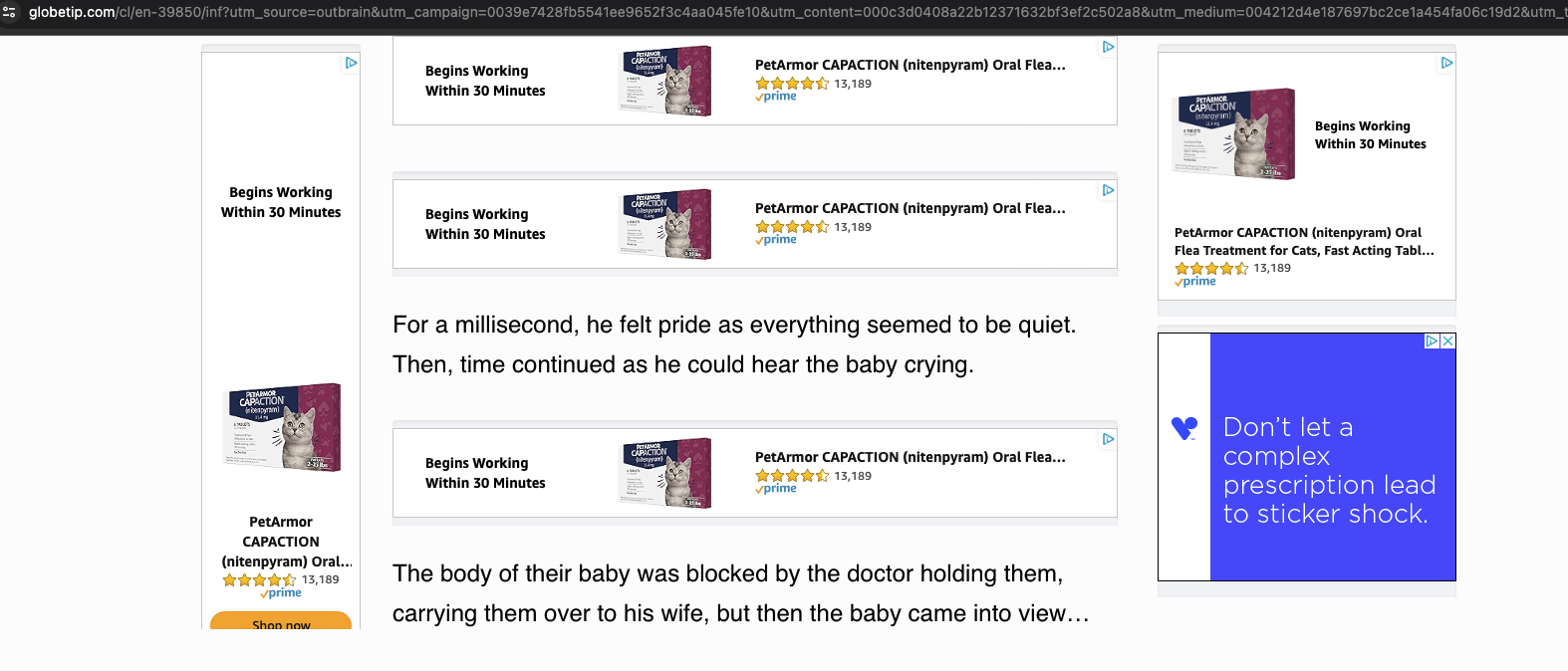
Screenshot of five PetArmor ads served simultaneously on a “Made for Advertising” website via Amazon DSP and/or Amazon retail media network.
In the screenshot below, one can see six different ads served via Amazon DSP/Amazon Retail Media Network on a website which meets various definitions of “Made for Advertising”. Three simultaneous Kenvue Neutrogena ads are served, alongside three other Amazon transacted ad units.
Screenshot showing six ads transacted via Amazon retail media network and/or Amazon DSP observed on a website which meets various definitions of “Made for Advertising”. Three of the ads are for the same brand - Kenvue’s Neutrogena.
As another example, in the screenshot below one can observe three Unilever Knorr ads served simultaneously by Amazon DSP and/or Amazon retail media network on a “Made for Advertising” website.
Screenshot showing three Unilever Knorr ads transacted via Amazon retail media network and/or Amazon DSP observed on a website which meets various definitions of “Made for Advertising”.
Many different Unilever products were observed advertised on “Made for Advertising” sites via Amazon DSP and/or Amazon retail media network. For example, in the screenshots below, one can observe Unilever Degree antiperspirant, Unilever Nexxus hair spray, and Unilever Nutrafol ads observed on “Made for Advertising” websites in January 2024.
Screenshot showing Peet’s Coffee, Unilever Degree Antiperspirant, and Unilever Nexxus Comb ads served simultaneously on a “Made for Advertising” website by Amazon DSP and/or Amazon retail media network. An American Express ad can also be seen stacked underneath some of the Amazon ads.
Screenshot of Clorox and Unilever-owned Nutrafol ads served via Amazon DSP and/or Amazon retail media network on a “Made for Advertising” website not affiliated with Maxim in January 2024.
Other major household goods or personal care brands such as Clorox, S. C. Johnson, Reckitt, Colgate, L’Oreal, and Procter & Gamble were also observed advertising on “Made for Advertising” websites via Amazon DSP and/or Amazon retail media network.

Screenshot of two Clorox ads served via Amazon DSP and/or Amazon retail media network on a “Made for Advertising” website not affiliated with Sports Illustrated.

Screenshot of Clorox ads observed on an “Made for Advertising” website which were transacted via Amazon retail media network and/or Amazon DSP. Also visible are two YouTube TV NFL Sunday ticket ads, a Max (fka HBO Max) ad, and a Nice N’Clean ad that was served via Amazon DSP.

Meta Quest 3 and Windex (S. C. Johnson & Son) ads observed on a “Made For Advertising” website via Amazon’s retail media network and/or Amazon DSP.
Screenshot showing two L’Oreal Paris ads transacted via Amazon retail media network and/or Amazon DSP observed on a “Made for Advertising” website.

Screenshot of Reckitt Resolve ads on a “Made for Advertising” website, transacted via Amazon retail media network and/or Amazon DSP.

Screenshot of a Procter & Gamble Oral-B ad observed on a “Made for Advertising” website via Amazon retail media network and/or Amazon DSP. Also visible are ads for Bristol Myers Squibb’ Opdivo in a muted, auto-playing out-stream video player, Disney+, and Mattress Firm.
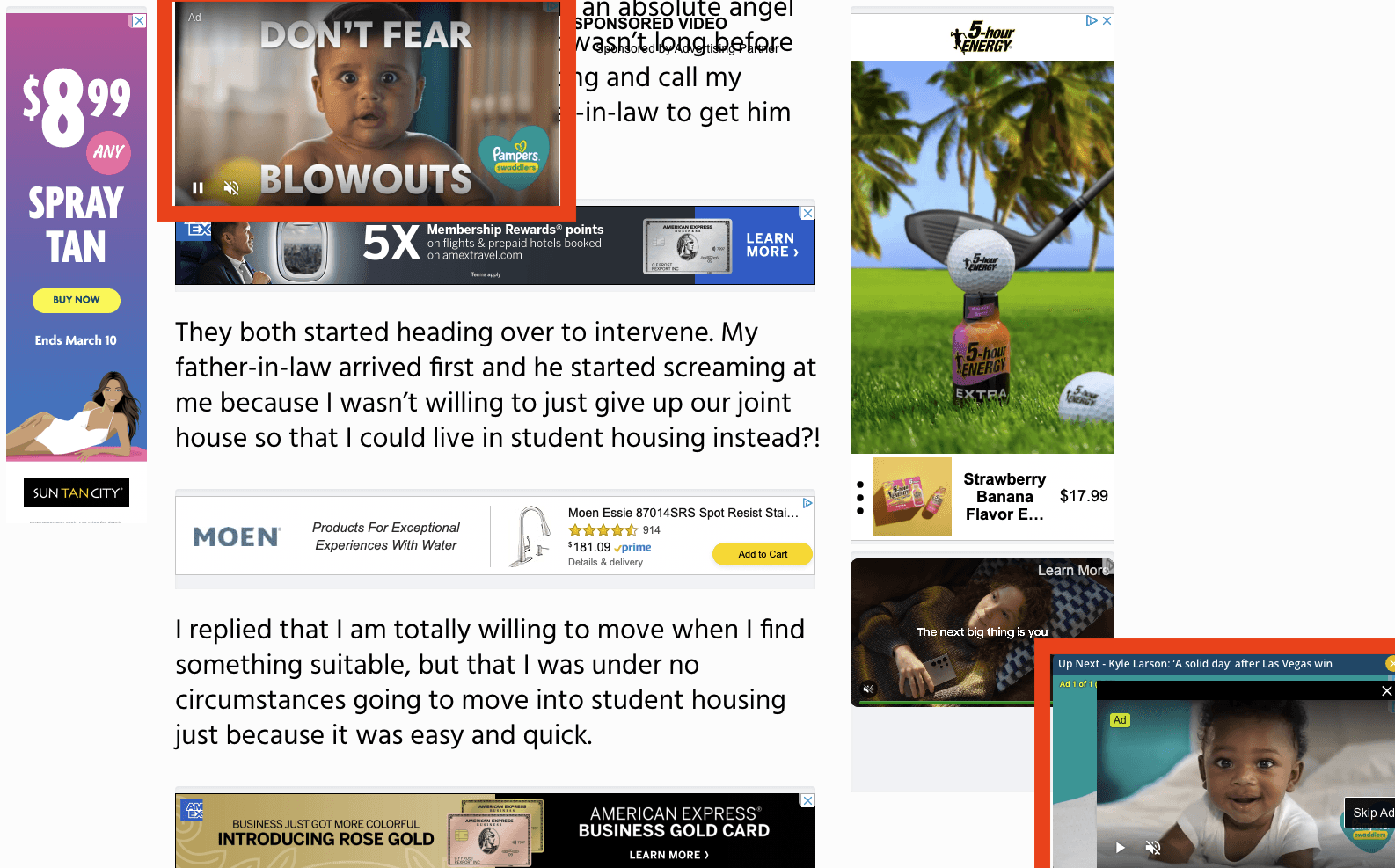
Screenshot of two Procter & Gamble Pampers ad observed on a “Made for Advertising” website.
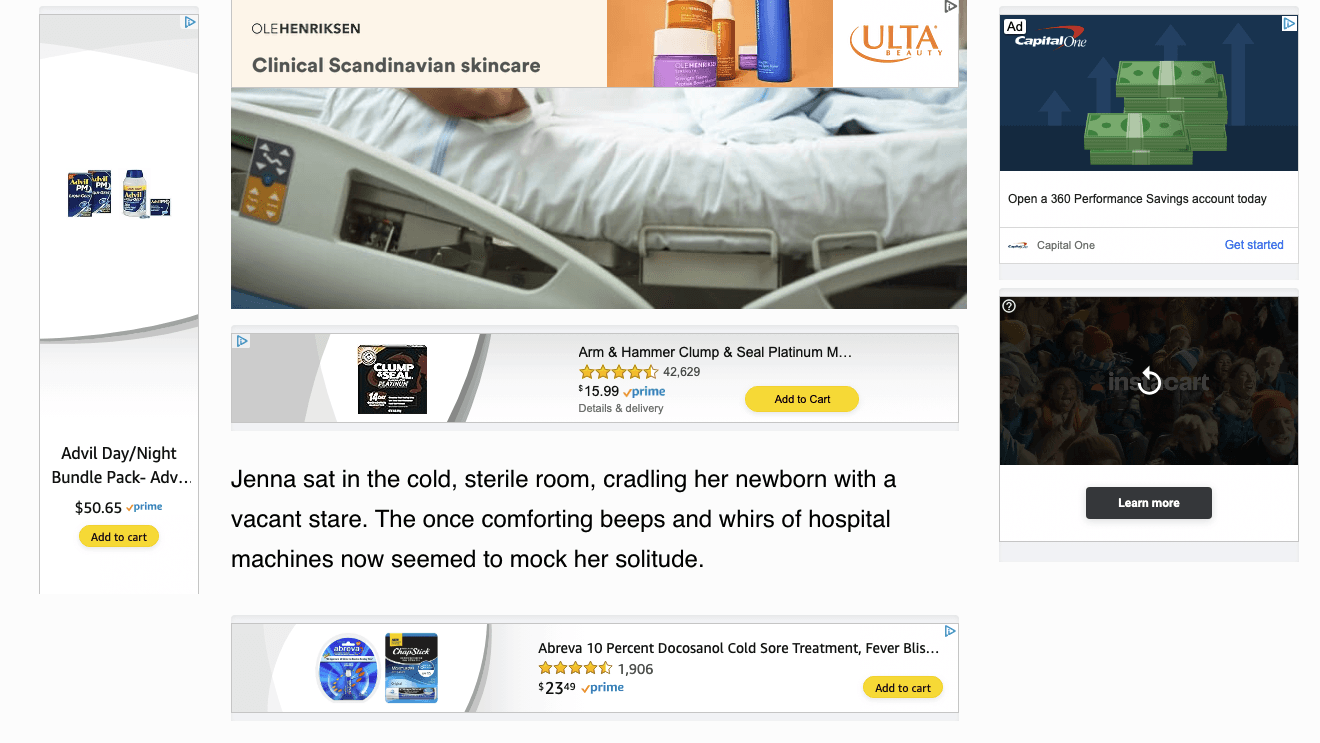
Screenshot of Haleon Abreva, Haleon Advil, and Church & Dwight owned “Arm & Hammer” ads observed via Amazon retail media network and/or Amazon DSP on a “Made for Advertising” website. Also visible are ads for Ulta Beauty.

Screenshot showing Colgate and Google Chromecast ads transacted via Amazon retail media network and/or Amazon DSP observed on a “Made for Advertising” website.
Large technology companies like Meta and Google were also observed as having their ads placed on “Made for Advertising” websites via Amazon retail media network and/or Amazon DSP.
Screenshot showing Google Pixel Tablet ad and another ad served via Amazon retail media network and/or Amazon DSP on a “Made for Advertising” website.
Many food brands were also observed transacting via Amazon DSP and/or Amazon retail media network on “Made for Advertising” sites. These included General Mills, Kellanova, Hershey’s, and others.
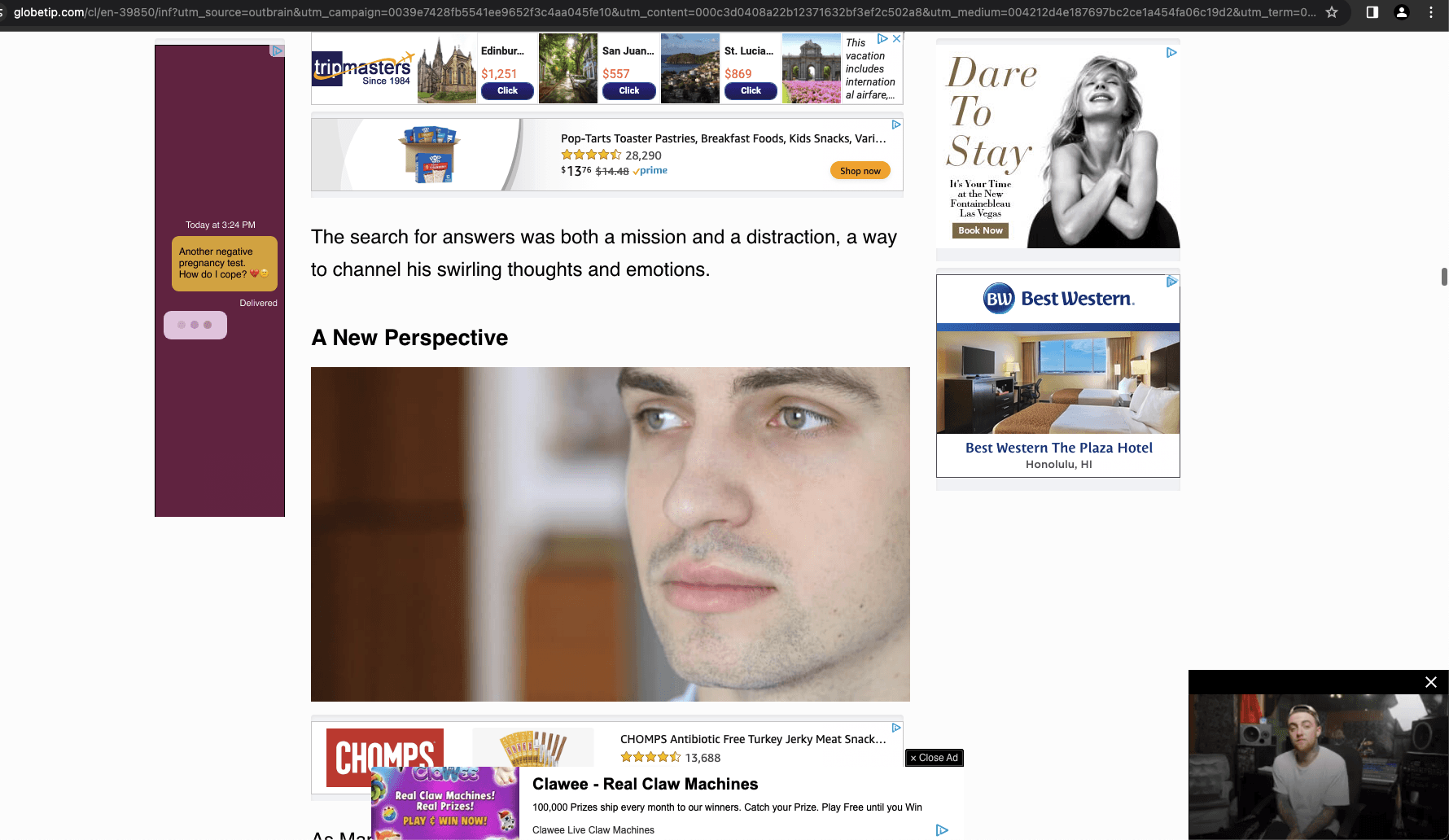
Kellanova Pop-tarts ads observed on a “Made for Advertising” website via Amazon’s retail media network
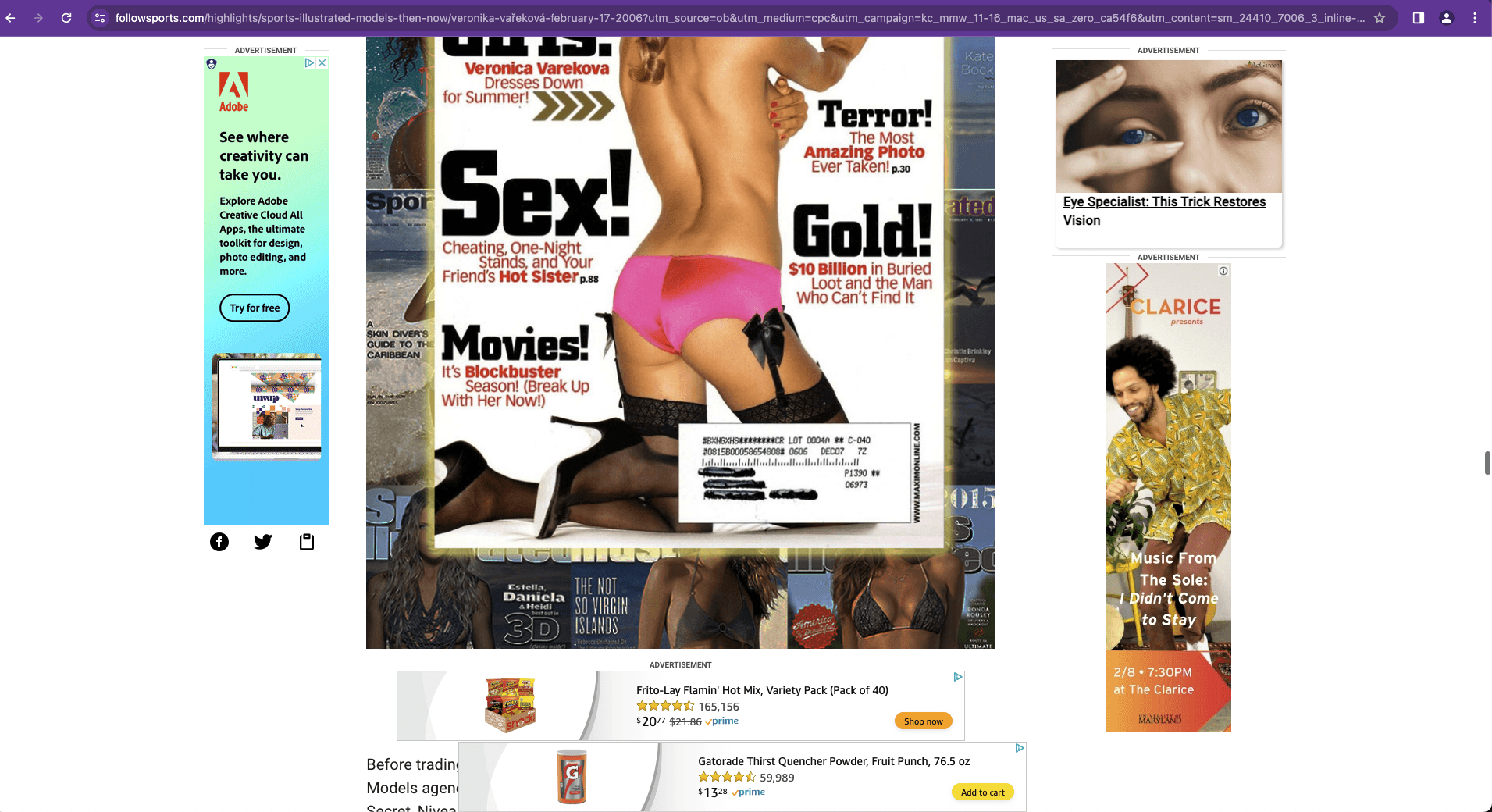
Screenshot of a Gatorade and a Frito-Lay ad observed on a “Made for Advertising” website not affiliated with Maxim, transacted via Amazon DSP and/or Amazon retail media network. Both brands are owned by PepsiCo.
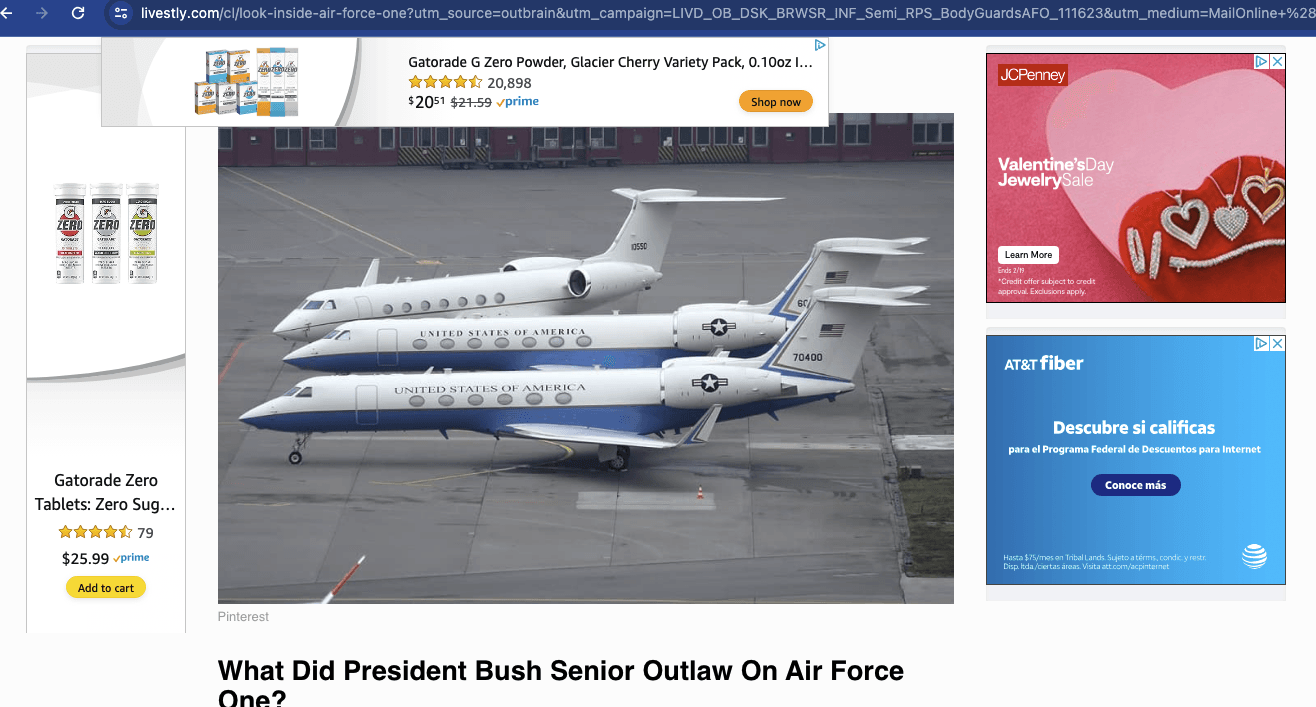
Screenshot of a Gatorade and a Frito-Lay ad observed on a “Made for Advertising” website, transacted via Amazon DSP and/or Amazon retail media network.
Hershey’s was observed serving dozens or hundreds of Reese’s, York Peppermint Pattie, Hershey’s Kisses, and other ads to the same individual consumer on auto-refreshing “Made for Advertising” pages. The ads were transacted via Amazon DSP and/or Amazon retail media network. For example, in the screenshot below, one can observe Reese’s ads served via Amazon retail media network and/or Amazon DSP on a “Made for Advertising” page titled: “He left his wife after she gave birth to a black baby, then DNA results showed the unthinkable.”
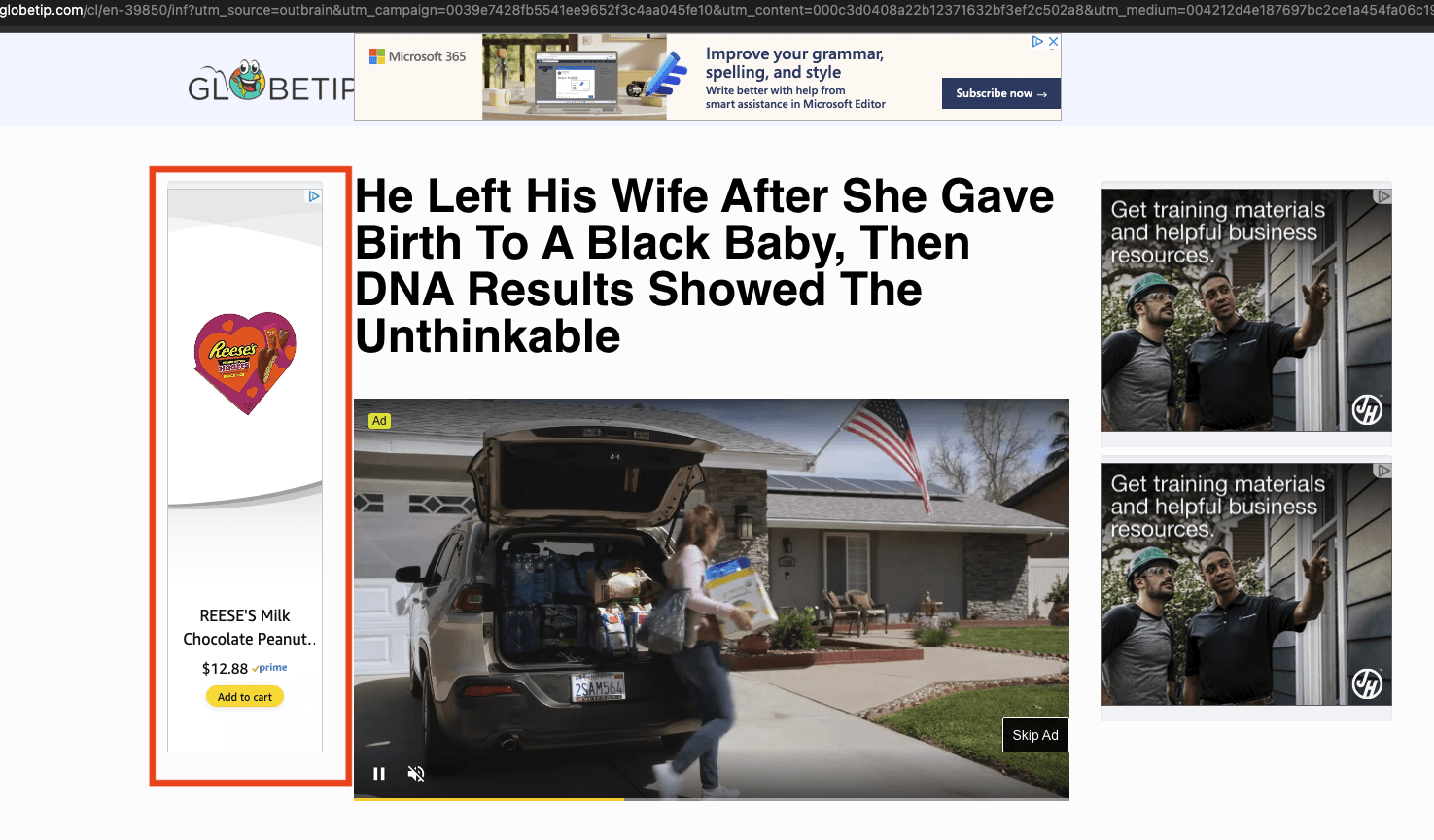
Screenshot of a Reese’s ad observed on a “Made for Advertising” website, transacted via Amazon retail media network and/or Amazon DSP.

Screenshot showing multiple ads transacted served on a “Made for Advertising” website. Three of the ads are for Hershey’s related products, and one is served through Amazon retail media network.

Screenshot of a Reese’s ad and a Gum ad observed on a “Made for Advertising” website, transacted via Amazon retail media network and/or Amazon DSP. Visible also are two ads for James Hardie, one ad for Reeds diamonds, and two Ulta beauty ads.
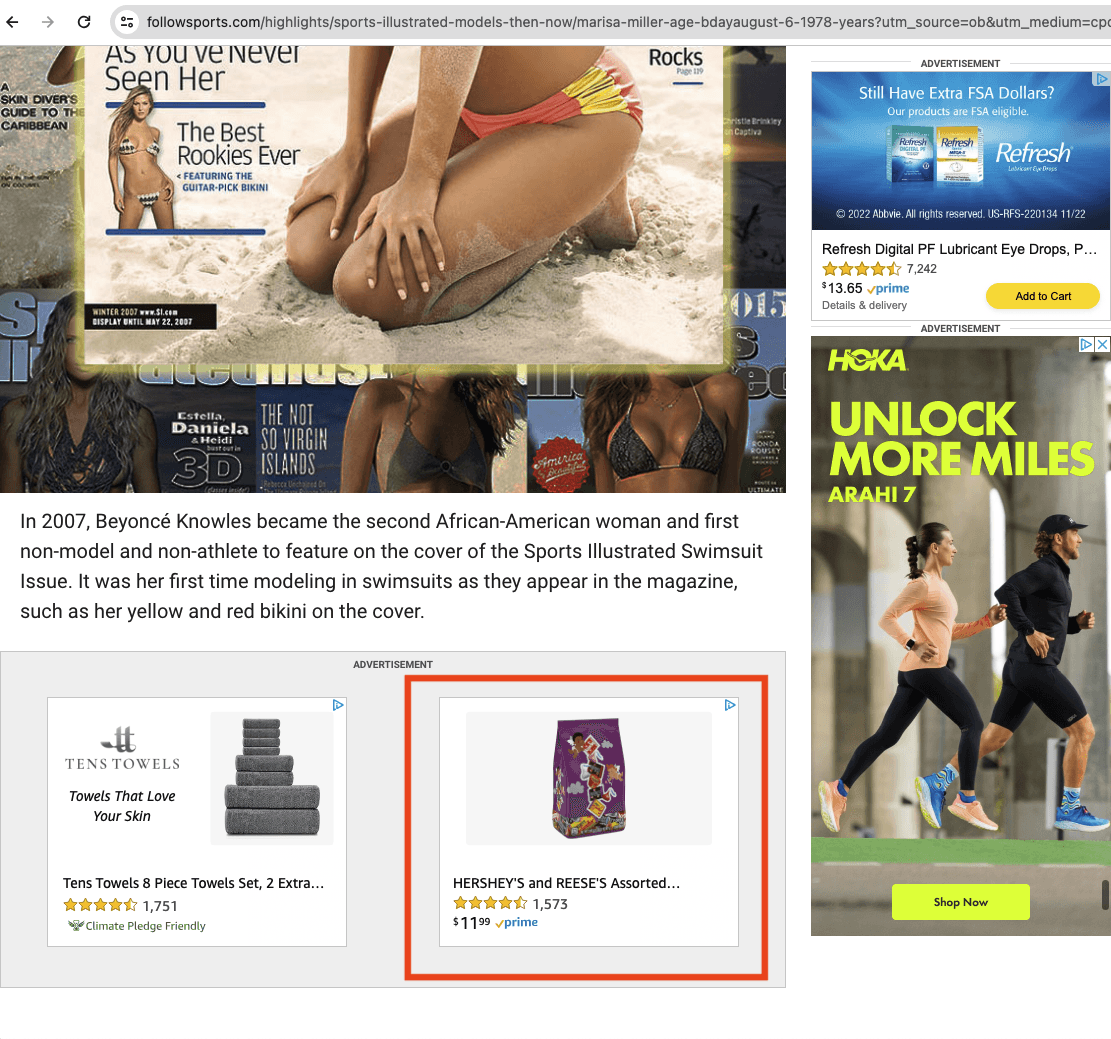
Screenshot of Hershey’s chocolate, Tens Towels, and Refresh eye lubricant ads observed on a “Made for Advertising” website, transacted via Amazon retail media network and/or DSP.

Screenshot of a Hershey’s Chocolate, Hershey’s York Peppermint Patties, Henkel (Schwarzkopf), and CHI 44 Iron Guard spray ads observed on a “Made for Advertising” website. Some of the ads were transacted via Amazon DSP and/or Amazon retail media network.
In the data table below, one can observe instances where a Hershey’s ad was served multiple times in a single page view session on an auto-refreshing “Made for Advertising” website in January 2024. For example, one consumer was served 121 Hershey’s ads via Amazon in a single page view session on an MFA website, for a total cost of $0.057. Another consumer was served 90 Hershey’s ads via Amazon on an auto-refreshing “made for advertising” page.
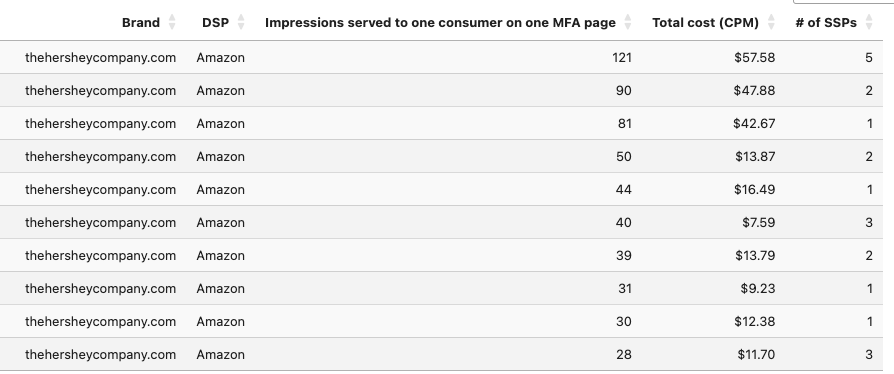
Table illustrating instances where an individual consumer was served multiple Hershey's ads via Amazon DSP and/or retail media network on an auto-refreshing “Made for Advertising”. Each row represents one individual and one page view session.
Hershey’s was not the only brand using Amazon DSP and/or Amazon retail media network that had hundreds of ad impressions served to the same individual consumer on an auto-refreshing, ad dense “Made for Advertising” website. Brands such as Nestle, Clorox, Coca-Cola, Bayer, Colgate, Oofos, Unilever, Mars, Google, Meta, Disney+, and General Mills (owner of Blue Buffalo) had hundreds of their ad impressions

Data table showing instances where a given brand’s ads were served hundreds of times via Amazon DSP to the same individual on a single auto-refreshing “Made for Advertising” website. The cost spent to reach that individual is extrapolated to a cost per thousand viewers reached.
Beyond the Amazon retail media network, there were a few instances where ads for various brands were observed on “Made for Advertising” websites through what appear to be other retailers’ offsite ad buys. For example, in the screenshot below one can observe a Unilever Dove ad served on a “Made for Advertising” website in 2024. The ad’s source code references: “Offsite Walgreens”, suggesting that the Unilever ad may have been transacted on an MFA website as part of a Walgreens offsite ad buy.

Screenshot of a Unilever Dove ad observed on a “Made for Advertising” website. The source code of the ad references “Offsite Walgreens”.
In another example, promotions for various PepsiCo products retailed through Giant grocery stores were observed on a “Made for Advertising” website. It is unclear whether these Pepsico ads were part of a Giant retail media network offsite ad buy.

Screenshot of an ad for PepsiCo products at Giant food store observed on a “Made for Advertising” website.
One Fortune 500 media executive told Adalytics:
| "There's a particular nuance to the MFA discussion that is very important for Food & Beverage companies: namely, how they impact attribution results. Most DSPs (like Amazon) use view-through attribution windows that are significantly longer than the average purchase cycle for groceries (14 days for platform reporting, and 28 days for AMC). Consider, then, how the "flooding of the zone" on MFA sites then interacts with attribution: by ensuring as many view-through events fire as possible, they are artificially inflating ROAS results by simply "collecting" purchases versus having any evidence of causal effect. This is the real issue with MFA sites, from a measurement perspective: they make an already untrustworthy measurement solution (attribution) completely unusable." |
Potential frequency capping violations and excess costs associated with serving ads to viewers on “Made for Advertising” websites
The ANA’s Programmatic Transparency Study mentioned that “Made for Advertising” websites can include “Rapidly auto-refreshing ad placements”, “numerous refreshing banner ads”, “autoplay video ads flood the site”, and “slide shows forcing visitors to click through multiple pages to access content, with multiple ads”.
During the course of this present observational study in January 2024, it was noted that some brands’ ads were served dozens, hundreds, or even thousands of times to the same individual on a single MFA page due to ad rotation or refreshes. It is unclear whether the media buyers’ configuring these ad campaigns simply forgot to set up frequency caps or whether DSPs are unable to properly implement frequency capping in situations whether there are dozens of redundant supply side intermediaries sending duplicated bid requests to a DSP and refreshing ad inventory quickly.
An ad tech software engineer with experience building Demand Side Platforms (DSPs) and bidders told Adalytics the following statement regarding the limitations of frequency capping:
“Some reasons why this is technically hard to deal with The first time I brought up the issue of DSPs not being able to properly frequency cap was around 2013. I was sitting with the CTO of [a major DSP] at the time explaining that we have a frequency cap on our [financial services brand] campaign which was spending well over a million dollars a month around tax season each year and that our frequency cap is not working. We had it set to something like 10 and it was serving over 500 imps to one cookie id in seconds. He was explaining that they do in fact have frequency caps on the lines that are working properly and that there are simply limitations to the architecture that doesn’t allow for guaranteed frequency capping. I came to understand these much better years later when we built our own bidder. In the end the only way to combat it was to use [domain exclusion] lists that made these sites ineligible for bids in the first place. The only thing there is that they are hard to identify (especially manually) and that there are new ones constantly popping up. Technically, the reason that it's hard to deal with frequency capping is that the architecture that we use on a DSP is distributed, high volume and scalable. Perfect for dealing with 100s of millions of requests per minute. But not very transactional. All of our writes and reads are asynchronous across many different servers (bid request handlers) with their own local caches as well as a centralized master cache which will all eventually be consistent. In the time that they are not consistent each server only knows about the requests that it receives and is not able to frequency or recency cap across the whole cluster for a couple of seconds. Although writes are sent to the master with frequency information about an id the whole cluster is not able to clone that data instantaneously. Because of this if a site sends 1000s of requests at once to a very large DSP (1000s of request handlers) it's very likely that many of those requests will be bid on without knowledge that other nodes in the cluster are also bidding. The banking industry deals with this using transactional databases where all data is consistent. This is not possible for the ad industry because of the large geographic reach (therefore slower network speed) of the campaign and the random nature of its delivery.” |
Regardless of the technical or setup reasons why frequency capping is not active, the net consequence of this is that a brand ends up paying astronomically high prices for very little incremental reach, which may negate the common industry assertion that programmatic in general and MFA in particular represent “cheap reach” inventory.
Six H&R Block ads on a website which meets the ANA’s, WFA’s, ISBA’s, 4A’s, Jounce Media, and DeepSee.io’s definition of “Made for Advertising” website. H&R Block works with Gale, a Stagwell Agency.

Seven AARP ads served simultaneously on a website not affiliated with Sports Illustrated which meets the ANA’s, WFA’s, ISBA’s, 4A’s, Jounce Media, and DeepSee.io’s definition of “Made for Advertising” website.

Four Air Force ads observed on a website which meets the ANA’s, WFA’s, ISBA’s, 4A’s, Jounce Media, and DeepSee.io’s definition of “Made for Advertising” website. H&R Block works with Gale, a Stagwell Agency.
In some observed instances, individual consumers were served thousands of ad impressions from the same brand in a single page view session on a “Made for Advertising” website. For example, in the data table below one can observe the experiences of ten different consumers on 10 different “Made for Advertising” articles in January 2024. The first row shows how one consumer was shown 835 Kroger ads in a single page view session. Kroger paid $5.49 for the ads, which if translated to a cost to reach one thousand users, would equate to $5,491. Paycor had 1,279 ad impressions served to another consumer on a different day and MFA page; paycor paid $3.44 to reach to a viewer, which would translate to a cost of $3,437 per 1000 consumers reached.
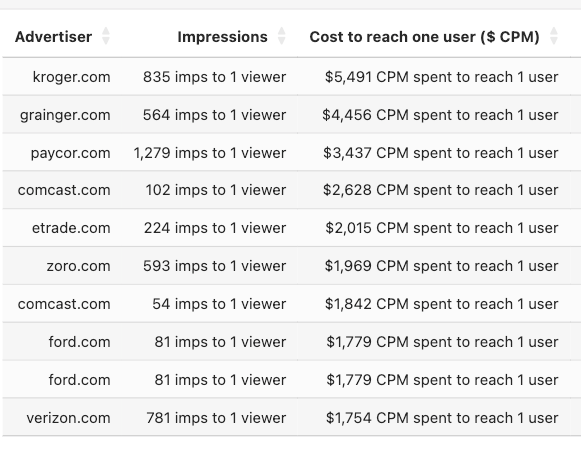
Data table showing the experiences of ten different consumers reading different articles on various “Made for Advertising” websites. Each of the consumers was shown many impressions from the same brand.
The barplot below illustrates some brands paid to serve ads thousands of times to the same individual during a page view session on a single “Made for Advertising” article. For example, H&R Block had 2,117 ad impressions served to one person on one page. Paycor had 1,279 ads served to another individual on a different MFA page.

Barplot illustrating how some brands paid to serve ads thousands of times to the same individual during a page view session on a single “Made for Advertising” article. For example, H&R Block had 2,117 ad impressions served to one person on one page. Paycor had 1,279 ads served to another individual on a different MFA page.
The next barplot below illustrates how much brands paid to reach an individual consumer on a “Made for Advertising” article. For example, Kroger paid $5.49 to reach one individual. If one were to extrapolate this rate to the cost to reach 1000 unique consumers on an MFA website, Kroger would have to pay $5,490 to reach 1000 consumers on auto-refreshing MFA websites. Comcast paid $2.68 to reach one consumer on a “Made for Advertising” website. If this price point were extrapolated to the cost to reach 1000 unique consumers, Comcast would pay $2,628 to reach one thousand readers of “Made for Advertising” inventory.

Given that some industry commentators refer to “Made for Advertising” inventory or programmatic inventory in general as “cheap reach”, the rates various brands paid were juxtaposed with the average cost of advertising on the Super Bowl halftime show ($71 average CPM, accounting for the total viewership of the Super Bowl), Netflix ($55 CPMs), or a premium email newsletter ($25 CPMs).
This comparison was designed to illustrate how many different unique consumers a brand could have reached in lieu of advertising to one viewer on an auto-refreshing “Made for Advertising” website. For the price that Kroger paid to reach one consumer with hundreds of ads on a single page view session ($5.49 or $5,490 per 1000 viewers), Kroger could instead have reached 77 distinct consumers watching the Super Bowl, 100 different Netflix viewers, or 220 email newsletter subscribers.
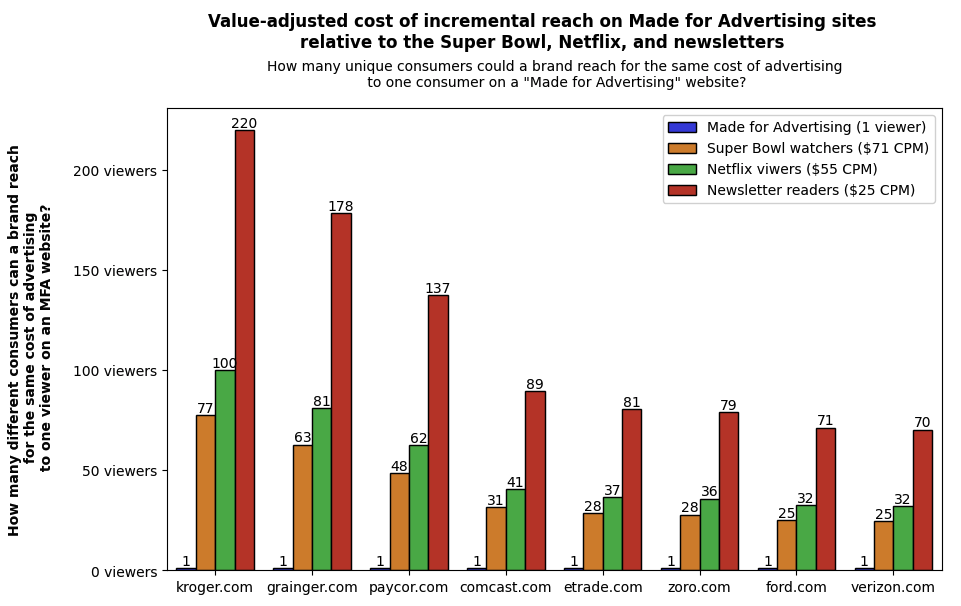
Barplot illustrates how many different consumers a brand could have reached with ad placements through four different channels - “Made for Advertising” websites, the Super Bowl, Netflix video ads, or email newsletter ads. Higher is better in this incremental reach graph - e.g., it is better to reach 100 different people with your ad than to serve the ad to only 1 person many times over.
For the price that Comcast paid to reach one consumer with hundreds of ads on a single page view session ($2.68 or $2,628 per 1000 viewers), Comcast could instead have reached 33 distinct consumers watching the Super Bowl, 41 different Netflix viewers, or 89 email newsletter subscribers.
The inability to deploy frequency capping correctly on bid duplicating, auto-refreshing “Made for Advertising” websites suggests that while MFA sites may have relatively cheap per impression costs (low CPMs), these sites are incredibly expensive from the perspective of cost-per-incremental reach. If media buyers optimize towards a large volume of low cost impressions, they may inadvertently end up reaching very few consumers at astronomically high prices. As such, media buyers and procurement professionals must consider whether their intention is to optimize for low cost of impressions or low cost of reaching incremental new consumers.
Media agencies observed transacting ads on “Made for Advertising” websites in 2024
The ANA’s Programmatic Transparency Study recommended that: “Advertisers must become far more responsible and provide more active stewardship of their media investments. Media is often the largest marketing expenditure at most companies. Advertisers need to “lean in” and be more active stewards of their media investments rather than delegating that entirely to their agencies. If delegated, they need to ensure the agencies are working in the marketer’s best interest. Advertisers who outsource their media management without active internal stewardship do so at their risk.”

Screenshot from the ANA’s Programmatic Media Supply Chain Transparency Study — First Look
Given the emphasis the ANA put on this recommendation (it was the first one listed in the “First Look Recommendation Summary”), this report examined client side forensics and references in the source code of ads indicative of which media agencies were transacting various brands’ ads on “Made for Advertising” websites in January 2024.
Several media agencies also issued public statements about various approaches or initiatives related to “made for advertising” websites.
GroupM announced “the introduction of new protections against Made For Advertising (MFA) websites and domains”, which “will see GroupM integrate Jounce’s industry-leading technology in tracking MFA domains with GroupM’s leading campaign planning processes.”
GroupM’s MindShare or Xaxis was observed potentially transacting ads for Volvo, Ford and John Deere on MFA. Essence was observed potentially transacting ads for Google on MFA.

Screenshot of an ad for Ford observed on a website which meet’s the ANA’s, WFA’s, ISBA’s, 4A’s, and DeepSee.io’s definition of “Made for Advertising” website. The source code of the Ford ad reference’s GroupM’s programmatic trading desk Xaxis.
The global head of brand assurance at Dentsu told Digiday: “In terms of priorities for 2024, MFAs are currently about a 4 out of 10 [...] we are confident that our current approach is successful”. Dentsu’s Carat and Merkle were observed potentially transacting ads for General Motors and Safeway (respectively) on MFA.

Screenshot showing four Cadillac General Motors ads served on a website which meet’s the ANA’s, WFA’s, ISBA’s, 4A’s, Jounce Media’s, and DeepSee.io’s definition of “Made for Advertising” website. The “Why this ad?” info modal shows the ads were placed by Dentsu’s Carat subsidiary. These and other Cadillac ads were placed using Google’s DV360 DSP and Index Exchange, TripleLift ad exchange.
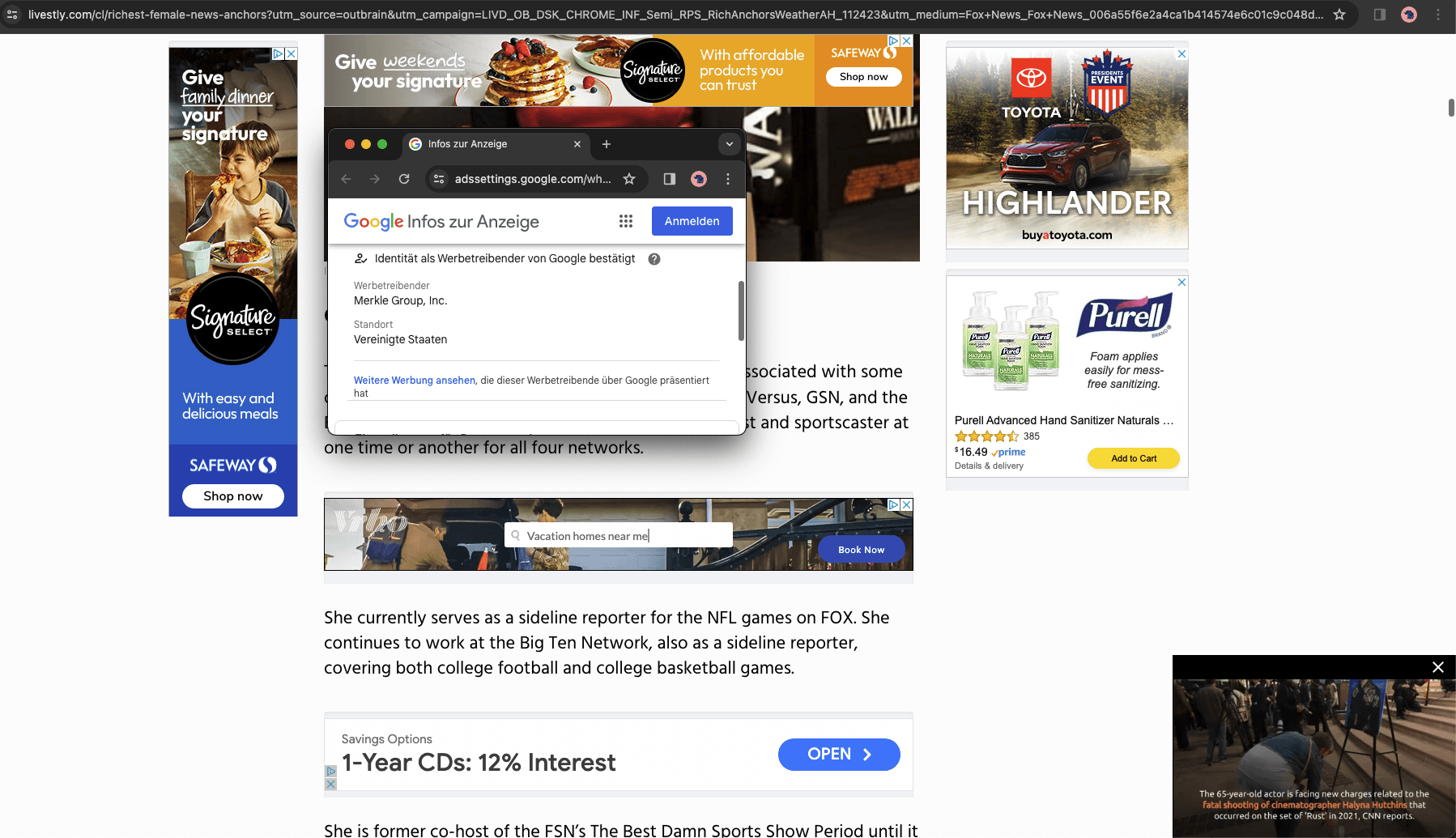
Screenshot showing Safeway ads served on a website which meets the ANA’s, WFA’s, ISBA’s, 4A’s, Jounce Media’s, and DeepSee.io’s definition of “Made for Advertising” website. The “Why this ad?” info modal shows the ads were placed by Dentsu’s Merkle subsidiary.
Digiday reported that the SVP and head of precision media at Digitas (Publicis), said that MFAs are still a “higher priority” in 2024, but between the targeting tools and MFA filters created by Publicis Groupe and DSPs like The Trade Desk, she said she feels her team is in a strong position to maintain the “pursuit of quality inventory” in the new year.
Publicis was observed potentially transacting ads for Verizon, Sonic Drive-In (part of Inspire Brands), Hulu, AAA, Toyota, Edenred, Citi, Starbucks, Marriott, Haleon, Walmart, USAA, Campbell Soup Company, Vanguard, Wingstop, and Lowe’s on MFA.
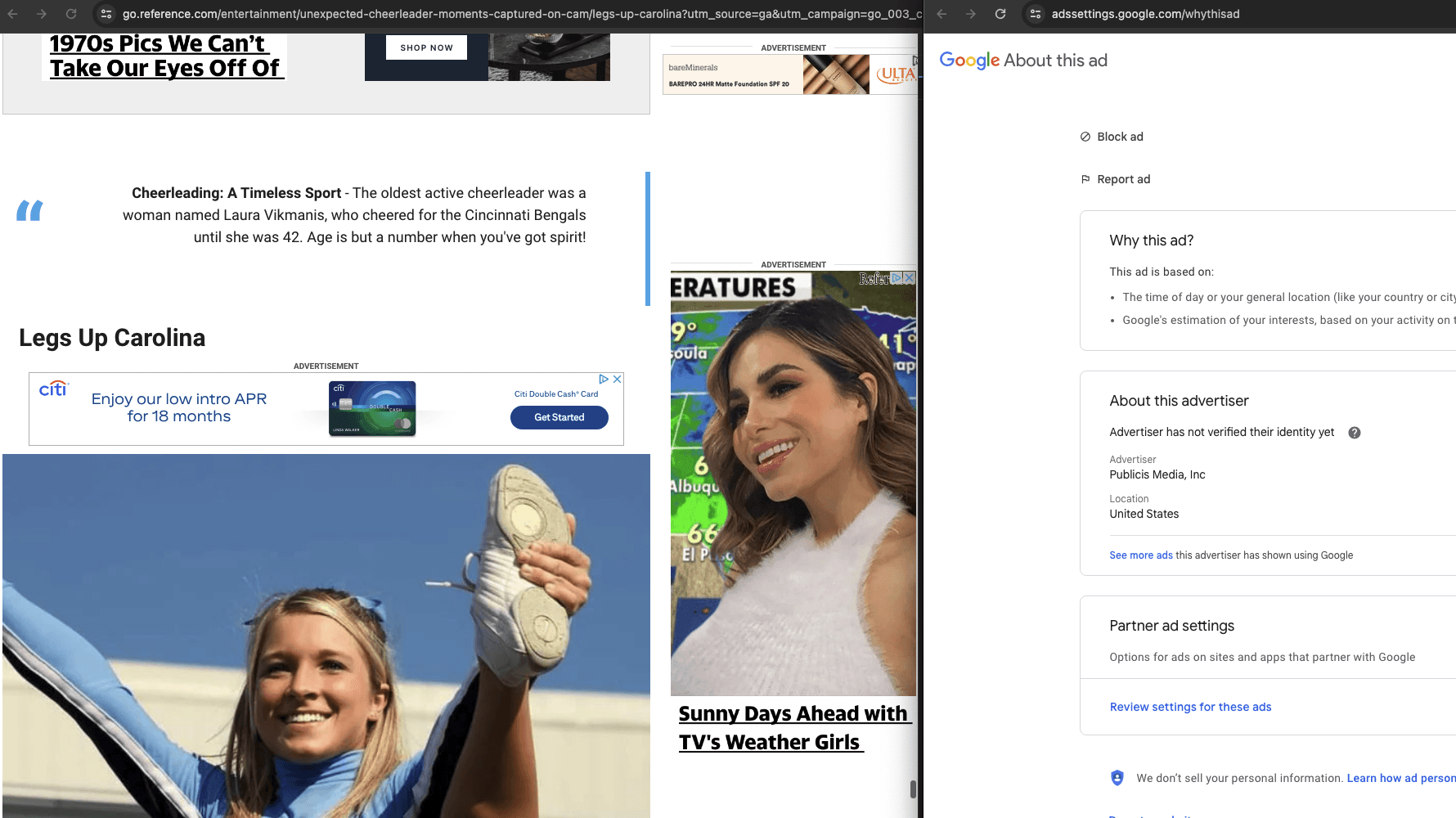
Screenshot showing Citibank ads served on a website which meets the ANA’s, WFA’s, ISBA’s, 4A’s, Jounce Media, and DeepSee.io’s definition of “Made for Advertising” website. The “Why this ad?” info modal shows the ads were placed by Publicis Media.
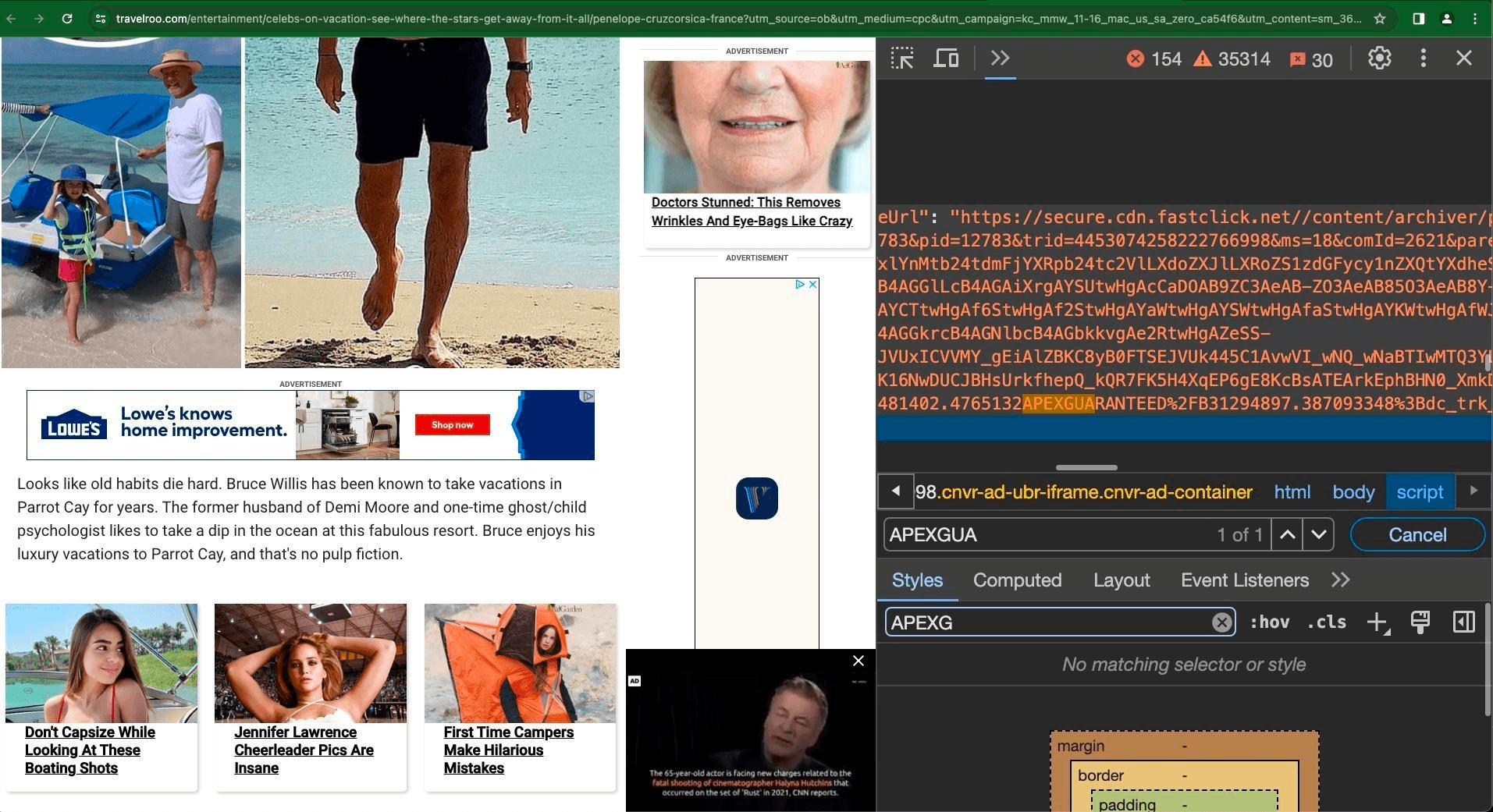
Screenshot showing a Lowe’s ad served on a website which meets the ANA’s, WFA’s, ISBA’s, 4A’s, Jounce Media’s, and DeepSee.io’s definition of “Made for Advertising” website. The source code of the ad includes CM360 pixel references to “APEX Guaranteed”. APEX is a Publicis owned “trading entity [...] that identifies and invests in emerging market trends to benefit Publicis clients”
In the screenshot below, one can observe 58 HTTPS requests (potentially indicative of dozens of ad impressions served) on a “Made for Advertising” website, wherein the requests reference “APEX Guaranteed”. APEX is a Publicis owned “trading entity [...] that identifies and invests in emerging market trends to benefit Publicis clients.”

Screenshot showing Chrome developer tools’ Network tab open on a website which meets the ANA’s, WFA’s, ISBA’s, 4A’s, Jounce Media’s, and DeepSee.io’s definition of “Made for Advertising” website. The network tab shows 58 distinct HTTPS requests sent to a CM360 pixel endpoint that references “APEX Guaranteed”. APEX is a Publicis owned “trading entity [...] that identifies and invests in emerging market trends to benefit Publicis clients''
Omnicom Media Group’s CEO told Digiday in a December 2023 article that Omnicom has “been investing a lot of time and resources, partnering with vendors, partnering with technology companies in really screening websites for MFA-suspicious activity. And once that’s been confirmed, they’re being weeded out.”

Screenshot from a December 2023 Digiday article interview with the CEO of Omnicom Media Group
Omnicom was observed transacting Tropicana, Cogeco, and AT&T ads on MFA in January 2024.

Screenshot showing Tropicana ads served on a website which meets the ANA’s, WFA’s, ISBA’s, 4A’s, Jounce Media, and DeepSee.io’s definition of “Made for Advertising” website. The “Why this ad?” info modal shows the ads were placed by OMD, an Omnicom subsidiary.

Screenshot showing two Bentley ads served on a website which meets the ANA’s, WFA’s, ISBA’s, 4A’s, Jounce Media, and DeepSee.io’s definition of “Made for Advertising” website. The “Why this ad?” info modal shows the ads were placed by PHD. PHD Media is a subsidiary of Omnicom.

Screenshot showing a AT&T ad served on a website which meets the ANA’s, WFA’s, ISBA’s, 4A’s, Jounce Media, and DeepSee.io’s definition of “Made for Advertising” website. The “Why this ad?” info modal shows the ads were placed by Hearts & Science. Hearts & Science is a subsidiary of Omnicom.
The Director of Supply Intelligence at IPG’s KINESSO subsidiary wrote that: “At KINESSO, we have generated an arsenal of tactics to help us review inventory and weed out MFAs.”
IPG was observed transacting ads for Bristol Myers Squibb, American Express, BMO Bank, Charles Schwab, Johnson & Johnson, Kenvue, Truvia, Gilead, and CVS on MFA sites. Other brands which allegedly work with IPG and had their ads served on “Made for Advertising” websites include Amazon, Enterprise, Lucid Motors, and Constellation Brands (Corona beer).

Screenshot showing two CVS ads served on a website which meets the ANA’s, WFA’s, ISBA’s, 4A’s, Jounce Media, and DeepSee.io’s definition of “Made for Advertising” website. The source code of the CVS ads includes CM360 ad server pixels with references to “Matterkind”, an IPG subsidiary now known as KINESSO.

Screenshot of six Charles Schwab ads served on a website which meets the ANA’s, WFA’s, ISBA’s, 4A’s, and DeepSee.io’s definition of “Made for Advertising” website. The ads were transacted by IPG media agency, using Google DV360 DSP, multiple ad exchanges (OpenX, Magnite, Index Exchange), and were monitored by DoubleVerify. The consumer was shown 67x total Schwab ads on this one page in less than 10 minutes, in addition to ads for dozens of other brands.
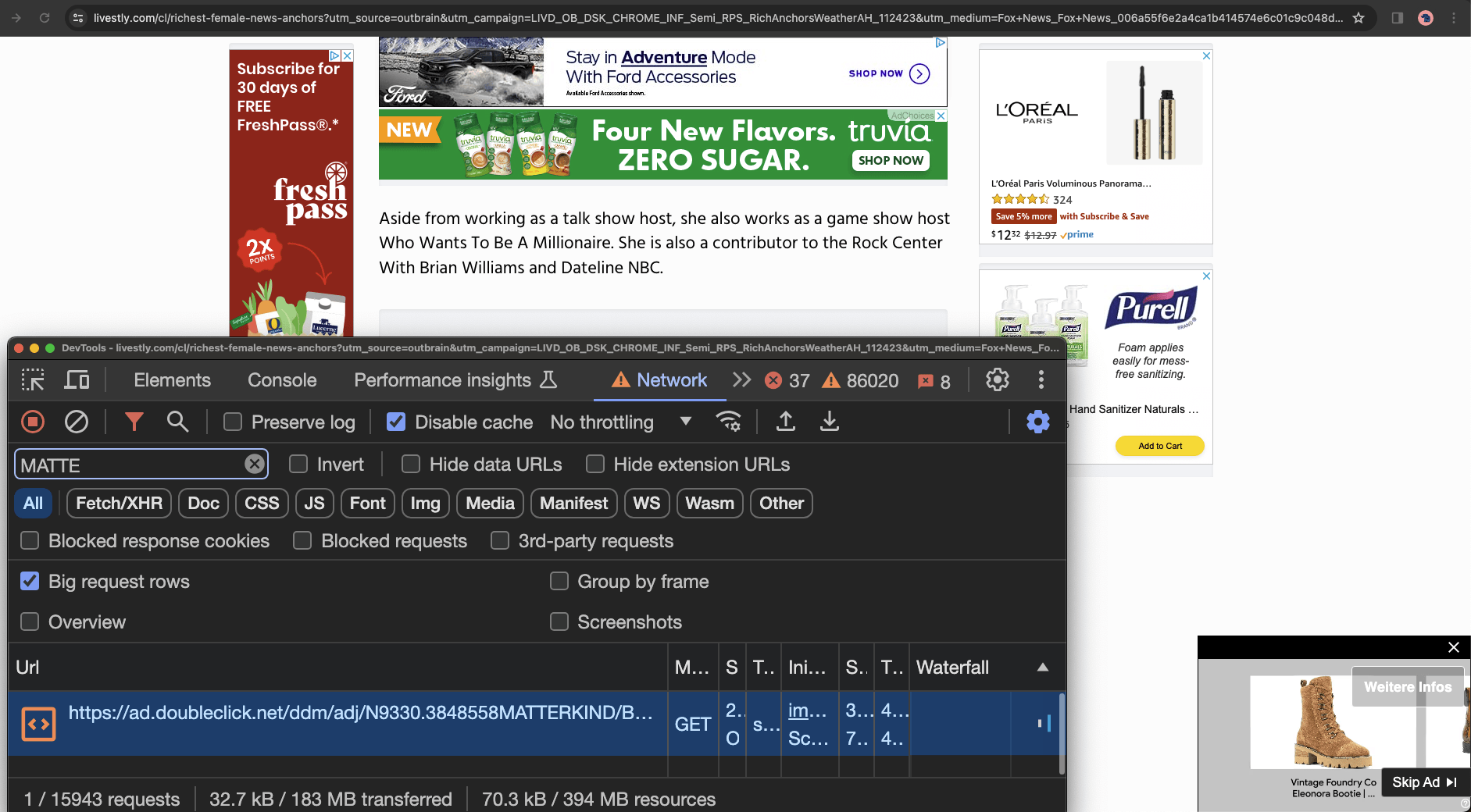
Screenshot showing a Truvia ad served on a website which meets the ANA’s, WFA’s, ISBA’s, 4A’s, Jounce Media, and DeepSee.io’s definition of “Made for Advertising” website. The source code of the Truvia ads includes CM360 ad server pixels with references to “Matterkind”, an IPG subsidiary now known as KINESSO.
Campaign reported that “agencies like Havas Media Group are pioneering curated marketplaces designed to meticulously filter out MFAs from quality inventory.” The SVP of Investment Operations at Havas Media Group said that: “We’ve raised the issue of MFAs with a lot of our clients in the past but it failed to get much traction until the ANA report [...] The investigation has helped validate some of the work we were already doing and more importantly given us client buy-in to do more.”
Havas was observed potentially transacting ads for Sanofi, Choice Hotels, Urovant, and NewYork-Presbyterian Hospital on “Made for Advertising” websites in January 2024.
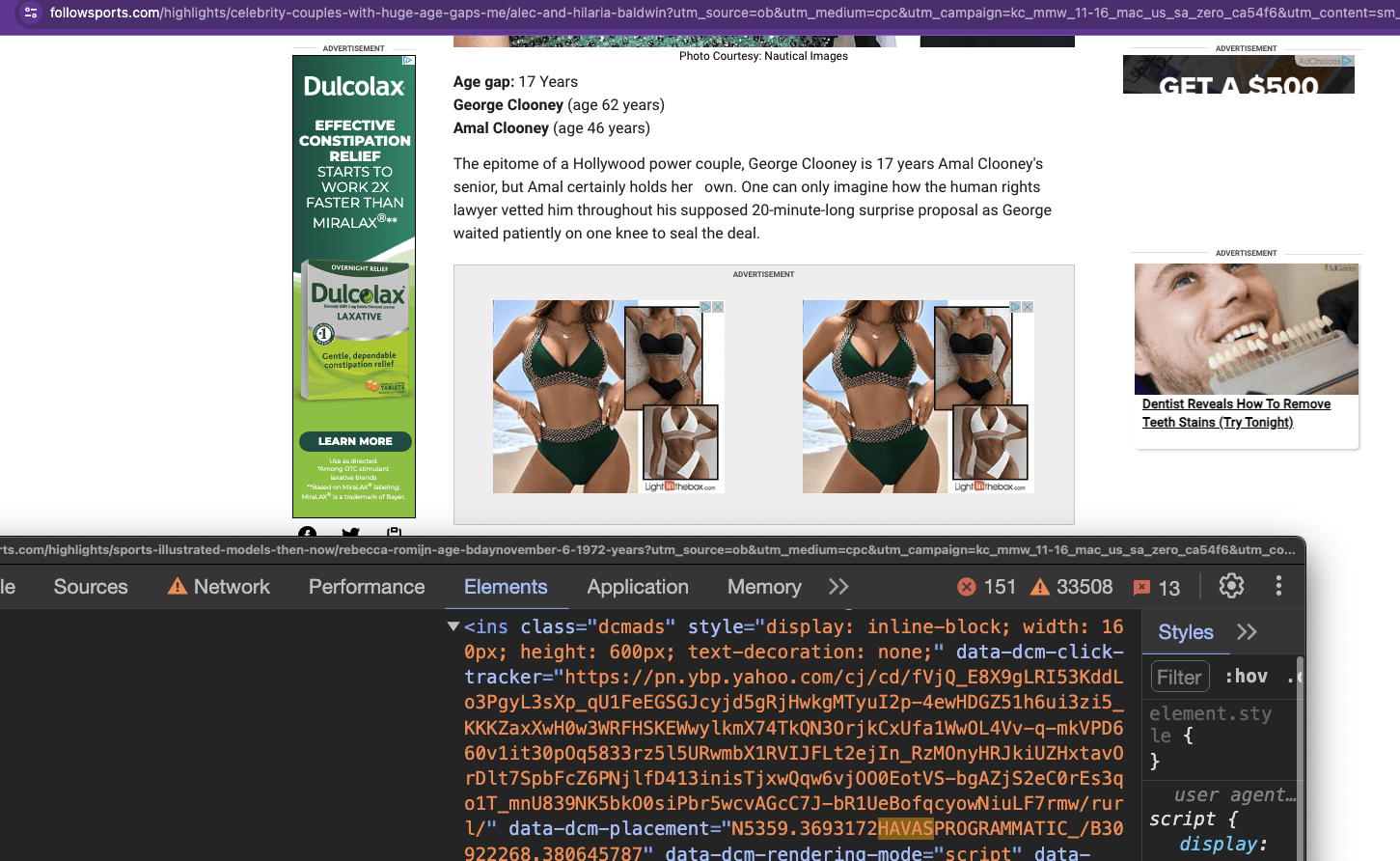
Screenshot showing a Sanofi Dulcolax ad served on a website which meets the ANA’s, WFA’s, ISBA’s, 4A’s, Jounce Media, and DeepSee.io’s definition of “Made for Advertising” website. The source code of the Sanofi ad includes CM360 ad server pixels with references to “Havas Programmatic”.
Stagwell’s Gale was observed transacting thousands of H&R Blocks ads to the same few individuals on auto-refreshing “Made for Advertising” site ad slots.

Screenshot showing two H&R Block ads served on a website which meets the ANA’s, WFA’s, ISBA’s, 4A’s, Jounce Media, and DeepSee.io’s definition of “Made for Advertising” website. The “Why this ad?” info modal shows the ads were placed by Gale Partners. Gale is a subsidiary of Stagwell.
Horizon Media was observed transacting United Healthcare and SleepNumber ads on MFA sites via DV360 and using DoubleVerify.
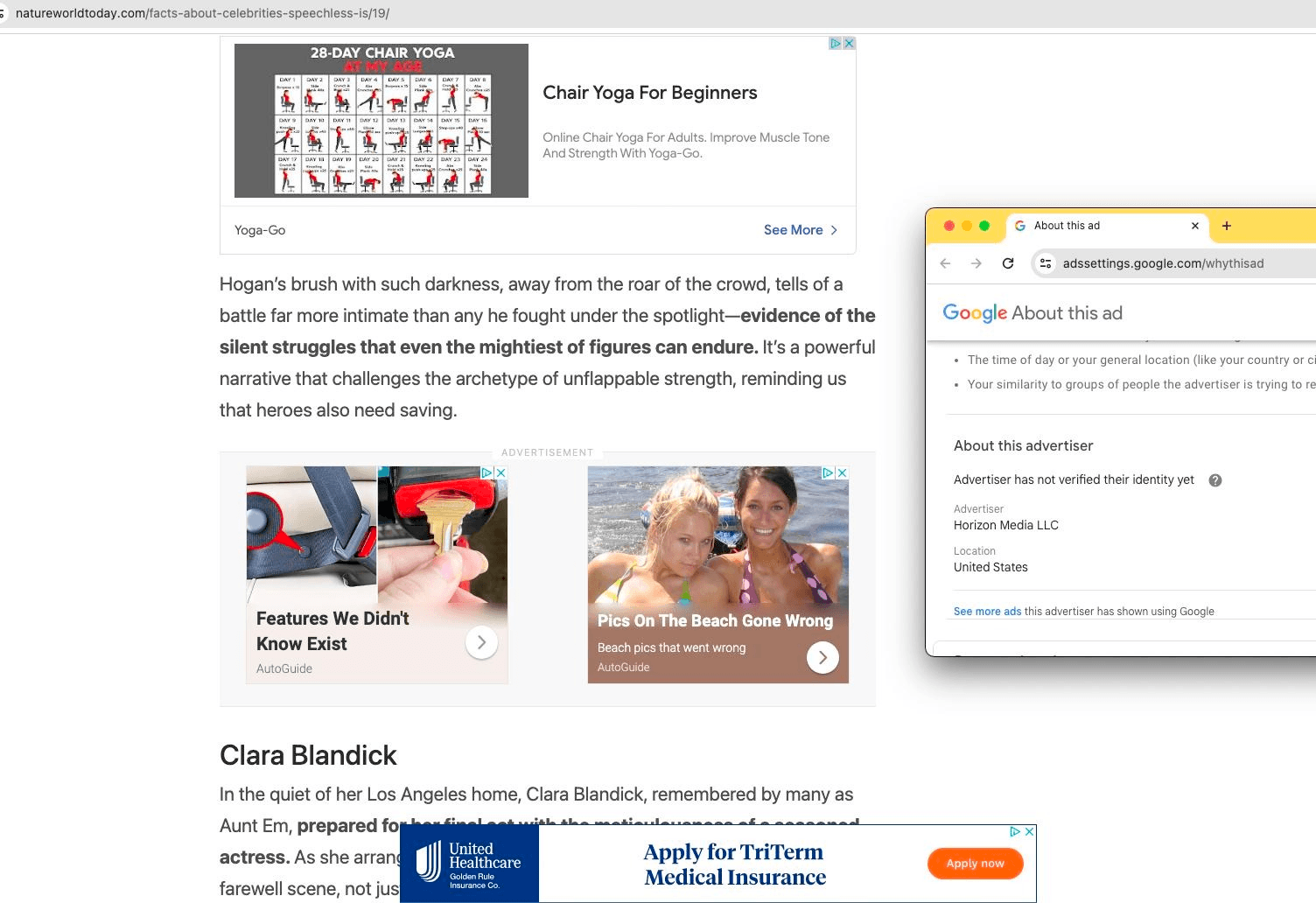
Screenshot showing a United Healthcare ad served on a website which meets the ANA’s, WFA’s, ISBA’s, 4A’s, Jounce Media, and DeepSee.io’s definition of “Made for Advertising” website. The “Why this ad?” info modal shows the ads were placed by Horizon Media.
Microsoft Audience Network
Microsoft operates the Microsoft Audience Network, which it describes as driving “highly personalized engagements with your ideal customers, powered by Microsoft AI.” The network is described as “your ads on premium sites where customers are spending time today.”
Microsoft lists Fox Business, Bing, CBS Sports, MSN and Outlook.com as examples of Microsoft Audience Network sites.
 Screenshot of Microsoft’s website describing the “Microsoft Audience Network.”
Screenshot of Microsoft’s website describing the “Microsoft Audience Network.”
Microsoft Audience Network allows “you to grow your audiences with first-party intent data; applying machine learning to combine search and web activity with LinkedIn and demographic profiles to increase your marketing performance.”
The Microsoft Audience Network: “Premium native placements: strict publisher standards and artificial intelligence (AI)-powered curation.”, “Brand-safe experiences: transparency and controls for advertisers.” “Highly contextual ad placements based on Microsoft first-party intent data.” and “Strong industry ad performance driven by leading AI technology.”
Microsoft further states: “Building upon our brand safety foundations, we are now integrated with Integral Ad Science (IAS) — the global leader in digital ad verification — to offer an additional layer of brand safety protection on the Microsoft Audience Network. Through this pre-bid integration, only validated inventory from IAS will be served on our network.”
During the course of this observational research study in January 2024, thousands of different brands - ranging from Fortune 500 and government entities to small family owned businesses - appeared to have their ads transacted on auto-refreshing, ad dense “Made for Advertising” sites specifically via Microsoft Audience Network.
Many of these ads could be identified via ad creative source references to “ads.msan.com” or “msanretailgroupedbrands.com”, or “Microsoft Audience Network CPG Grouped Brands”.
The list of brands whose ads appear to have been transacted on “Made for Advertised” sites via Microsoft Audience Network included:
the United States Navy, the United States Social Security Administration (SSA), General Motors, Volkswagen, DoorDash, Mutual of Omaha, T. Rowe Price, Meijer, Temu, Lululemon, Duluth Trading Co, Macy’s, Volvo, Triton Contracting, Hilton, Shein, Victoria’s Secret, Hello Fresh, LVMH (Tag Heuer watches, Burberry, JCPenny, Four Seasons Hotels and Resorts, DSW, Groupon, Kelly Blue Book, Keurig Green Mountain, Petco, Carmax, Allianz Trade, Blue Buffalo Company, Godiva, Dicks Sporting Goods, Nike, ExxonMobil, Dell, Anthem Blue Cross, SalesForce, Lenovo, IdentityIQ, Bed Bath and Beyond, Visit Orlando, Discover Financial Services, Puma, Kohl’s, Upwork, Airbnb, Medtronic, Dockers, Dyson, Grainger, and many others.
It is unclear to what degree AI was involved in placing these brands’ ads on “Made for Advertising” websites.
Google Remarketing Grouped Brands
Google Ads offers a remarketing capability, which “allows you to show ads to customers who have previously visited your website or used your mobile app.”
The source code of some ads observed on “Made for Advertising” websites in January 2024 included references to “Google Remarketing” “Grouped Brands”. There were 978 brands, including both large Fortune 500 brands which ANA members as well as many SMBs.
The list of advertisers whose ads appeared on “Made for Advertising” websites and whose ad source code included references to “Google Remarketing” includes Temu, Mcafee, Algolia, HelloFresh, Wallet Gear, Eddie Bauer, Hoka (running shoes), Frontier airlines, Godaddy,, University of Denver, US Foods, Veterans of Foreign Wars (non-profit), and hundreds of others.
Google Video Partners (GVP) network
The ANA states: “MFA sites [...] perform higher on video completion rates, often with autoplay ads that have the sound off.” Informed by the ANA’s insight, this study documented instances where brands’ had video ads served on “Made for Advertising” sites that were both autoplaying and with sound off.
During the course of this empirical research study in January 2024, various brands were observed to have their YouTube video ads served in muted, auto-playing, outstream video players on “Made for Advertising” sites. The YouTube video ads were served through “Google video partners”.
“Google video partners are high-quality publisher websites and mobile apps where you can show your video ads to viewers beyond YouTube.” According to Google’s public documentation, “Video partner publishers are carefully vetted and must meet Google's inventory quality standards.”
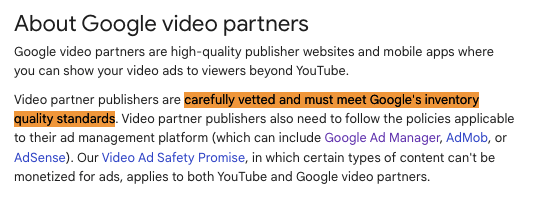
Source: Google
For example, in the screenshots below, one can observe YouTube hosted video ads for Chico’s, Agoda, and Vrbo being served in a muted, auto-playing out-stream video player on a “Made for Advertising” website in 2024.

YouTube hosted video ad for Chico’s playing in a muted, auto-playing, outstream video player on a website which meets the ANA’s, WFA’s, ISBA’s, 4A’s, Jounce Media, and DeepSee.io’s definition of “Made for Advertising” website.
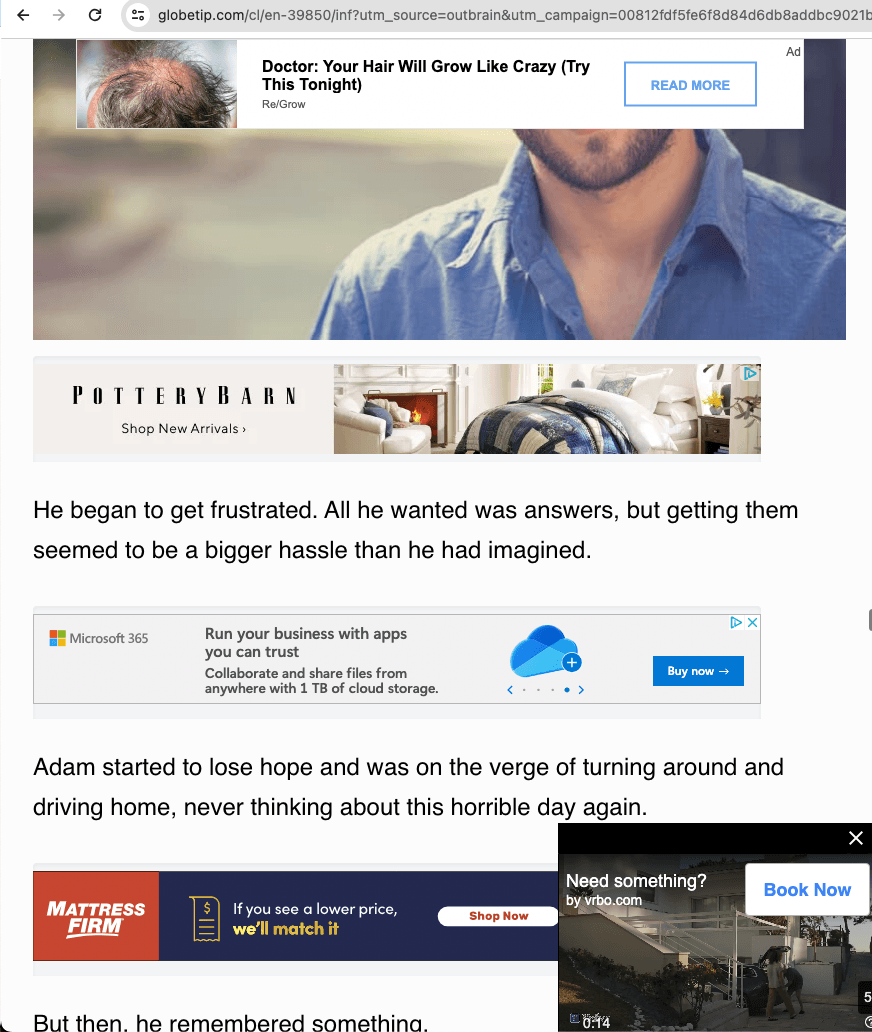
YouTube hosted video ad for Vrbo playing in a muted, auto-playing, outstream video player on a website which meets the ANA’s, WFA’s, ISBA’s, 4A’s, Jounce Media, and DeepSee.io’s definition of “Made for Advertising” website.

YouTube hosted video ad for Agoda playing in a muted, auto-playing, outstream video player on a website which meets the ANA’s, WFA’s, ISBA’s, 4A’s, Jounce Media, and DeepSee.io’s definition of “Made for Advertising” website.
Conclusion
Caveats & Limitations
Interpreting the results of this observational study requires nuance and caution.
Firstly, this study analyzed a sample of websites which meet the ANA’s, WFA’s, ISBA’s, 4A’s, Jounce Media, and/or DeepSee.io’s definition of “Made for Advertising” website. However, some media buyers or vendors may use different definitions of “Made for Advertising” than the aforementioned trade groups and industry thought leaders. As such, each buyer or reader should evaluate the observations presented in this study within the lens of their own working definition of “Made for Advertising”.
Secondly, this study looked at a sample of twenty two MFA websites, whereas thousands more websites may meet the ANA’s, WFA’s, ISBA’s, 4A’s, and DeepSee.io’s definition of “Made for Advertising” in a comprehensive census of ad-support internet websites. As such, all quantitative and qualitative conclusions drawn from these observations should be appropriately interpreted within the scope of this study’s methodology. For example, it is possible that while some vendors may place a relatively high number of brands’ ads on the twenty two “Made for Advertising” websites selected in this study’s sample, they may place relatively fewer ads on other MFA sites relative to other vendors.
This study makes use of empirical data and open-source datasets that can be easily verified and replicated by other independent researchers. Ultimately the methodology represents only a sample of the entire ad ecosystems. As such, any numbers cited in this report must be construed as estimates and may not be representative of the broader ad ecosystem. Brands are encouraged to audit their own media buys to analyze how much each brand spent via a given vendor on websites which meet the brand’s own definition of “Made for Advertising.”
This report is not meant to be construed as a comprehensive or quantitative audit. It cannot assert whether one vendor transacts more or less “Made for Advertising” impressions relative to another. It cannot assert whether one particular brand or agency spent more or less than another on “Made for Advertising” websites in general. It cannot ascertain which participant in a media supply chain implicitly or explicitly made a decision to transact MFA. The scholastic, observational nature of this study simply allows a binary, qualitative assessment of whether or not a given vendor was observed transacting ads on websites which are consistent with consensus definitions of “Made for Advertising” in January 2024.
The study relied entirely upon publicly accessible or available data; it made use of no proprietary or internal data on how ads are placed or paid for. Because the study was entirely based on browser client-side empirical observations, post-ad impression reconciliations, or corrections that take place are not within the scope of this research.
Furthermore, this study used various digital forensics analyses of various indicators. Some technical indicators, such strings referring to specific vendors, may change over time. For example, one vendor may acquire the assets or clients of another vendor. As such, readers are encouraged to confirm whether or not a given brand or advertiser does in fact have an ad serving relationship with any vendors named in this report.
There are also situations in which ads are incorrectly labeled, trafficked, or set up by ad operations personnel. For example, an ad intended to drive viewers to a given page may have been erroneously configured to drive consumers to a completely unrelated website and company’s pages. Such events can create false positives in the client-side forensics analyses presented in this study. For example, if an agency set up an ad for Brand A but accidentally configured the clickthrough destination URLs to drive consumers to Brand B’s website, this study would erroneously classify the ad from Brand B on a “Made for Advertising” website to belong to Brand B.
Just because ads were observed on a given “Made for Advertising” website and were transacted by a given vendor, does not necessarily suggest that the given vendor was negligent or incomprehensive in its filtering of “Made for Advertising” inventory. For example, some DSPs that were observed to transact ads on MFA sites have default filtering against MFA, but media buyers can elect to disable those filters and still have their ads served on MFA. As such, the DSP involved in placing those ads would bear no fault in placing an ad on a MFA website. Verification or measurement vendors may correctly detect that their clients ads are being served on a MFA website and communicate that via their reporting tools, but buyers may continue to elect to place ads on MFA despite the measurement vendors’ warnings.
If any of the agencies, brands, publishers, or ad tech companies discussed in this study would like to share further details about the phenomenon observed in this study, please get in touch with Adalytics here: https://adalytics.io/contact or via email at “contact@adalytics.io”.
Discussion
This report is not meant to be construed as a comprehensive or quantitative audit. It cannot assert whether one vendor transacts more or less “Made for Advertising” impressions relative to another. It cannot assert whether one particular brand or agency spent more or less than another on “Made for Advertising” websites in general. It cannot ascertain which participant in a media supply chain implicitly or explicitly made a decision to transact MFA. The scholastic, observational nature of this study simply allows a binary, qualitative assessment of whether or not a given vendor was observed transacting ads on websites which are consistent with consensus definitions of “Made for Advertising” in January 2024. Furthermore, one can note that there appear to be, at a high level, three types broad groupings of companies:
Ad tech companies which appear not to have any published policies or positions describing how they handle “Made for Advertising” inventory,
Ad tech companies which have a published policy or position regarding MFA inventory, and were observed transacting ads on “Made for Advertising” websites (such as ShareThrough or TripleLift); this includes a subset of vendors that, according to their stated policies or positions, suggest they exclude MFA by default and another subset with stated policies or positions that suggest they do so at the media buyer’s request,
Ad tech companies which have a published policy or position, and were NOT observed transacting on “Made for Advertising” websites (such as Trade Desk, Kargo SSP, TrustX SSP)
Furthermore, the data in the observation study suggests that either a very large number of brands and media agencies choose not to set up frequency capping on their ad campaigns, or that ad tech vendors such as DSPs are technically unable to honor buyers’ frequency caps on “Made for Advertising” websites. The latter explanation may be corroborated by the massive amounts of bid duplication generated by MFA websites, as they transacted through dozens of SSPs both directly and as resellers. This may effectively prevent DSPs from de-duplicating bid requests in real time and correctly maintaining frequency capping state for a given viewer.
An ad tech software engineer with experience building Demand Side Platforms (DSPs) and bidders specifically explained to Adalytics the technical rationale for why DSPs are unable to properly implement frequency capping on “Made for Advertising” websites:
| “Technically, the reason that it's hard to deal with frequency capping is that the architecture that we use on a DSP is distributed, high volume and scalable. Perfect for dealing with 100s of millions of requests per minute. But not very transactional. All of our writes and reads are asynchronous across many different servers (bid request handlers) with their own local caches as well as a centralized master cache which will all eventually be consistent. In the time that they are not consistent each server only knows about the requests that it receives and is not able to frequency or recency cap across the whole cluster for a couple of seconds. Although writes are sent to the master with frequency information about an id the whole cluster is not able to clone that data instantaneously. Because of this if a site sends 1000s of requests at once to a very large DSP (1000s of request handlers) it's very likely that many of those requests will be bid on without knowledge that other nodes in the cluster are also bidding. The banking industry deals with this using transactional databases where all data is consistent. This is not possible for the ad industry because of the large geographic reach (therefore slower network speed) of the campaign and the random nature of its delivery.” |
Regardless of the ultimate reason, the fact that brands can have thousands of ad impressions served to the same individual consumer on a “Made for Advertising” website which auto-refreshes or cycles at slots suggests two things.
Brands that are concerned about the sustainability and energy consumption associated with their digital media supply chain may need to re-evaluate the degree to which they are able to uphold those commitments. Auto-refreshing ad slots on MFA sites were observed to generate tens of thousands of HTTPS requests in a single page view session, through cookie syncing, media serving, ad auction, and measurement HTTP requests. All of this activity can require significant volumes of data center processing activity in aggregate, while only resulting in ad delivery to a relatively small number of unique consumers.
The gargantuan numbers of ad impressions served during MFA page view sessions means that any evaluation of marketing metrics such as “return on ad spend”, “performance”, or “reach” may require re-calibration. Instead of reaching 1000 consumers when advertising on a MFA site, brands may simply be reaching one consumer 1000 times over. MFA sites are known to perform well on metrics such as post-view attributed/modeled conversions, viewability, low invalid traffic rates, video view through completion rates, and brand safety. But if a consumer is being shown an ad 1000 times on a MFA site (on top of seeing thousands of ads from other brands), the ad delivery may have little to no effect on business outcomes from a marketer.
One Fortune 500 media executive told Adalytics:
| "There's a particular nuance to the MFA discussion that is very important for Food & Beverage companies: namely, how they impact attribution results. Most DSPs (like Amazon) use view-through attribution windows that are significantly longer than the average purchase cycle for groceries (14 days for platform reporting, and 28 days for AMC). Consider, then, how the "flooding of the zone" on MFA sites then interacts with attribution: by ensuring as many view-through events fire as possible, they are artificially inflating ROAS results by simply "collecting" purchases versus having any evidence of causal effect. This is the real issue with MFA sites, from a measurement perspective: they make an already untrustworthy measurement solution (attribution) completely unusable." |
The ANA’s Programmatic Transparency study described the problem of “MIsaligned incentives”, wherein “Advertisers Prioritize Cost Over Value”. The ANA states: “there is clearly too much attention on driving costs down. The primary incentive driving programmatic media buying behavior is cost — getting the most impressions for every dollar [...] This issue is further complicated when cheap reach buying is conflated with “vanity” KPIs that make such practices appear like they deliver ROI when the contrary is the more likely outcome [...] The "cheapest"
media may not be the "best" media.”

Source: ANA Programmatic Media Supply Chain Transparency Study
The data from this study suggests that “Made for Advertising” ad inventory may not in fact be “cheap” once marketers evaluate the inventory using different unit economics. MFA ad inventory appears “cheap” from the lens of “cost per impression”, but the data in this study suggests that “Made for Advertising” is unbelievably expensive from the lens of “cost per unique user”. For many brands, such as H&R Block, Comcast, or Hershey’s, they may find advertising on Netflix, email newsletters, or even the Super Bowl halftime show to be orders of magnitude cheaper from a “cost per thousand” perspective than advertising on MFA.
Brands, particularly their media procurement teams, need to evaluate whether they want to incentivize their media agencies to reach one consumer 1000 times over or 1000 different consumers one-time each.
The focus on low CPMs and high volume of ad impressions in media procurement, particularly in the remuneration structure of brands’ contracts with media agencies and during the agency pitch process, may be driving agencies and ad tech vendors to transact “Made for Advertising” inventory.
 Source: X (fka Twitter)
Source: X (fka Twitter)
According to Adweek, “in early 2022, SSP OpenX gave buyers the option to exclude MFA inventory from PMPs and auction packages, but “very few buyers have thus far shown interest.”
Adweek further reported that “buyers currently have all the tools they need to mostly avoid MFA inventory, but that low-quality websites continue to exist because they help marketers fulfill vanity metrics without actually making for good advertising. “If you have a marketer whose CFO assigns a budget based on a particular KPI, [MFA] makes [their] life so much easier””.
Misaligned procurement incentives or buying incentives may continue to explain why SSPs monetize MFA inventory.
Campaign reported about the “root issue in the industry, which is the misalignment of incentives between marketers, agencies, and publishers." There is also a common misconception on the buy side that programmatic means cheaper inventory or better performance, although what 'better performing' means remains unclear.”
Digiday reported that “Experts say that marketers and their ad tech partners need to be the ones who stop purchasing MFA inventory. Without their support, the efforts from companies like Sharethrough and Pubmatic will be fruitless.”
Digiday further reported that “If the sell-side sells lemon impressions and the buy-side keeps buying them knowing they are lemons, then so be it,” said Tom Triscari, the programmatic consultant who finished the ANA’s examination of programmatic advertising, including MFAs. “As long as there’s a market for useless MFA inventory, there will always be a market-maker willing to facilitate those trades.”
Chris Kane from Jounce Media said: “If a single exchange were to wholesale cut ties they would lose a lot of revenue and would give a gift to their competitors [...] Each individual exchange is highly disincentivized to turn off MFA inventory.” Adweek reported that PubMatic “said that if all SSPs joined forces to ban MFA, they would be accused of collusion, but if one SSP took it upon themselves to remove MFA, they would suffer disproportionately. “We would have a drop of revenue overnight and buyers would go to all the other SSPs for MFA,” Bozinny said, given that cheap MFA inventory helps marketers meet their performance goals. “It’s really up to the buyers to change their habits.””
A Sharethrough SSP executive told Digiday “If we turn off MFA in our entire exchange — and this would be true for any exchange — all that happens is the spend moves to our competitors.”
This study further underscores two of the ANA’s recommendations, that “that advertisers would be well-advised to verify that such MFA-blocking offerings function as sold to ensure policy compliance.” and that: “Advertisers need to “lean in” and be more active stewards of their media investments rather than delegating that entirely to their agencies. If delegated, they need to ensure the agencies are working in the marketer’s best interest. Advertisers who outsource their media management without active internal stewardship do so at their risk.”
Some ad tech vendors, such as Trade Desk DSP, Walmart DSP, Ozone Project SSP, Kargo SSP, and TrustX SSP, were not observed transacting any ad impressions on the sample of “Made for Advertising” websites observed in January 2024.The lack of their presence in this report may be due to the limits herein, and wider conclusions should be withheld until this topic is further researched.
However, many other media agencies, verification vendors, DSPs, and SSPs were observed transacting MFA inventory on behalf of hundreds of different ANA brand members in January 2024, in some cases serving the same brands’ ads hundreds of times to the same individual consumer on an auto-refreshing MFA page. Several of these vendors had announced initiatives or policies to filter MFA inventory in various formats, but were still observed placing ads on MFA.
As such, brands may need to be discerning when evaluating vendors, both in the programmatic technology ecosystem as well as partners who resell media via that ecosystem.

Annotated screenshot of the Association of National Advertisers (ANA’s) “Meet the SSPs” showcase event on March 7th, 2024. Eighty percent of the SSPs invited to present at the ANA event were confirmed to serve multiple ANA members’ ads on websites which meet the ANA’s, WFA’s, ISBA’s, 4A’s, Jounce Media’s, and DeepSee.io’s definition of “Made for Advertising” website.
Potential solutions for advertisers
When evaluating various vendors, per the ANA’s recommendations, advertisers need to “verify that such MFA-blocking offerings function as sold to ensure policy compliance.”
Brands should update their KPIs to include monitoring frequency capping and incremental reach on MFA sites. Adalytics can help assist media buyers with such analyses.
Brands that want to avoid MFA sites should consider working with leading publisher intelligence vendors such as DeepSee.io or Jounce Media, which continuously monitor and assess “Made for Advertising” sites.
Not only should brands monitor their open auction programmatic media buys, but also their PMP, Retail Media Network, CTV (Roku OneView), social media (YouTube), search, and other ad buys for exposure to “Made for Advertising” inventory. Adalytics can help brands with these analyses.
Per the ANA’s recommendations that: “Advertisers need to “lean in” and be more active stewards of their media investments”. While many brands may lack the requisite in-house media data analytics and data science capabilities to truly quantify their exposure to MFA, external vendors that specialize in log file analysis, such as Adalytics, can help brands quantity and control their “Made for Advertising” exposure.
Brands can read a case study of how DeepSee.io and Adalytics helped a financial services brand that works with a global media agency holding company decrease their exposure from 21% of media budget to 0.01% of media budget here.


